Continued learning leads to federal order
Testing of lactating dairy cows mandated prior to interstate movement
By Danielle Nauman danielle.n@dairystar.com
Over six weeks have passed since the illness affecting dairy cattle in the southwestern United States was identied as highly pathogenic avian inuenza H5N1, or bovine inuenza A virus. In the days since, questions about H5N1 have been answered and many more have arisen.
To slow the spread of the virus, especially because cow-to-cow transmission is yet to be understood, effective April 29, the U.S. Department of Agriculture mandated that lactating dairy cattle receive a negative test for the inuenza A virus from an approved National Animal Health Laboratory Network laboratory for interstate commerce.
As of May 6, lactating dairy cattle have tested positive for H5N1 in 36 herds in Colorado, Idaho, Kansas, Michigan, New Mexico, North Carolina, Ohio, South Dakota and Texas.
According to a USDA press release April 24, the federal order was spurred because cow-to-cow spread was identied within a herd. As well, the spread of the virus from cows to poultry and from dairy farm to dairy farm coincided with the movement of cattle. The press release also said that cows not showing clinical signs of the virus were testing positive.
Dr. Diego Diel, director of the virology laboratory at Cornell University’s Animal Health Diagnostic Center, spoke April 30 during a webinar hosted by the National Milk Producers Federation.
Initially, producers dealing with infected cows were asked to submit a broad variety of samples for testing, including nasal swabs and samples of whole blood, serum, urine, feces and raw milk. Samples collected from euthanized cows included tissue from lungs, lymph nodes, small and large intestines, and the mammary gland.
According to Diel, a few positive results were detected in samples of whole blood, serum and nasal swabs, but the
up!


Growing from the ground up

STACEY SMART/DAIRY STAR
Corey and Kristen Metcalf take a break in the freestall barn April 18 on their farm near Milton, Wisconsin. The Metcalfs, along with Corey’s parents, Terry and Jane Metcalf, milk 750 cows and farm 1,200 acres.
Metcalfs double herd size in 7 years on farm built from scratch
By Stacey Smart stacey.s@dairystar.com
MILTON, Wis. — Corey Metcalf grew up on a grain farm, but in his heart, he knew he was meant to be a dairy farmer.
In 2017, on a piece of land void of buildings other than his parents’ house, Corey began to build the farm of his dreams. He and his family constructed a freestall barn, machine shed, milking parlor and manure pit. They bought Jerseys to ll the barn, starting with 300 cows. From the beginning, registered genetics was the focus.
“I really like the Jersey cow,” Corey said. “Everyone was focusing more on components at the time, so I decided to go with Jerseys. I bought cows from all over the country, from North Carolina to Ohio to Missouri.”
The story behind the sandwich
Wisconsin Grilled Cheese Championship honors dairy industry for 11th year
By Abby Wiedmeyer abby.w@dairystar.com
DODGEVILLE, Wis.
The 32-degree weather and snow urries did not stop attendees of the 11th annual Wisconsin Grilled Cheese Championship from warming up with an ooey-gooey sandwich and cup of soup April 20.
Held in the Ley Memorial Pavilion at Harris Park in Dodgeville, approximately
1,300 volunteers, contestants, judges and attendees honored the dairy industry with the annual competition.
The event is hosted by the Dodgeville Area Chamber of Commerce. It began when the late Loren Topper created the event to promote local dairy farmers. Jenna Vondra, director of
ABBY WIEDMEYER/DAIRY STAR
Zach Washa puts the nishing touches on his grilled cheese sandwich April 20 at the Wisconsin Grilled Cheese Championship in Dodgeville, Wisconsin. For his eighth year of compe on, Washa created a recipe with Kwik Trip maple glazed donuts, bacon and cracked pepper cheddar cheese and won second place.

May 11, 2024 Volume 26, No. 6 “All dairy, all the time”™ M
Turn to H5N1 | Page 9 Turn to GRILLED CHEESE | Page 2
Turn to METCALFS | Page 6
Sign up for our Newsletter up for our Dairy St r Milk Break Visit dairystar.com to sign
DAIRY ST R
ISSN Print: 2834-619X • Online: 2834-6203 522 Sinclair Lewis Ave. Sauk Centre, MN 56378
Phone: 320-352-6303 Fax: 320-352-5647 www.dairystar.com
Published by Star Publications LLC
General Manager/Editor
Mark Klaphake - mark.k@dairystar.com
320-352-6303 (ofce) 320-248-3196 (cell) 320-352-0062 (home) Ad Composition - 320-352-6303
Nancy Powell • nancy.p@dairystar.com
Karen Knoblach • karen.k@star-pub.com
Annika Gunderson • annika@star-pub.com
Editorial Staff
Maria Bichler - Assistant Editor maria.b@dairystar.com
Stacey Smart - Assistant Editor 262-442-6666 • stacey.s@dairystar.com
Danielle Nauman - Staff Writer 608-487-1101 • danielle.n@dairystar.com
Abby Wiedmeyer - Staff Writer 608-487-4812 • abby.w@dairystar.com
Tiffany Klaphake - Staff Writer 320-352-6303 • tiffany.k@dairystar.com
Jan Lefebvre - Staff Writer jan.l@star-pub.com
Amy Kyllo - Staff Writer amy.k@star-pub.com
Emily Breth - Staff Writer emily.b@star-pub.com
Consultant
Jerry Jennissen 320-346-2292
Advertising Sales
Main Ofce: 320-352-6303 Fax: 320-352-5647
Deadline is 5 p.m. of the Friday the week before publication
Sales Manager - Joyce Frericks 320-352-6303 • joyce@saukherald.com
National Sales Manager - Laura Seljan (National Advertising, SE MN) 507-250-2217 • fax: 507-634-4413 laura.s@dairystar.com
Assistant Sales Manager - Kati Schafer (Northeast WI and Upper MI) 920-979-5284 • kati.s@dairystar.com
Jerry Nelson (SW MN, NW Iowa, South Dakota) 605-690-6260 • jerry.n@dairystar.com
Mike Schafer (Central, South Central MN) 320-894-7825 • mike.s@dairystar.com
Megan Stuessel (Western Wisconsin) 608-387-1202 • megan.s@dairystar.com
Julia Merten (Southeast MN and Northeast IA) 507-438-7739 • julia.m@star-pub.com
Bob Leukam (Northern MN, East Central MN) 320-260-1248 (cell) bob.l@star-pub.com
Mark Klaphake (Western MN) 320-352-6303 (ofce) • 320-248-3196 (cell)
Deadlines
The deadline for news and advertising in the Dairy Star is 5 p.m. Friday the week before publication.
Subscriptions
One year subscription $42.00, outside the U.S. $200.00. Send check along with mailing address to Dairy Star, 522 Sinclair Lewis Ave., Sauk Centre, MN 56378. Advertising Our ad takers have no authority to bind this newspaper and only publication of an advertisement shall constitute
nal acceptance of the advertiser's order.
and
the chamber, said the event continues to grow while the mission remains the same.
“We have a lot of farmers in our area, and they’re very important to our community and what we do here and the food that we have,” Vondra said. “We just appreciate them so much.”
The event has 10 heats with guidelines for making sandwiches. Separate heats are held for amateurs and professionals. Categories range from classic, with one type of cheese, butter and bread, to classic plus extras, which can have multiple cheeses and unlimited additional ingredients. There is also a dessert category and differentiations for sweet and savory sandwiches.
Wisconsin cheese must account for at least 60% of the ingredients in every category. Judges are selected from the community. This year, the panel included the reigning Alice in Dairyland, Ashley Hagenow, and a member of the state assembly, the local police chief, a media personality, the Dodgeville mayor, a local farmer and other community members.
Sandwiches are scored based on presentation, taste and style. Portable stoves are set up where the contestants have 12 minutes to cook two sandwiches — one for the judges to taste and one to present. Bleachers are set up surrounding the cooking stations for spectators to watch.
This year, 30 contestants made

about 70 varieties of sandwiches. Zach Washa, a Highland native, was competing for the eighth time. He began as an amateur contestant but, after winning for ve years in a row, was moved to the professional category.
Among Washa’s new recipes this year was a creation using
Letters
of
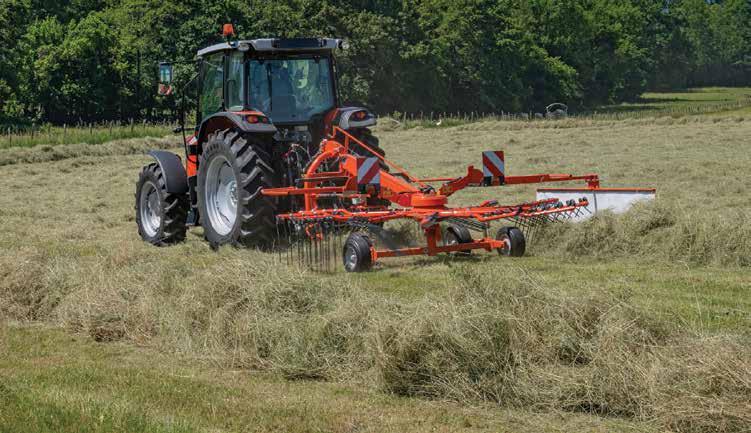







Page 2 • Dairy Star • Saturday, May 11, 2024
views
opinions expressed
Dairy Star columnists and writers are not necessarily those of the Dairy Star / Star Publications LLC. The Dairy Star is published semi-monthly by Star Publications LLC, 522 Sinclair Lewis Ave., Sauk Centre, MN 56378-1246. Periodicals Postage Paid at Sauk Centre, MN and additional mailing ofces. POSTMASTER: Send address changes to Dairy Star, 522 Sinclair Lewis Ave., Sauk Centre, MN 56378-1246. © 2023 Star Publications LLC
Letters
articles
opinion are welcomed. Letters must be signed and include address and phone number. We reserve the right to edit lengthy letters. The
and
by
Con nued from GRILLED CHEESE | Page 1 Turn to GRILLED CHEESE | Page 5 Invest in Quality ® www.kuhn.com Visit your local KUHN Hay & Forage dealer today! Farmers’ Implement Allenton, WI D & D Farm Supply Arcadia, WI Cherokee Garage Colby, WI Beaver Machine Coleman, WI Kalscheur Implement Cross Plains, WI Eron Equipment Junction City, WI Luxemburg Motor Co. Luxemburg, WI Riesterer & Schnell Shawno, WI Lulich Implement Mason, WI Lindstrom Equipment Menomonie, WI East Side Farm Equipment Monroe, WI Steinhart Farm Service Platteville, WI
Gruett’s Inc. Potter, WI
Gibbsville Implement Waldo, WI
Midwest
New
WI GA 4201 & 4401 | Single-RotorRotary Rakes 13'9" and 14'5" working widths • mounted models
, FLUFFY WINDROWS
Carl F. Statz & Sons Waunakee, WI
Machinery Co.
Richmond, WI Osceola,
UNIFORM
Pivoting headstock allows for greater maneuverability in tight corners
consistent windrows for fast drying
Right-hand delivery maximizes
ABBY WIEDMEYER/DAIRY STAR
Robert Jake and his assistant, Pa y Wember, prepare their entry April 20 at the Wisconsin Grilled Cheese Championship in Dodgeville, Wisconsin. Jake rst entered the compe on in 2016 and this year won third place.
maple-glazed





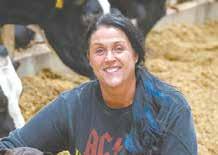
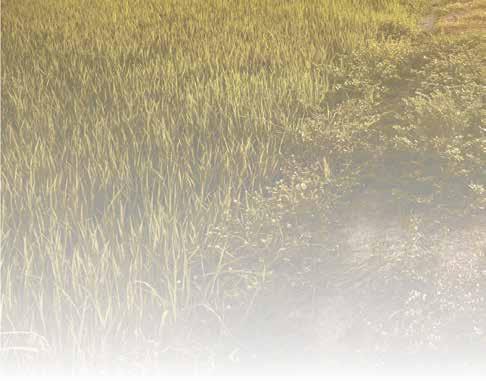



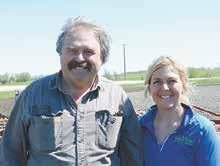
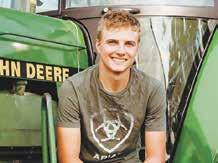
















For additional stories from our other zone, log on to www.dairystar.com Dairy Star • Saturday, May 11, 2024 • Page 3 The Day That Went Awry Second Section: Page 8 Blair, WI Metcalfs double herd size in 7 years on farm built from scratch First Section: Pages 1, 6 - 7 Milton, WI A day in the life of the McManama family Second Section: Pages 12, 14 - 15 Watertown, WI What are the best aspects of being a mother and dairy farmer? First Section: Pages 15 -16 FROM OUR SIDE OF THE FENCE: Inside the Emblem: Lancaster FFA Chapter Third Section: Pages 8 - 9 Lancaster, WI Women in Dairy: Amy Penterman First Section: Page 32 Thorp, WI Chapter closes at the Great Northern Land, Cattle Company First Section: Pages 12 - 13 Fond du Lac, WI Colby FFA dominates state dairy judging contest First Section: Page 25 Colby, WI Wisconsin Grilled Cheese Championship honors dairy industry for 11th year First Section: Pages 1 - 2, 5 Dodgeville, WI Columnists Ag Insider Page 10 First Section P Fir Fi s Ramblings from the Ridge Page 36 First Section R f Fi The “Mielke” Market Weekly Pages 6 - 7 Second Section Veterinary Wisdom Page 37 First Section Vet V W Pa Firrs From the Zweber Farm Page 38 First Section F Zwe P Fir Country Cooking Page 22 Second Section y n C C P The NexGen Page 39 First Section Celebrating PDP’s Cornerstone Dairy Academy graduates First Section: Page 26 - 27, 29 Baraboo, WI Zone 2 Zone 1





































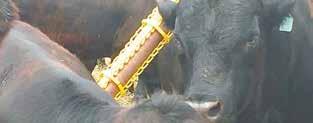














Page 4 • Dairy Star • Saturday, May 11, 2024 FOR MORE INFO - CONTACT ONE OF THESE DEALERS... Lang’s Dairy Equipment, Inc. 2337 Millennium Rd. • Decorah, IA 52101 (563) 382-8722 295 East Main Street • Lewiston, MN 55952 (507) 452-5532 Precision Dairy Equipment 24548 IA-13 • Elkader, IA 52043 (563) 245-2560 Tri-County Dairy Supply, Inc. 4107 N US HWY 51 • Janesville. WI 53545 608-757-2697 Bob’s Dairy Supply 540 E. County Rd. A • Dorchester, WI 54425 (715) 654-5252 Eastern Iowa Dairy Systems 105 3rd Ave. NW • Epworth, IA 52045 (563) 876-3087 Farm Systems 58 Interstate Drive • Melrose, MN 56352 Brookings SD • (320) 256-3276 Leedstone 222 E Co Rd 173 SE, Melrose, MN 56352 (877) 608-3877 24260 Cty. Rd. 27 • Plainview, MN 55964 (800) 548-2540 1720 Freitag Dr. • Menomonie, WI 54751 (866) 467-4717 2580 9th St. E. • Glencoe, MN 55336 (877) 864-5575 Fuller’s Milker Center, LLC 423 U.S. 61 • Lancaster, WI 53813 900 US Hwy. 14 West • Richland Center, WI 53581 (800) 887-4634 Gorter’s Clay & Dairy Equipment 1400- 7th St. SE • Pipestone, MN 56164 (507) 825-3271 Redeker Dairy Equipment W12287 Liner Rd. • Brandon, WI 53919 (920) 346-5576 United Dairy Systems 210 N. Industrial Pkwy • West Union, IA 52175 (563) 422-5355 132 W 11th St. • Monticell, IA 52310 (319) 465-5931 Advanced Dairy LLC 9 State Rd. 29 • Spring Valley, WI 54767 (715) 772-3201 913 W. Main St. • Mondovi, WI 54755 (715) 926-5777 967 West Ave. N • West Salem, WI 54669 (608) 633-6690 2195 Hwy. 23 • Mora, MN 55051 (715) 772-3201 117 West Circle Dr. • St. Charles, MN 55972 (507) 932-4288 1449 Homecrest Ave SE • Wadena, MN 56482 (218) 632-5416 Ask us about our Farm Services EXCHANGE Programs… Liner, Claw, Pulsator and Activity Exchanges. Economical ways to keep your equipment updated and running optimally! IPS-8 NC VENTED SILICONE LINER! NEW 8,000 Milkings! It’s nally here! • Durable and extended life • Cow comfort and speed of milking • Better teat health and higher quality milk • Extended life “The IPS-8 NC liner has completed 8,000 milkings with no issues. We cannot say that about any other liner we have used. It’s a one-piece liner made of a simple design, it cleans well and stays clean throughout the milking process.” - Eric Van Nurden, Van Nurden Farm LLC, Rice, MN FAST, SAFE, CLEAN MILKING LIVESTOCK PEST CONTROL SYSTEM SELF-TREATING • Adaptable to any operation - 34.5”/ 7 gal. or 69”/14 gal. - customized sizes too! • Easy to install & maintain • No valves or pumps to malfunction • Affordable • Durable construction • No pesticide waste • Patented WIK Applicators BUZZ OFF PROVEN, EFFECTIVE FLY CONTROL The Buzz-Off System comes with a spray arm that applies a broad spray pattern of product through a photo-eye. The sensitivity of the photo eye controls the amount of product sprayed. The Buzz-Off System comes with an automatic 7 day / 24 hour timer…it also can be manually programmed to dispense product up to several times per week and different times of the day! • Oil based formulation • Adheres and endures • Cost Effective • Safe for cow & environment • Ready to use thick or thin For use with AERO-MAX Synergized Insecticide 1% Permethrin 1% Piperonyl Butoxide (for resistance control) Automatic Fly Control System NG s TEM o pl on cators Leon Shirk Equipment N14725 Badger Ave. • Abbotsford, WI 54405 • 715-223-2239 Lots of Haying & Tillage Equipment TONS OF USED MACHINERY PARTS Brillion 38’ X-Fold packer crowsfoot rolls - $8,900 Brillion 28’ X-fold packer solid rolls - $15,500 Sunflower 5035 field cult. 5-bar spike w/rolling baskets, very nice, low acres! - $27,500 Kuhn MM900 merger, 30’, continuous pickup - $29,500 Agri-Metal 5600 bale grinder w/blower - $12,000 CIH 600 blower 540 pto, low wear! nice - $3,500 JD 512 5-shank disc ripper $7,900 NH 790 chopper w/890W hay head - $5,900 JD 714 9-shank disc chisel $6,900 Kuhn Knight PS150 vertical beater spreader $28,500 (2) H&S 7+4 Twin auger chopper boxes, 18’, tandem, good shape - $10,500 Dion F41 chopper w/9’ hay head - $24,500 Oxbo 334 merger continuous pickup, 2 pt. hookup $42,500 Ficklin CA15000 grain cart corner auger, nice - $13,750 (2) JD 726 soil finishers, 24’ w/5-bar spike, hyd. disc gangs, tandems, good shape - $26,500 Hyd. Squeeze cattle chute, good shape - $7,400 Teagle 8080 bale grinder w/blower - $11,500 NH FX45 chopper 4x4, non-running, as-is- $12,500 Glencoe 7-shank disc chisel $3,900 JD 7810 tractor 12K hours, runs good - $42,500 ‘20 Kubota BV4160 round baler 4x5 net wrap $21,500 NH 313 discbine 13’, rubber rolls - $21,500 IH 415, 24’ Cultimulcher, solid rolls - $15,500 Miller Pro 5300 18’ chopper box, tandem - $15,000 Gehl 600 12-wheel rake, hyd. fold - $5,900 JD 9650 combine 4x4, 3800/2500 hrs., 30.5x32, bin ext. - $38,500 NH 316 discbine 16’, rubber rolls - $27,500 MIller Pro 1060 blower, 1000 RPM, gear box - $3,900 Sukup 10’ No-till drill w/grass - $10,500 MIller Pro 5300 forage trailer truck tires, good shape $24,500 CIH 8010 combine 4x4, duals, weathered appearance $29,000
Kwik Trip donuts for the bread lled with bacon and cracked pepper cheddar cheese from Gile Cheese in Cuba City. He said the inspiration came to him a couple of weeks before the event.
“I’m not saying it was alcohol induced, but I’m also not saying it wasn’t,” Washa said.
The donut grilled cheese won second place this year.
Another contestant, Robert Jake, said the competition is about more than just cheese for him.
“I rst entered my wife into the competition in 2016,” Jake said. “She was so mad that I signed her up, but then she won third place, so she kept competing.”
Jake’s wife has since passed away, so he continues to compete in her honor using her recipe. He uses Texas toast, a butter and mayonnaise combination, lobster, Old Bay Seasoning and gouda cheese. The sandwich earned him third place this year.
The competition holds a special category for rst responders. The winner of this category receives a traveling trophy that stays in the winner’s station for the year and a $75 cash donation to the station.
Vondra said they are looking for more competitors in that category.
“We only had one rst responder who competed this year, so no award was given out,” Vondra said. “We thought about opening it up to different areas to make it more like a hero category, but right now, it’s just rst responders.”
The event also hosts food trucks and local vendors, a bloody mary bar and a beer garden featuring Spotted Cow.
There is also a family area where kids can get their faces painted and play. Vendors grew from 12 last year to
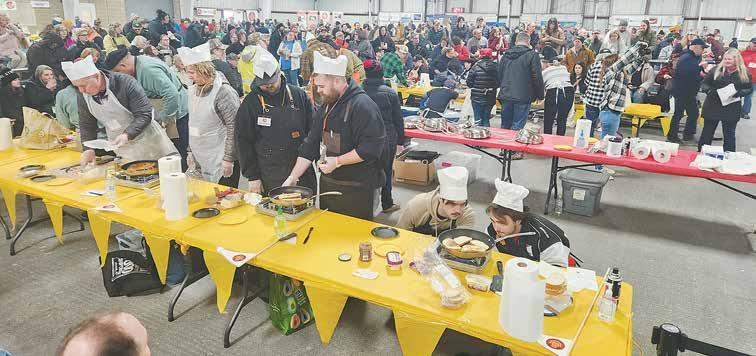
ABBY WIEDMEYER/DAIRY STAR
The 2024 Wisconsin Grilled Cheese Championship hosted 1,300 volunteers, contestants, judges and a endees from across the United States for its 11th annual contest. The compe on is hosted by the Dodgeville Area Chamber of Commerce with a mission to honor Wisconsin dairy farmers.
17 this year. They sell wares like baked goods, artisan cheese, homemade candles, Wisconsin apparel and more.
Vondra said that while attendance has remained steady, the event has grown in competitors and reach.
“It’s really special because the number of contestants and the number of sandwiches have grown so attendance might be similar but the number of people participating has grown,” Vondra said. “It’s super fun because this event is not just for people from Wisconsin; it brings in people from all over the United States. One of our contestants grew up in Highland, but he lives in Hollywood, California, and competed this year.”

Attendees also traveled from Maryland, Florida, Iowa, Illinois and Ohio.
Vondra said that prior years have presented weather challenges, but it is something they can always work around. The event is indoors but not heated. Food trucks are parked by open garage doors so the outside air does get in.
The Dodgeville chamber is already planning for the April 26, 2025, event.
“It’s really an amazing event and something that we like to host because it does bring in so much tourism to our area,” Vondra said. “It’s people coming from outside Wisconsin to experience the wonderful cheeses and different dairy products that we have.”

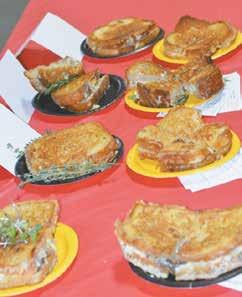
this year.



Dairy Star • Saturday, May 11, 2024 • Page 5 03 May, 2021 8:30am WORKWITHTHEEXPERTS WORKWITHTHEEXPERTS PROFESSIONALLYINSTALLED.PROFESSIONALLYSERVICED. PROFESSIONALLYINSTALLED.PROFESSIONALLYSERVICED. ZUMBROTA,MNRENNER,SD MENOMONIE,WI KAUKAUNA,WIWESTON,WI 920-759-9223715-298-6256715-235-5144 507-732-4673605-274-3656 WWW.MIDWESTLIVESTOCK.COM MEADOWVALEDAIRY-DOUBLE41WITHSCRMETERSANDINDIVIDUALID’S COMPLETELINEOFDAIRYHYGIENE&SUPPLIESFORYOUROPERATION! Con nued from GRILLED CHEESE
| Page 2
ABBY WIEDMEYER/DAIRY STAR
Sandwiches wait for judging April 20 at the Wisconsin Grilled Cheese Championship in Dodgeville, Wisconsin. The annual compe on hosted 30 compe tors who made 70 varie es of sandwiches

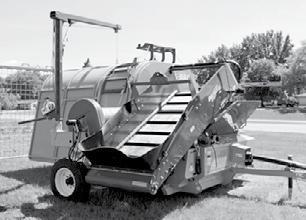


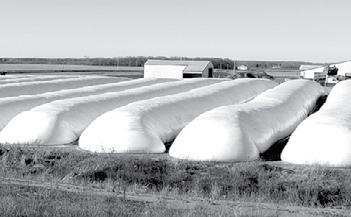


Cows are milked in a double-12 parallel parlor April 18 near Milton, Wisconsin. The Metcalfs began milking three mes a day in November 2023.
Glacier Edge Dairy had the potential to grow, and within six years, the Metcalfs were ready to double the size of their herd.













“We had 700 cows in mind when we built this setup to make it cost-effective,” Corey said.
Corey and his wife, Kristen, farm with his parents, Terry and Jane. Corey’s sister, Lauren, also helps on the farm along with eight full-time and several part-time employees. A focus on production and type has brought success to the Metcalfs, who milk 750 cows and farm 1,200 acres near Milton.
In a recent expansion, the Metcalfs built the second half of their freestall barn while doubling the size of their herd. They also adjusted the milkhouse to allow for direct shipping and switched to milking three times a day.
“Milking three times a day allows us to direct ship our milk and makes better shifts for our employees,” Kristen said. “They were going back and forth for morning and evening milkings. But now, we run two 12-hour shifts. It’s also nice having people here 24 hours a day.”
Kristen said. “We also hired more people when adding that third milking.”
Cows are milked in a double-12 parallel parlor, which has room to expand to a double-16. The herd’s 2023 lactation average was 23,087 pounds of milk, 1,043 pounds of butterfat and 825 pounds of protein on a mature equivalent basis.
The addition also includes a separate pen for Kristen’s 30 Holsteins and Red and Whites, which now have bigger stalls. Kristen and her sisters show at local, state and national shows.
Built with a focus on cow comfort, the cross-ventilated barn features 2-row pens to provide extra bunk space.
“We really like the cross-vent for keeping ies out and preventing things from freezing in winter,” Corey said. “This system provides a consistent climate year-round.”
Cows are bedded with sand. However, they do not lie on deep sand beds.
“It’s unique in that we have mats in the stalls with 3-4 inches of sand on top,” Corey said. “That cuts our sand usage in half, and it feels just as comfortable.”
Robotic feed pushers and cow brushes are other amenities for the barn.










The barn addition was completed October 2023, and the family began milking three times a day in November. Between December and February, they freshened 250 rst-calf heifers, and now, 55% of the herd is rst-lactation cows.
“It was a big winter of change,”
“The brushes keep the cows very clean,” Corey said. “They have really nice hair coats.”



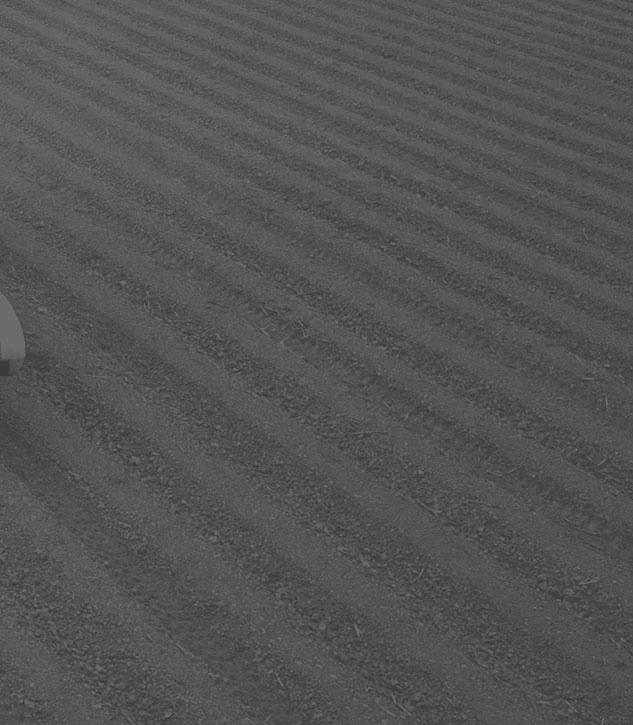
Page 6 • Dairy Star • Saturday, May 11, 2024 The World’s Best TMR Processor Keep your cattle happy & healthy with a great TMR mix. A Supreme vertical mixer is powerful, thorough & accurate, providing the best TMR mix on the market. Unlike other mixers, a Supreme is built to last, providing exceptionally accurate mixes throughout its entire life. With proper care & maintenance, a Supreme will offer the same great mix from the first cow to the last - Guaranteed. 600T, 900T, 1200T & 1500 Triple IN STOCK! 920-853-3516 Potter, WI 920-477-5292 Eden, WI 920-324-3597 Waupun, WI 920-261-5301 Watertown, WI WEaupunquipment g A 1250TTM Gen !!! In Stock & Ready To Go! Electronic Dairy Board Repair Service Specializing in: WestfaliaSurge, BouMatic, & DeLaval pulsators & Takeoffs, circuit boards, Mueller milk tank circuit boards. Call: (c) 406-590-7764 www.circuit xer.wixsite.com/ boumaticboardrepair Repair vs. Replace SAVE INSTANTLY Planting is in full swing in some areas, and so are our tire deals. Firestone Ag radial tires with Advanced Deflection Design (AD2) technology are IF- and VF-designated tires that can carry more load at the same pressure (up to 20% or 40% respectively) as standard radial tires for a larger footprint that helps minimize compaction. Through May 31 save on eligible AD2 radial and non-AD2 radial tires at your local Firestone Ag Dealer: SPRING SAVINGS FOR YOU ON 2 OR MORE FIRESTONE AG RADIAL TIRES $200 off all eligible non-AD2 radial tires $300 off all eligible AD2 radial tires Friedrich’s Tire & Oil – Sauk Centre, MN • (320) 316-3701 Rule Tire & Auto – Willmar, MN • (320) 403-2783 www.LangeAgSystems.com Specializing in Livestock Equipment and Construction, New and Used Bagging Machines, Silage Bags, Bunker Covers and Grain Storage! Con nued from METCALFS | Page 1
STACEY SMART/DAIRY STAR
to METCALFS | Page 7
Turn

The Metcalfs also plan to add a hoof trimming area to the new part of the barn to trim more efciently.
“I appreciate how quiet the barn is,” Kristen said. “We focus on cow comfort in everything we do, and the cows are happy.”
The family added on to their milkhouse and removed the 5,000-gallon bulk tank, replacing it with three ports for shipping milk. The family ships to Rolling Hills Dairy Producers Cooperative, sending one truckload per day, or about 50,000 pounds of milk.
“It made it more efcient with the economy and trucking situation to go to direct shipping,” Corey said.
Corey’s roots are in dairy, as his father grew up dairy farming and continued milking cows with his two brothers until 1997. Corey was 6 years old when the cows left.
“Our family farmed a lot of grain acres and decided to focus on that instead,” Corey said. “I always had a greater interest in livestock production. Instead of selling grain, I wanted to make feed and feed it ourselves.”
At age 14, Corey began working on dairy farms. He was exposed to the Jersey breed while helping on a neighbor’s farm. It was here that he also met Kristen, who worked there as well.
“I was really focused on genetics
from the start,” Corey said. “Every calf here is genomically tested, and we’ve used sexed semen and beef semen from the beginning.”
The parlor records milk weights, which Corey nds helpful for identifying replacements.
“We’ve done quite a bit of ushing and in vitro fertilization since we started,” he said. “We identied a couple of good families right away, and we tried to make as many daughters as possible.”
Since the farm’s inception, the Metcalfs have tested milk and classied. They also participate in the American Jersey Cattle Association Registration, Equity, Appraisal and Performance program.
“The Jersey association has been really great to work with in helping us nd cows,” Corey said. “We bought a lot through them.”
Creating well-balanced, long-lasting cows is the goal of Corey’s breeding philosophy, and he selects bulls that can deliver on these traits.
“We are production-focused but also type-focused, too, and I look more at type traits than production traits when choosing bulls,” Corey said. “We’re not necessarily breeding animals to show, but we want them to be long-lasting.”
The Metcalfs have sold ve bulls to A.I. stud within the last couple of years.

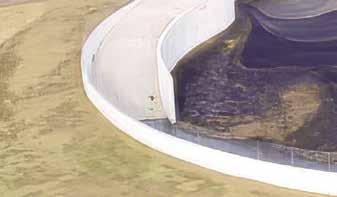

“That’s impressive because we started from the conglomeration of many herds,” Kristen said.
Previously holding a job off the farm, Kristen is happy to be on the farm full time since the expansion.
“We’re pretty fortunate with our team,” she said. “Everyone we originally started with is still here and taking over management roles.”
Corey agreed.
“Our employees have been a huge part of our success,” he said.
As this progressive couple settles into the next phase of their dairy operation, Kristen said Corey is always looking ahead and asking, “What’s next?”
“I like to think about different possibilities and plan for the future,” Corey said. “But for now, I’m content where we are.”













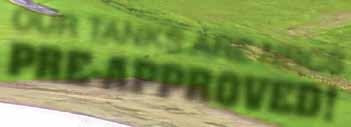


Dairy Star • Saturday, May 11, 2024 • Page 7 THE NATION’S LEADER IN AGRICULTURAL CONCRETE (920) 948-9661 | www.pippingconcrete.com dennis@pippingconcrete.com 37+ years in business | U.S. Navy Veteran owned dennis@pippingconcrete.com Con nued from METCALFS | Page 6
STACEY SMART/DAIRY STAR
Glacier Edge Dairy was built by the Metcalf family in 2017 near Milton, Wisconsin. In 2023, the Metcalfs built the second half of their freestall barn while doubling the size of their herd and making adjustments to the milkhouse for direct shipping.
Congratulations Metcalfs on your expansion! Janesville, WI (608) 757-2697 tricountydairysupplyinc.com Thank you for choosing us for your freestalls!
Changes to WIC disappoint dairy industry
Advocacy did not deter new USDA rules
By Jan Lefebvre jan.l@star-pub.com
WASHINGTON — In November 2022, the U.S. Department of Agriculture revealed proposed rule changes to the Supplemental Nutrition Program for Women, Infants, and Children. Many in the dairy industry were surprised and alarmed because the rule changes included a reduction in the amount of milk program participants would be allotted.
“There wasn’t a good explanation for why USDA was working to reduce milk,” said Matt Herrick, senior vice president of public affairs and communications for the International Dairy Foods Association. “There wasn’t really any forewarning. We were surprised, confused and frustrated, and the more we talked to WIC agencies and moms who are in the program, the less we understood the proposal. It just didn’t make a lot of sense.”
felt like we were making headway — the arguments we had were factual, relevant and supported by people in the (WIC) program — but at the end of the day, the USDA still decided to reduce (the allotted amount of) milk.”
On April 9, USDA issued a nal rule, making the changes ofcial. For milk, the allotted amount per month through WIC will be reduced from 16 quarts to 12 quarts for children 12-23 months of age, from 16 quarts to 14 quarts for children ages 2-4, and from 22 quarts to 16 quarts for pregnant and breastfeeding women.
USDA’s website states what it aims to achieve through the changes to WIC.
of all U.S. production by volume.”
The 0.5% estimate is for the reduction in milk due specically to the new rules, Herrick said, but that is just part of the equation.
“That’s only if all the people who are in the program stay in the program,” Herrick said. “It doesn’t account for people leaving WIC if they are dissatised with this rule.”
counterproductive to USDA’s efforts to increase the number of eligible families who enroll. According to USDA statistics, only half of those eligible for WIC apply for the program.
For making changes to WIC rules, the USDA said on its website that it relied on research from the National Academies of Science, Engineering and Medicine. It also used research from the National Institute of Medicine which suggested increasing access to fruits and vegetables within the program, leading to a reduction in access to milk.





“The changes will provide WIC participants with a wider variety of nutritious foods to support healthy dietary patterns and accommodate special dietary needs and personal and cultural food preferences,” USDA said. “The revisions provide foods in amounts that are more consistent with the supplemental nature of the program, encourages fruit and vegetable consumption, and strengthens support for breastfeeding.”
When IDFA was advocating to deter the new rules, it interviewed moms in the WIC program and sent videos of those moms talking about their experiences with WIC to the USDA and Congress. IDFA found that many moms were enrolled in WIC specically for access to milk and were not happy about the new rule.
“What we learned is that there are a lot of women in the program who may just leave it because they are in it for milk,” Herrick said. “If the amount of milk they are used to receiving is no longer there, why participate, why give all your information to the government, because it’s a very prescriptive program as it is. It’s not like (the Supplemental Nutrition Assistance Program) where you can go to the grocery store and buy almost anything you want in terms of food and beverages.”
“This seemed more like a shell game … like they were looking for some food item in (WIC) that they could reduce, whether it was fruit juices or milk, and then nd the resources to increase fruits and vegetables without needing to ask for additional funding from Congress for the program,” Herrick said. “Milk was simply the victim of looking for other alternatives to increase in the program.”
The rules come at a time when research is showing the benets of dairy consumption while also showing that most Americans do not get enough dairy in their diets.
IDFA and other groups in the dairy industry worked to deter the proposed changes.
“We felt that if we advocated enough, we could change their minds,” Herrick said. “We had a signicant and aggressive advocacy program on this that lasted more than a year. We really
Many in the dairy industry see the changes as negative for both nutrition and the dairy industry itself.
“The reduction is as much as 3 gallons per mother per month, which would be for a mother who has at least one other child and is pregnant,” Herrick said. “We estimate that’s about 150 million gallons per year, or about 0.5%


WIC enrollees are limited to a specic list of about 25 items that they are allotted through the program.
“For a lot of people, (WIC’s limitations are) generally frustrating anyhow, and with reduced milk, we believe there will be reduced participation, unfortunately,” Herrick said.
The new rules, therefore, seem
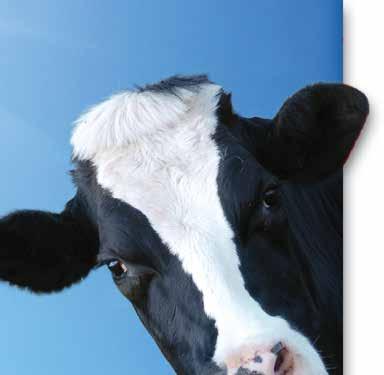

In an April 9 press release issued by the National Milk Producers Federation, Gregg Doud, president and chief executive ofcer, addressed the nutrition aspect of USDA’s decision.
“NMPF is disturbed by (USDA’s) decision to reduce access to the essential nutrients dairy adds to the diet,”



















Page 8 • Dairy Star • Saturday, May 11, 2024
BONGAR D S’ STORE 16th anniversary Celebration JUNE 19, 2024 11am-2pm Free fried cheese curds & soft serve ice cream! Face painting spinning wheel Balloon Man Sign up for prizes! Music by Nick Stadick Bring the kids to see sic Stadick g th gthe he 13200 Co. Rd. 51 Norwood, MN 952-466-3545 www.bongards.com Joın the fun! CELEBRATING DAIRY DAYS &
Turn to WIC | Page 11
Matt Herrick International Dairy Foods Association
vast majority of positive polymerase chain reaction results were found in samples of raw milk and mammary gland tissue.
“It seems like the virus is actively replicating in the mammary gland tissue based on the results we have,” Diel said. “Is there an infectious virus being shed in milk from those affected animals? The answer to that is, yes. The milk samples contain high viral loads in clinically affected animals and can serve as a source of spread to other animals.”
In an April 26 webinar hosted by the University of Minnesota Extension and the Minnesota Board of Animal Health, Dr. Joe Armstrong, UMN Extension, said that while the majority of affected dairy cows tend to be multiparous cows in mid-to-late lactation, the virus has been seen in other populations in affected herds.
“It is important to look at all animals in the herd and monitor them for symptoms,” Armstrong said. “Symptoms in individual cows are lasting about 3-5 days. Herds appear to be impacted for 14-21 days before returning to near normal feed intake and milk production.”
In addition to the rst-reported symptoms that included decreased feed intake, rumination and milk production, and abnormal milk appearance, Armstrong said that some cows present with diarrhea while others present with dry, tacky feces as a result of dehydration. Fever, clear nasal discharge and lethargy have also been reported among affected cows.
Armstrong said on average, about 5% of the cows in affected herds present with clinical symptoms. The only treatment for infected cows is supportive care.
According to a USDA press release, on April 16, Animal and Plant Health Inspection Service microbiologists identied a shift in an H5N1 sample from a cow in Kansas that could indicate that the virus has an adaptation to mammals. Based on their analysis of that specimen sequence, the Centers for Disease Control and Prevention has not changed its overall risk assessment for the general public, because the substitution has been seen previously in other mammalian infections.
In the UMN Extension webinar, Dr. Stacy Holzbauer, the CDC’s epidemiology eld ofcer for the Minnesota Department of Health, detailed concern surrounding the control of H5N1, which prompted the issue of the federal order.
“This particular virus is an inuenza A virus, which is circulating in wild birds,” Holzbauer said. “They are constantly changing. Inuenza A virus widely circulates in humans, wild birds, domestic birds, swine and equine. But all of these viruses, including the seasonal inuenza viruses we get vaccinated for every year, have an origin in wild birds at some point in time.”
Holzbauer said these viruses have epidemic potential because they are constantly changing and exchanging genes with other viruses. The virus can mutate and infect other species.
“The concern is that we have more mammal-tomammal spread, that this virus may mutate to where it can then spread to people more easily and then spread person to person,” Holzbauer said. “That is why we are very interested in what is happening in both our poultry and dairy industries. We have people and animals in the same environment working together. The fear is we will have a person who is infected with a human seasonal inuenza virus and then also happens to get infected with the avian H5N1 virus and those two viruses essentially swap their genes. Then, we have this new human virus that could circulate person to person.”
According to Holzbauer, avian inuenza viruses are typically spread to people through direct contact with infected birds or their environment.
“Person-to-person spread of these viruses is rare and limited,” Holzbauer said. “We expect there to be occasional spillover for the people who have direct contact, especially with poultry, but we don’t see person-toperson spread. So, it’s not a risk to the public, and it’s not a food safety risk either.”
Based on what they have learned through avian inuenza infections in domestic poultry ocks, Holzbauer said the response to monitor people having direct contact with infected dairy cattle would be to initiate active surveillance for 10 days after the cows on the affected dairy farm have recovered from clinical signs.
Holzbauer said the use of personal protective equipment by people working with infected animals is their best defense to avoid infection from the H5N1 virus.
“Our PPE recommendations for people working on dairy farms in direct contact with ill cattle are gloves, goggles, N95 masks, coveralls and boots,” Holzbauer said. “We know these PPE recommendations are difcult in operations where these are not normal types of PPE.”
The key message is to protect mucus membranes — eyes, nose and mouth — to prevent uids that may be carrying the virus from entering the body through these access points as much as possible.


THE NO COMPROMISE FABRIC STRUCTURE DAIRY, MACHINERY & HAY STORAGE

NELSON’S AGRI STRUCTURES

The FutureCow® Prep System features a mechanical brush unit that gently washes, disinfects, stimulates and dries all in one visit to the cow.
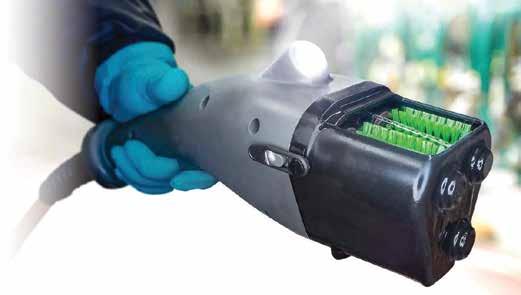

Dairy producers can potentially reduce labor costs and can certainly reduce operating costs by eliminating towels and laundry.
Streamlined and consistent cow prep — allows for a more efficient parlor and greater parlor labor productivity — even increasing the number of cows milked per hour.
Superior udder stimulation — can increase milk flow rates and decrease milking times, further improving parlor throughput.
Improved teat health and milk quality — the durable, yet soft, multi-layered brushes accommodate all teat lengths and ensure teat-ends are properly cleaned before the milking unit is applied.
FutureCow Blending Devices
Fixed cost for pre-milking prep — flat rate per cow pricing provides consistent and easily managed cost.
A system for all herd sizes — whether you milk 50, 500, or 5,000 cows or more, there is a FutureCow® Prep System to accommodate any herd size.
Installed and supported by GEA dealers — a professional network with unsurpassed dairy equipment experience available 24/7.
GEA now offers three different automated blending systems to blend cleansing solution ingredients with water to create a ready-to-use (RTU) product that cleans and disinfects the teats.
FutureCow Air-Operated Pump
The pump delivers product from the blending system to the FutureCow Control and Brush Unit.
FutureCow Control and Brush Unit
Controls the dispensing and use of the solution.
Dairy Star • Saturday, May 11, 2024 • Page 9
Dairy EquipmentService & Installation Electrical Services
Dean Nelson • Central and Northern Minnesota • Grove City, MN •
US
75 At IA/MN Stateline • Steen, MN •
320-857-2633, Cell 320-699-3297 RIVERSIDE HOOP BARNS, INC.
Hwy.
507-392-2870 • Fred A. Tilstra & Sons
Steel Tubing Supplied by Allied Tube & Conduit Heaviest gauge steel in the industry Pre-engineered truss buildings ASK US ABOUT GOVERNMENT FUNDING FOR HAY STORAGE WE ALSO SELL REPLACEMENT TARPS! LAKESIDE HOOP STRUCTURES, LLC Eastern Minnesota and Wisconsin • Harris, MN • 651-248-6302 • Craig Moline SKIDLOADERS TRACTORS BACKHOES EXCAVATORS & BULLDOZERS joewelcheq.com 507-724-3183 Here Today. Gone Tomorrow. Give Classieds a try. Con nued from H5N1 | Page 1
Commercial Agri Buildings Single and Truss Arch available from 20’-120’ wide Flo-Coat® Galvanized

Stabenow unveils her farm bill
Animal and Plant Health Inspection Service has at this point is only positive in dairy cows,” Lester Moftt said. “As we do more mandatory testing and gather more information, hopefully, we will be able to get a better understanding of what’s happening across the landscape in other states and across livestock.” Lester Moftt emphasized there is no evidence of a live virus in pasteurized milk. Cooking ground beef to the proper temperature is also recommended.
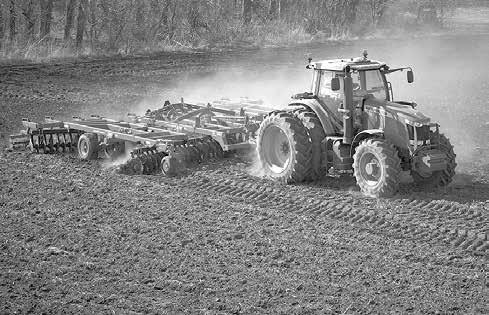
Chairwoman of the Senate Committee on Agriculture, Nutrition & Forestry Sen. Debbie Stabenow said it must be a bipartisan bill to get a farm bill done. When unveiling her farm bill plan, the Michigan senator said she had three major goals: keeping farmers farming, families fed and rural communities strong. The bill enhances crop insurance “for small farmers, for specialty crops as well as large farmers.” The commodity title includes a minimum of a 5% reference price increase for all crops. Traditionally, dairy policy is in the crosshairs during a farm bill debate. Stabenow took steps to strengthen the dairy titles. “The Dairy Margin Coverage program seems to have worked really well,” Stabenow said. “The biggest concerns we heard about was with smaller farms; they go to tier 1 basically.”


Hesston 565A Round Baler
‘20 MF 3983 Hicap Rake, 12 wheel
‘19 Kuhn GA7501 Rotary Rake
‘22 MF 1393, 13’ Disc/Mow Cond. ‘16 Pottinger NovaCat Triple Mower w/rolls
‘17 JD 835 9’ MoCo, center pivot
‘14 CIH DC112 Disc Mow/Cond. Gehl 2450, 15’ hydro swing
JD MX7 3PT Brush Mower Patz Bale Chopper
‘21 Rhino 3150-15’ Batwing Mower
‘20 Rhino TS12 flex wing mower
‘23 NH 313 plus 13’ disc mower cond
‘22 MF 4707, MFWD, MF ldr., Only 520 hrs. ‘21 MF 2850, CAH, hydro, loader, ONLY 139 HOURS!
IH 966, 9,000 hrs. MF GC2400, 60” deck, 600 hrs. ‘21 MF GC1723, ldr., mower, 180 hrs. JD 2640 w/146 loader JD 2940, WF MF 285 w/246 loader
700 hrs.
‘23 Bobcat T770, high flow, 114 hrs., LOADED!
‘22 Bobcat T770, 200 hrs.
‘20 Bobcat T770, 240 hrs.
‘21 Bobcat T770, highflow, 958 hrs.
‘19 Bobcat T770, SJC, 500 hrs.
‘20 Bobcat T770, CAH, highflow, SJC, 765 hrs.
‘20 Bobcat T770, SJC, 300 hrs.
‘18 Bobcat T770, SJC, 2,400 hrs.
‘18 Bobcat T770, A91, highflow, SJC, 2,000 hrs.
‘21 Bobcat T770, 165 hrs ‘07 Bobcat T300, CAH, SJC, 1,900 hrs.
‘18 Bobcat E50 long arm, 700 hrs.
‘14 Bobcat S770, 3,200 hrs.
Bobcat S300, 4,200 hrs.
S650, 9,000 hrs.
Bobcat S590, 3,900 hrs.
Bobcat S570,
 By Don Wick Columnist Ag Insider
By Don Wick Columnist Ag Insider
Farm bill on the way to the House Ag Committee
House Committee on Agriculture Chairman Glenn “GT” Thompson will mark up the farm bill May 23. After the release of Thompson’s bill Wednesday, ranking member David Scott rejected the proposal saying it includes poison pill policies with “an untenable funding scheme.” In a briefing with farm broadcasters, Thompson said that complaint is disingenuous. In a brieng with farm broadcasters, the Pennsylvania lawmaker said he is willing to pass the farm bill out of his committee with just Republican votes. “I’ve got a number of different options of getting to the House oor,” Thompson said. “The process through the House has yet to be determined, but I’m condent that I will nd a successful pathway.”
Congressional calendar complicates farm bill timeline
National Council of Farmer Cooperatives President and CEO Chuck Conner has seen his share of farm bills and said this is the most partisan farm bill he has ever seen. Conner, who was the U.S. Department of Agriculture deputy secretary during the George W. Bush presidency, said this farm bill process needs to start. “Even if it’s a partisan process, get a bill that people can begin to look at, start marking it up in committee, and get us started,” Conner said. “You can’t nish something that never starts, so we’ve got to start.” Timing is critical for this important piece of legislation. “Congress is in session so few days between now and the end of the year; it’s a presidential election year, you’ve got party conventions, and they’re never in session during any of those kinds of periods,” Conner said. “It’s just going to be hard to get done with the farm bill.”
Bipartisanship is a farm bill must
With the hyper-partisan environment in Congress, it is difcult to nd compromise on any piece of legislation. American Farm Bureau Federation Director of Government Affairs Joe Gilson said compromise is a must for the farm bill. “In the House ag committee, if we have a party-line vote, I think it’s going to be very difcult for Speaker Johnson to even bring it to the House oor,” Gilson said. “The Republicans have a majority of one, two or three seats depending on the day. A bipartisan bill will be essential to get this across the nish line in the House.”
H5N1 in beef?
The H5N1 virus has been identied in dairy cattle in nine states. USDA limited the interstate movement of dairy cattle and implemented mandatory testing. In a meeting with farm broadcasters, USDA Under Secretary for Marketing and Regulatory Programs Jennifer Lester Moftt was asked if it was safe to assume the virus is also in the beef herd. “The information and data that
New traceability rule announced
USDA’s new standard for traceability in cattle is electronic ID tags. This replaces the 2013 rule that called for visual ID tags. In a statement, USDA said the decision was being made to respond quickly to foreign animal diseases. This rule applies to sexually intact cattle 18 months of age or older, rodeo and exhibition cattle, and dairy cattle moving interstate.
Ag industry responds to USDA announcement
A statement released by National Milk Producers Federation President and CEO Gregg Doud said USDA’s action on testing and interstate movement of dairy cattle is appropriate. Doud also stressed milk is safe and pasteurization leaves all viruses inactive. Meat Institute President and CEO Julie Anna Potts also released a statement, saying properly prepared beef remains safe to eat. The Meat Institute also called on the USDA and the Centers for Disease Control and Prevention to ensure the movement of healthy animals to slaughter.
Enough is enough
A coalition of 16 farm groups has launched the Enough is Enough Tour to protest commodity research and promotion checkoff programs. This coalition claims the checkoff programs work against the interests of the farmers who pay into the program. The tour will be making a stop in Osseo, Wisconsin, May 22. The state event is hosted by the Wisconsin Farmers Union.
El Nino is fading fast
Long-range forecasts are leaning toward a drier summer. “Some of that has to do with the transition from El Nino to La Nina which is happening as we speak,” said Brad Rippey, USDA meteorologist. “El Nino is fading fast, and La Nina’s on the way; that tends to be a drought maker for the country as a whole. Perhaps as early as this summer, we’ll see drought encroaching from the West back across the Great Plains.”
Dairy ambassadors coming to Wisconsin State Fair
A new state fair dairy promotion opportunity has been announced. The Wisconsin State Fair Dairy Promotion Board is adding Dairy Lane Ambassador positions. These individuals will be trained in networking, public speaking, social media and more. The goal is to enhance the dairy experience for fair-goers. The ambassadors will receive training, a stipend, food and lodging during the Wisconsin State Fair.
Trivia challenge
The Ayrshire breed originated in Scotland. That answers our last trivia question. For this week’s trivia, what has been the best-selling pickup truck in the U.S. for nearly 50 straight years? We will have the answer in our next edition of Dairy Star.
Don Wick is owner/broadcaster for the Red River Farm Network of Grand Forks, North Dakota. Wick has been recognized as the National Farm Broadcaster of the Year and served as president of the National Association of Farm Broadcasting. Don and his wife, Kolleen, have two sons, Tony and Sam, and ve grandchildren, Aiden, Piper, Adrienne, Aurora and Sterling.
Page 10 • Dairy Star • Saturday, May 11, 2024 REISERIMPLEMENT Waukon,IA 563-568-4526 AfterHours: Ken563-380-3137•Dave563-380-8680 www.reiserimpl.com CHECKOUTTHE 7700SERIES Used Equipment PLANTING/TILLAGE MISCELLANEOUS TRACTORS ‘20 Kinze 3660, 16R30, bulk fill ‘12 CIH 1250, 16R30, bulk fill ‘97 Kinze 2600, 31R15” DMI 530B Disc Ripper CIH MRX690, 5 shank disc ripper disc JD 980 Field Cult., 44’ w/harrow CIH 4800 30’ Field Cult, w/3 bar coil tine harrow BUILT TO KEEP GOING. BECAUSE A FARM NEVER SLEEPS. Kory 185 Gravity Box, 250 bu w/gear Brent 640 Gravity Box Loftness 20’ Stalk Shredder, NICE!! ‘08 AGCO 3000 corn head, 8R30, poly JD 146 loader w/bucket Skid Loaders HAY & FORAGE ‘11 MF 8947 Telehandler, 3,000 hrs. ‘18 Bobcat 3400 SideXSide, C/H, 6,700 hrs. ‘16 Bobcat E50, long arm, thumb, 1,510 hrs. ‘23 Bobcat UW 56 Toolcat, 235 hrs., LOADED! ‘20 Bobcat V923 Telehandler, 1,100 hrs. ‘19 Bobcat E26 Mini Ex, OS,
2900 hrs. ‘13 Bobcat S570, CAH, ACS, 3,800 hrs. ‘13 Bobcat S570, CAH, 3,400 hrs. ‘15 Bobcat T550, ACS, Open Station, 1,855 hrs. ‘15 Gehl R190, 1,900 hrs. ‘13 Mustang RT2100 track ldr. 3,000 hrs ‘23 NH L318, C&H, 1,400 hrs. ‘95 Case 1840 CROPS, ONLY 2245 hrs. ‘22 JCB 409 CAH 1,786 hrs ‘21 Bobcat S76, SJC, 1,500 hrs. ‘20 Bobcat S76, 233 hrs. ‘22 Bobcat S64, 4,100 hrs. ‘21 Bobcat T76, SJC, 600 hrs. ‘21 Bobcat S76, CAH, SJC, 1,800 hrs. ‘23 Bobcat T76, 65 hrs. ‘23 Bobcat T64, CAH, 13 Hours! ‘22 Bobcat S64, SJC, 4,100 hrs. ‘21 Bobcat S64, foot, 2,900 hrs. ‘15 Bobcat T870, SJC, highflow, 1,700 hrs. tfn Les Kuehl Repair Service 30+ Years Experience No Emergency Charges--Ever! • Sealed silo parts & service • Best chains on the market • Used and rebuilt unloaders • Stainless steel roofs • Stainless steel conveyor chains 320-760-2909 Eve. 320-762-1827 YOUR CENTRAL MINNESOTA GOLIATH REPAIR SERVICE! • All parts needed to service your Goliath Unloaders Not af liated with the Harvestore brand Call for early maintenance specials Tell the advertisers you saw their ad in the Dairy Star!
‘02
‘12 Bobcat
‘16
‘20
Doud said. “Nutrition science demonstrates that dairy products like milk, yogurt and cheese are especially important for women, infants and children. Meanwhile, nearly 90% of Americans don’t meet the number of dairy servings recommended by the 2020-25 Dietary Guidelines for Americans.”
Doud also said the change is counterproductive.
“This rule works against the WIC program’s goal of ensuring all Americans have consistent and equitable access to healthy, safe and affordable foods,” he said.
Herrick said the rule change will make budgeting and shopping for food more difcult for moms in the WIC program.
“If you think about WIC moms, they are low income, and they’re likely also on the SNAP program, so they have these two supplemental programs for grocery shopping,” Herrick said. “If you’re going to use your SNAP benets for the majority of your grocery shopping, you’re going to look for items that are available through WIC that you don’t need to use your SNAP benets for.”
For many of those moms, one of those main items is milk, Herrick said.
“Now they no longer have as many benets available for that milk,” Herrick said. “For moms in particular, that’s deeply disappointing.”
The new WIC rules were not all negative for dairy.
“(USDA) did make some changes that were helpful,” Herrick said. “You no longer have to buy a big 32-ounce tub of yogurt. You can buy smaller, individualized containers that equal 32 ounces, which is how people mainly eat yogurt, or you can swap your milk for
yogurt or cheese, which is helpful to the overall dairy category.”
State WIC agencies have two years to implement the changes. In the meantime, the only remaining avenue for changing the rules is through Congressional action. Herrick said some industry organizations are already contemplating legislative recourse.
“The WIC rule demonstrates that when the government issues rules that impact our industry in some way, it’s an opportunity for us to come together and advocate, and it requires us to have our eyes and ears open to pay particular attention to the rules that impact our industry,” Herrick said.
This, he said, includes federal nutrition programs because they are vital to the industry.
“For those with low income and for kids at school, nutrition programs are often their introduction or connection to dairy products,” Herrick said. “We’ve got 30 million kids in schools getting meals every day, 6-7 million women and kids in the WIC program and 40 million people in the SNAP program. Those are all very important to our industry, to the vitality and growth of our industry, and to creating generations of dairy consumers and milk drinkers.”
Herrick said it takes work and collaboration to protect dairy.
“Anytime there’s a rule proposal out there, I encourage people to work with their associations and with their networks to advocate for whatever is in the best interest of themselves as farmers or processors or as our industry in general,” Herrick said. “It’s an important lesson that we shouldn’t take anything for granted, and we need to work hard to protect our interests.”
Accurate records that tell which cows are more profitable
How long have you been testing with DHIA?
We have been testing with DHIA since the early 70’s when my grandpa, Fred, started testing with DHIA.
What tests do you use and what do you like about those tests? We just do the milk analysis test and like to look at butterfat, protein, and somatic cell count. Our nutritionist likes to look at the sheets to see if he needs to make changes to our ration to boost protein or butterfat.

How does testing with DHIA bene t your dairy operation? DHIA bene ts our operation because of the accurate records and tells us which cows are more pro table and which cows it doesn’t pay to have in the herd. DHIA also helps with choosing which bulls to use on certain cows to improve components of the next generation of cows. I really enjoy the simplicity of getting the information. I can download the results of the tests through dairy comp to my computer to see the last test results.
Tell us about your farm. I farm with my mom, Nancy, and dad, Pat, we have 550 acres of corn and alfalfa and nish out our Holstein steers. We milk in an 85-stall tiestall barn. We also have three part-time high school kids that help.
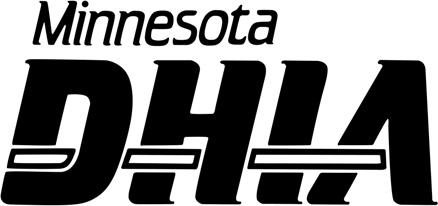






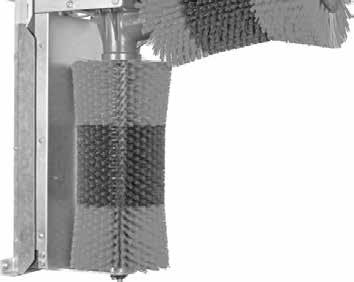


Dairy Star • Saturday, May 11, 2024 • Page 11 CENTRE DAIRY EQUIPMENT AND SUPPLY INC. Henning Area 218-849-0211 Jon Stein 320-352-5762 • 1-800-342-2697 40625 State Hwy. 28 • Just West of Hwy. 71 • Sauk Centre, MN Aaron bought the brush from Centre Dairy about a year ago and installed it himself. Centre Dairy came out later and adjusted the mount and wiring. Since then, they have had zero issues. They have 70 cows and the majority of them love the brush. Aaron spoke highly of both Centre Dairy Aaron Wiechmann Melrose, MN Improve Cow Cleanliness & Cow Comfort Call Jon today!
Con nued from WIC | Page 8
Sauk Centre, MN Buffalo, MN 763.682.1091 www.mndhia.org DHIA: Now MORE than ever
Tanner Linn (Linn Dairy Farm) Richmond, Minnesota Stearns county • 148 cows Do You Know Where Your Roasted Soybeans Come From? NOT ALL ROASTED BEANS ARE CREATED EQUAL! • Energy • Protein • Amino Acids • Bypass Protein NOTALLROAST ?? ? Make Sure You Demand The Best... KLC SOYBEANS! Our soybeans have what your dairy ration needs: Quality Consistency KLC Farms Roasting, Inc. 320-352-3326 Visit www.roastedbeans.com Preferred By Bovines Everywhere
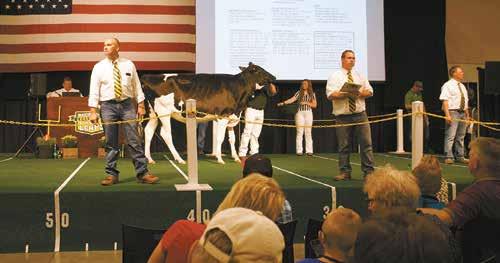
Ringmen Lynn Harbaugh (from le ), Brandon Ferry and Chad Ryan eld bids while a heifer is paraded in the ring June 29, 2019, during the Na onal Holstein Conven on Sale in Appleton, Wisconsin. Managing the sale was a highlight of Rick and Paula Bovres’ career.
which averaged $5,475 on 52 lots and auctioned a higher seller at $24,000.
The venue made it memorable for the Bovres.
“The cattle were housed on the rooftop of the convention center and were taken to the sale ring in the convention center via the service elevator,” Rick said. “This was kind of a thrill to watch and be a part of.”
The extra effort the Bovres put into their work became their trademark, shining through in each animal sold at the Great Northern.
“Every animal that went through the Great Northern was washed and clipped,” Rick said. “We appreciate how cattle look after you’ve done that; consignors and buyers do too. We’d have consignors come for the sale and say, ‘Where’s my cow?’ They almost didn’t recognize them. They change a lot after you clip and wash them and present them full of milk. You put the effort into presenting them and hope they bring the extra money.”
Thousands of dairy cattle have been struck off at the Great Northern and many are memorable, Rick said.
“A number of animals that became high-prole cows went through our sales,” Rick said. “They weren’t high prole at the time, but they became cows that impacted the breed.”
Two that come to mind for Rick and Paula are Stookey Elm Park Blackrose-ET and Wesswood-HC Rudy Missy-ET.
“It’s been interesting to watch how all that evolved, and everybody who has kicked themselves for overlooking animals like that after the fact,” Paula
said. “A lot of cows like that have gone through the ring here, but those two stick out because you see them both in so many pedigrees.”
Blackrose passed through the sale ring as a bred heifer Dec. 6, 1991, where the nal bid was for $5,400 to Mark Rueth and Mark VanMersbergen. She achieved acclaim and became a prominent brood cow in both sectors of the Holstein breed.
Selling as a 5-year-old cow, Rudy Missy’s potential attracted the attention of Matt Steiner of Pine Tree Holsteins Feb. 14, 2003. A locally bred cow, Missy was the top seller, garnering a bid of $8,100. Missy’s inuence continues across three decades.
While their role in helping breeders market the best genetics is documented, the Bovres are most proud of the role they have played in helping develop leaders throughout the industry.
“I enjoy watching these people that we had employed here as young kids,” Rick said. “There have been hundreds of young kids that have worked here over the years: clipping, washing, watching nightline and that kind of stuff. A few have turned into Klussendorf winners, have nice farms and herds of cattle now. They are the people others are wanting to hire to clip for them.”
Paula agreed. She said the relationships developed with their workforce strengthened their commitment to their work.
“It’s not only been a good place for them to practice but to learn not only about tting and caring for cattle but many life lessons in general,” Paula said.
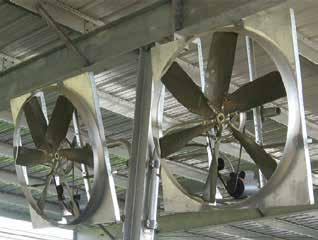

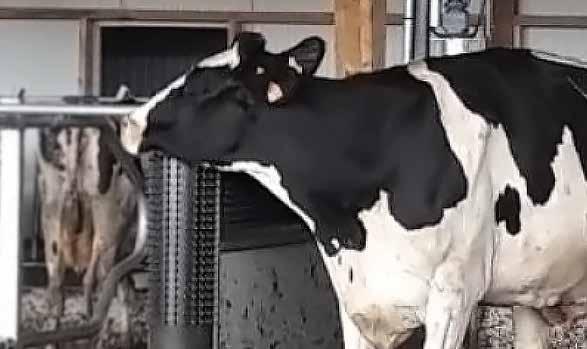

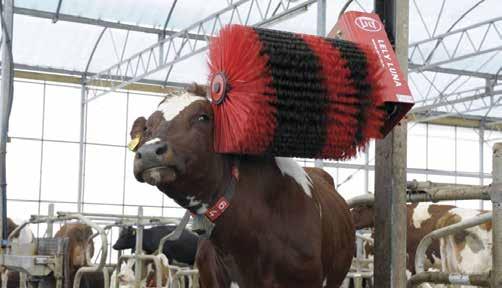







Dairy Star • Saturday, May 11, 2024 • Page 13 Get a FREE Dairy Scratchy * ($175 value) With Purchase of a Lely Luna Cattle Brush NEW PRODUCT/ NEW DEAL! • Rubber animal scratcher • Improves cow comfort • Feels like a rubber-comb • Gently massages • Shock-absorbing to avoid injury caused by jostling • No sharp corners; hock-protection design • Automated cattle brush • Rotates with touch-activation • Lasts longer, soft-start motor • Automatic reverse rotation with cow contact • New design for greater functionality! Contact us today to get this FREE deal and for product details. Melrose, MN Jake—320.761.9630 jmoline@Leedstone.com Glencoe, MN Paul—320.510.0200 pbecker@Leedstone.com Plainview, MN Gregg—507.696.5518 gluebke@Leedstone.com Menomonie, WI Mark—507.259.8047 mjurgenson@Leedstone.com CONTACT YOUR LEEDSTONE REP TODAY! Leedstone.com/equipment-team • • Family & veterinarian owned since 1994 Follow us on social media for the lastest news on Lely and more, with Leedstone! NEW! *Free offer expires July 31, 2024! Con nued from GREAT NORTHERN | Page 12
PHOTO SUBMITTED
www.arnzenconstructioninc.com Warmer days ahead! Keep your barn cool with NCF 52” Panel Fans • Durable and innovative 6-blade design • Heavy-duty galvanized frame • Unique and flexible mounting systems Heavy-duty, Extremely Ef cient Fan for Quiet Dairy Barn Ventilation 320-836-2284 1-888-276-1751 29033 Co. Rd. 17, Freeport, MN In St. Rosa


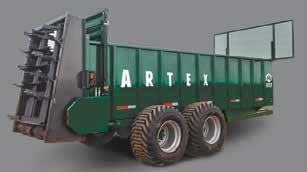


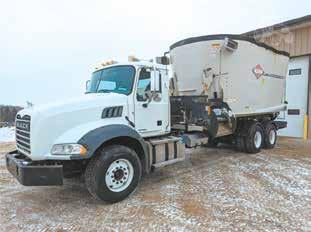























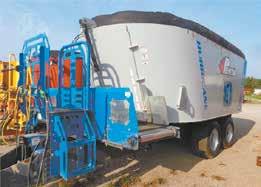
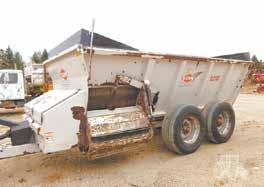


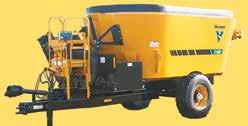
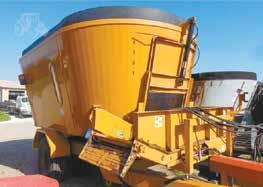
Page 14 • Dairy Star • Saturday, May 11, 2024 SAUK CENTRE, OFF I-94 ON THE CORNER OF HWY. 28 & 71 SOUTH Haybuster CMF830 #21112 - $49,900 Kuhn Knight SLC126 #2291 - $42,900 2018 Penta 8030HD #22140 - $72,500 2020 ARTEX SBX800 #2425- $58,900 2009 Houle EL48-6D6100 #2285 - $38,500 No Reasonable Offer will be Refused!! 2021 Kuhn Knight VTC1120GII #23130 - $195,000 2018 Supreme Intl 1200T #22109 - $59,900 M i n n e s o ta ’s LargestFeeding and ManureHandli n g D e a rel Ifyouhavea barn, we haveasolution. www.dairylandsupply.com SPREADERS Call for availability Parts In Stock In Stock Penta 6730 Parts in Stock! Many Different Sizes In Stock , 2 Inventory Reduction BLOWOUT! Parts In Stock HYDRA-SPREAD In Stock In Stock The KUHN Knight PS 250, 260, 270 & 280 ProSpread® apron box manure spreaders are high-capacity, non-commercial spreaders designed for feeder, cow/calf, and dairy operations that process a wide array of semi-solid and solid materials. Parts In Stock VT600 T WIN-SCREW VERTICAL MIXER In Stock
Rachel Zwieg Lebanon, Wisconsin Dodge County 70 cows
Tell us about your family and any special plans for your family this year. My husband, Kyle, and I have three kids: Theodore, 8, Landon, 7, and Logan, 7. Being on a farm, our plans are very uid. We will take three days off in August between chopping hay and harvesting wheat. Taking the train to Chicago and visiting the Dodge County Fair are our usual plans. Then again in winter, right after harvest, we like to take a trip to Wisconsin Dells, Wisconsin.

What are the best aspects of being a mother and dairy farmer? Growing up on a dairy farm myself, it is seeing them rediscover all the fun things that I used to do as a child. Anything from swinging on a rope to riding their bikes as fast as they can down all the driveways and paths. They have such a joy for adventure.
What challenges do you have with your dual role? The biggest challenge is balancing everyone’s schedules. Some weeks, I won’t know when I will be able to go grocery shopping or to the gym until I wake up in the morning. You have to go with the ow while also working around bus stop times and after school activities. During the really busy season, you have to make time for dinner and getting the kids to bed only to go back out to the barn to nish chores.
What lessons from the farm do you instill in your children? I have two big ones. One is that working hard doesn’t have to feel like work. Kyle and I put in a lot of hours, and we try to show our kids the best aspects of what we do. The other is nding the good on bad days. Farming can take a toll when one of your favorite animals is sick, or the weather takes a turn for the worst and ruins crops. It could even be that they can’t go to a birthday party because the weather is good, and we have to make hay. Teaching them to spend some time in nature or snuggling with the dog or a cow can make a bad day a little better. They are beginning to understand that not all kids have the opportunity to go exploring in the woods or hug an 800-pound animal.
What is a highlight of your dairy career as a mother? Seeing how much our boys want to emulate us. They can’t get enough of learning, and they are constantly disappointed when we tell them they are not big enough or old enough to do something. Whenever the stars align, and the holding pen is almost empty, I let them go in with me to put a cow in the robot and their faces will light up as soon as they step in and help.
What little things on the farm make you smile? Watching my kids stand and get licked by cows. Some days they are covered from head to toe in cow slobber.
What would be the perfect Mother’s Day gift? Lots of rain on Saturday night and beautiful weather all day Sunday. Then, we could spend time outside as a family on actual Mother’s Day. Some owers to plant would also be great.
Tell us about your farm. My husband and I own and operate a robotic dairy and crop farm. My father-in-law, Joe, mother-in-law, Lisa, and brother-in-law, Kevin, also work on the farm. Our children are the seventh generation. We milk 70 cows with one DeLaval VMS V300 robotic milking system. Our milk is sold to Dairy Farmers of America Inc. We farm about 2,000 acres in addition to the dairy.



Jennifer Lemke Grover, Wisconsin Marinette County
50 cows
Tell us about your family and any special plans for your family this year. My husband, Jake, and I have four children ages 5 and under, two boys and two girls: Sophie, Cheyenne, Chas and Luck. Since our youngest is only 3 months old, our plan is to enjoy every moment and survive during the busy farm season ahead.

What are the best aspects of being a mother and dairy farmer? I’ve always wanted to be a farmer and raise my kids on the farm. My husband likes to say he made my dreams come true. I love physical work, being outside and getting dirty. Kids can never complain of being bored in this lifestyle.
What challenges do you have with your dual role? With each child, my farm duties grew less and less. I miss being in the barn and helping my husband, but I wouldn’t trade being with my kids every day. We both agree the stress and safety are not worth bringing the kids out for chores until they are older and more responsible. Our oldest daughter, Sophie, earned her very own pink toolbox so she can work and x with Dad or Mom.
What lessons from the farm do you instill in your children? I want my children to learn life on the farm: hard work, caring for animals and jack-of-all-trades skills. I want them to be xers and problem solvers.
What is a highlight of your dairy career as a mother? I grew up on my dad’s family farm until I was 4. I milked cows through school and worked at an agricultural plant, but I’ve learned more from my husband and this journey. I know most people do not comprehend what a farmer’s duties actually entail. I nally drove a tractor.
What little things on the farm make you smile? When I am outside with my family and look at our place with a lane through our land to the creek, I feel instant happiness, knowing our cows have the option to go out to pasture daily, weather permitting.
What would be the perfect Mother’s Day gift? One large swing set with several swings so Mom can swing too. It’s on the ol’ honey-do list.
Tell us about your farm. My husband bought his herd 10 years ago, but he is the sixth-generation farmer on this farm, established in 1856. We are located in Grover, Wisconsin, and his family rebuilt after the Peshtigo re and have been the only family on this property. The barn has 56 stanchions and tie stalls. We ship our milk to Agropur. My father-in-law always helped with eldwork, and since retiring, he is here most mornings to help with chores just like his dad did. We have a cousin who helps with evening chores and uncles and brothers who drive tractor also. This is our rst year without our beloved Grampa Bud driving through the lane, scouting crops and visiting, so we’re missing him but know he’s watching over the operation.


































Your Leading Supplier of Manure Handling Equipment in Southern Minnesota Your Yo FEATURING OUR CUSTOM DESIGNED, QUALITY BUILT, AND FASTEST OFFLOADING TANKER TRAILERS IN THE INDUSTRY. We are also a proud dealer of: Give Joey Burns a call: 507-461-0038 Email: parts@bosssupplyinc.com 414 South Main St. Janesville, MN 56048 We are also Give Joe Email: part s 414 South Now Introducing our new line of replacement parts compatible with Houle & GEA Liquid Manure Equipment! *Parts are not OEM, manufactured, or aff iliated with Houle/GEA* WWW.BOSS- S UPPLY.COM SEEOUR INVENTORY Dairy Star • Saturday, May 11, 2024 • Page 15 Turn to OUR SIDE | Page 16 from our side our side OF THE FENCE THE What are the best aspects of being a mother and dairy farmer?
Ashley Canter Cashton, Wisconsin Vernon County 60 cows
Tell us about your family and any special plans for your family this year. I homeschool my ve children, four girls and one boy, who range in age from 7 to 15. This year, we’re celebrating everything from the nal rst Holy Communion to the rst driver’s license. The farm is growing and so are the children, and as the seasons change for us, my goal is to help each of them assume new farm, household and academic responsibilities so that our values continue to t naturally with our work.

What are the best aspects of being a mother and dairy farmer? Not only am I able to stay at home and care for my family, but I am privileged to work alongside them too. My roles as farmer, homemaker, teacher and mother form a seamless whole such that each supports and nurtures the others. My children benet from my work in every way. From the fresh milk they drink for breakfast every morning to my guidance when they’re struggling with chores or facing a tough loss, I am thankful to be present and able to provide for them.
What challenges do you have with your dual role? There are never enough hours in the day, and sometimes, I feel a tension between my responsibilities on the farm and in the home. Often, I have to choose which ones deserve my full attention rst and which ones can wait for another day. Then, I need to be content with the outcome. Managing healthy priorities for the whole working family is a constant balancing act.
What lessons from the farm do you instill in your children? Life is fragile and precious. Earthly trials prepare us for heaven, and there is no substitute for diligent labor.
What is a highlight of your dairy career as a mother? When my eldest daughter offered to milk the cows on Christmas morning so I could stay in with the younger children and prepare our celebrations. For once, I didn’t have to focus on striking that balance between the house and the barn, and I was proud that she was so perceptive and prepared to accept extra duties to ease another person’s burden. The world could use some more of that.
What little things on the farm make you smile? New babies, sunrises and bumblebees on the clover owers. Fistfuls of dandelions and the trill of the red-winged blackbird. Snowmen and random hugs. The hen who jumps out of the chicken run every single morning. The little girls singing loudly while they scrape out the holding area.
What would be the perfect Mother’s Day gift? A clean house and a nap.
Tell us about your farm. My husband and I are rst-generation farmers; we moved here from Ohio and retrotted an old red barn with a swing-8 parlor and freestall facility when we started milking eight years ago. We began the transition to organic immediately and became certied grass-fed ve years later. Two years ago, we started shipping to Organic Valley’s Grassmilk line. We follow an intensive grazing protocol on about 100 acres of refurbished pasture, with a mixed herd of high-component breeds. Our teenage daughters help with milking, fencing and moving the herd during grazing season. Our son raises calves and the younger girls help with cleaning. Everyone pitches in to help with small stock, housework and other projects to keep the operation running smoothly. We always seem to have another crazy idea to plant in this good earth.
Casey Welke
Osseo, Wisconsin
Trempealeau County
35 cows
Tell us about your family and any special plans for your family this year. My husband, Cody, and I farm near Osseo, Wisconsin, with our two children Evan, 4, and Hailey, 1. With Cody changing jobs, we have weekends freed up to make it to some of our local events such as fairs and town celebrations. Also, we make it to the pond for the kids to do some shing.
What are the best aspects of being a mother and dairy farmer? The best part of dairying and raising a family is the togetherness whether it is daily chores or welcoming new calves.

What challenges do you have with your dual role? Limitations on time because of obligations of farming and being a mother.
Tammy Sikora Boyd, Wisconsin Chippewa County 70 cows
Tell us about your family and any special plans for your family this year. My husband, Kyle, and I have four children: Bailey, 15, Kendall, 14, Drew, 12, and Ty, 10. They are all active in sports, so a lot of our time away from the farm is spent at ball games. We were able to take a family vacation to Florida this spring to go deep-sea shing, which we all highly recommend.

What are the best aspects of being a mother and dairy farmer? I have always been so thankful that we have been able to raise our kids on the farm and not have to send them to day care. They grow up so fast, and it was nice not to miss that time with them. I am always sad when summer ends and they have to go back to school because I love having them home. We have the exibility to start a little earlier or later if there is something fun we would like to do.
What challenges do you have with your dual role? Some challenges I have come across as being a mom and a dairy farmer is that you can’t just call in to work when the kids are sick. The chores still need to be done. I also feel like it’s hard to prioritize self-care. The kids and the cows always come rst, so sometimes it is hard to set aside time to make those doctor and dental appointments for myself. There never seems to be enough time, and there always seems to be guilt if I miss something the kids are involved in. On the ip side, I also feel guilty if I get someone to milk for me so I can make it to their games. I am sure it is something many farm moms can relate to.
What lessons from the farm do you instill in your children? I hope they learn how to sacrice, compromise, and prioritize time and nances. I hope they appreciate team work and that many hands make light work; and that you get out what you put in most of the time Sometimes no matter how hard you work, things don’t go your way, and you have to accept that. I also hope the farm shows them that you need to have faith that the sun will shine, the rain will come and the crops will grow. Finally, I hope it gives them the foundation to succeed in whatever career they choose to pursue.
What is a highlight of your dairy career as a mother? Our family was part of a Culver’s commercial. Seeing our kids help get the farm ready for the video shoot and having them see what goes on behind the scenes and being a part of the video, this was something we will always remember.
What little things on the farm make you smile? I love a good sunrise or sunset. It is always a great way to start or nish a day. When the kids learn new task, like driving the skid loader, helping mix feed, running the feed cart or digging the cow yard up, seeing the pride in their eyes from a job well-done always puts a smile on my face. I also love a newly cleaned and bedded heifer barn.
What would be the perfect Mother’s Day gift? The best Mother’s Day gift would be to have the whole family home to help with chores morning and night, grill out and play ball in the backyard.
Tell us about your farm. We milk in a 56-stall tiestall barn with seven automatic takeoffs Our milk goes to LaGrander’s Hillside Dairy Inc. in Stanley, Wisconsin. We do not have any hired help but are fortunate to have our niece, her ancé and my brother to help when we want to make it to ball games or take a family vacation.
What lessons from the farm do you instill in your children? Responsibility, work ethic, patience and the understanding of what it takes to get the job done.
What is a highlight of your dairy career as a mother? The fact that I am able to produce a quality product as well as being able to do all the work myself.
What little things on the farm make you smile? When Evan is pushing the broom to help or running the lever to get the total mixed ration fed. It is entertaining to watch Hailey interact with the new calves, play with cats and her latest action of playing in the drinking cups.
What would be the perfect Mother’s Day gift? Most of all, to be with my family and potentially sleep in.
Tell us about your farm. We milk 35 cows in a rented tiestall barn with ve DeLaval automatic takeoffs. We buy all of our feed and mix it into a TMR. We feed either in the barn or at the bunk. My husband watches the kids while I chore in the afternoon and assists with cow health and the breeding. Our milk is shipped to Lynn Dairy & Lynn Proteins Inc.



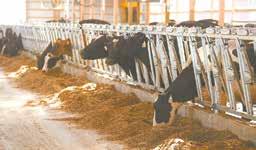
Page 16 • Dairy Star • Saturday, May 11, 2024 Con nued from OUR SIDE | Page 15 www.norbco.com 67962 State Hwy 55, Watkins, MN 55389 • 320-764-5000 MA KING COW COMFORT OUR PRIORITY Curtain SystemsVentilation SystemsFreestall SystemsHeadlocks
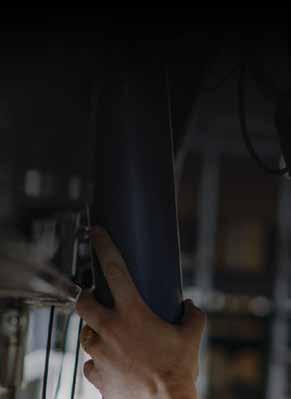






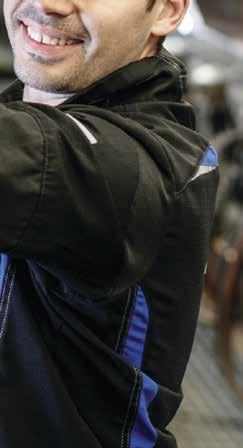


















Dairy Star • Saturday, May 11, 2024 • Page 17 JOIN OUR TEAM Now Hiring Service Technician Intern Apply Now! SCAN ME bit.ly/3fwYBl6 Paid Internship +1-800-636-5581 | Proudly serving you from Brookings, SD; St. Peter, MN; and Melrose, MN! DEALER Cutting-Edge Milking Equipment | Supply Delivery | Preventive Maintenance Herd Advisory & Software Support | Manure Management Services | Feed Management farm-systems.com © 2022 Farm Syststeems. All rig ts hts rese e rved. A-3386648395 Need Service? Keep your operation up and running with Farm Systems Your Local Milking, Manure and Feed Management Solutions & Service Provider
The magic of curds, whey
By Ashley Hagenow
76th Alice in Dairyland
When you picture Wisconsin’s top agriculture products, what comes to mind? For many, it may be cheese, cranberries, snap beans or even ginseng.
Did you know that Wisconsin is also the leading state in the production of dry whey? No way, right? Yes, whey. Dry whey is often used in baked goods, processed cheese products, beverages and protein nutrient supplements.
In 2022, Wisconsin produced more than 270 million pounds of dry whey for human consumption, more than 30% of the nation’s total production, and is home to nine processing facilities that make and process the whey.
As America’s Dairyland, it makes sense that we are a top producer of whey as it is a byproduct of cheese, casein and yogurt production.
In the cheese making process, milk is split into curds and whey. Curds are eventually made into cheese, and whey is drained off to be used in various products. Whey is typically watery, yellow in color, rich in nutrients, and contains lactose, protein, minerals and vitamins.
Whey can be used as an additive in cattle feed or puried back into clean water so it can be used again. To make whey powder, liquid whey is pasteurized and dried into a powder through reverse osmosis and vacuum evaporation.
Whey protein may be used to improve athletic performance and address nutritional deciencies. However, with many protein options on the market, why choose whey?
It is a complete protein, meaning it features all nine essential amino acids, or building blocks your body needs. According to registered dietitian Maxine Smith, in an article with Cleveland Clinic, “Amino acids are important for many functions in the body, from building muscle to creating new immune cells.”
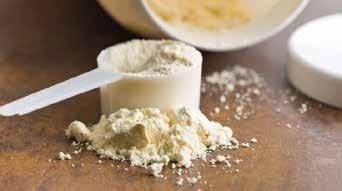
The Cleveland Clinic article also shares that the amino acids in whey protein help with wound healing and that whey protein can be used as a source of protein for those who may not be able to get protein from whole food sources. The powder is easily added into foods and beverages as it has a neutral avor, dissolves easily in liquids and provides a smooth


texture. In fact, whey is benecial to building muscle not only for humans but for other species as well.
When growing up in 4-H and FFA, I used to show performance horses that were trained three to ve days a week. We sourced whey from Mullin’s Cheese and Whey, located in Mosinee, Wisconsin, to use as a supplement in our horses’ diets to help build and maintain strong muscles for halter and other performance-based classes. In this case, whey is an all-encompassing product which can be enjoyed in many different forms.
Whey protein can also be used in
baked goods, processed cheese products, sauces, dressings, prepared meat products and beverages, and acts as a binder and extender in food products. Additionally, demineralized whey protein can be used in the manufacturing of diet foods, baby foods, dry prepared mixes and other food products that need specic mineral requirements.
The next time you drink a protein shake, use salad dressing or even eat a piece of bread, check the label and see if the ingredients include whey. Consuming whey products is a great way to support Wisconsin’s dairy farmers across the country and in Wisconsin farms.



















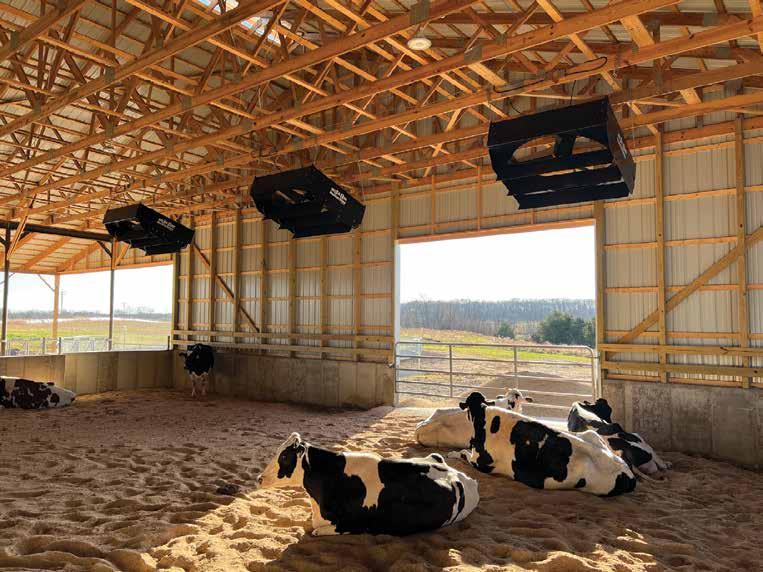





Page 18 • Dairy Star • Saturday, May 11, 2024 DECORAH, IA Lang’s Dairy Equip. 563-382-8722 MONTICELLO, IA United Dairy Syst. 319-465-5931 WEST UNION, IA United Dairy Syst. 563-422-5355 FREEPORT, MN Arnzen Construction 320-836-2284 Hartung Sales & Serv. 320-836-2697 LEWISTON, MN Lang’s Dairy Equip. 507-452-5532 MELROSE, MN Farm Systems 320-256-3276 MENAHGA, MN Dairyland Equip. 218-564-4958 PENNOCK, MN D&D Ag Supply & Construction 320-599-4466 SAUK CENTRE, MN Dairyland Supply 320-352-3987 800-338-6455 JANESVILLE, WI Tri-County Dairy Sup. 608-757-2697 LANCASTER, WI Fuller’s Milker Center 800-887-4634 MARSHFIELD, WI Podevels Farm Serv. 715-384-6193 800-742-5748 MT. HOREB, WI The Scharine Group 800-872-3470 RICHLAND CENTER, WI Fuller’s Milker Center 800-887-4634 SPARTA, WI Preston Dairy Equip. 608-269-3830 WHITEWATER, WI The Scharine Group 608-883-2880 WITHEE, WI Hoover Silo Repair 715-229-2527
Family Owned & Operated in Eau Claire, Wisconsin Where you can buy : : #RequestTheTest RequestTheTest We are your Ventilation Experts IOWA MINNESOTA WISCONSIN • Direct Drive Motor • Maintenance-Free • Variable Speed AIRBLASTERS FAN SELECTION & LAYOUT
www.jdmfg.com www.jdmfg . com
PHOTO COURTESY OF ADOBE STOCK
Wisconsin is home to nine processing facili es that make and process whey. Dry whey is o en used in baked goods, processed cheese products, beverages and protein nutrient supplements.
PHOTO COURTESY OF ADOBE STOCK
Whey is a complete protein featuring all nine essen al amino acids. Wisconsin is the leading state in the produc on of dry whey.
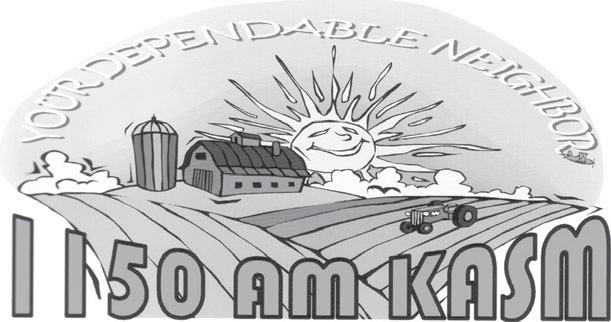





“We have seen good results with Udder Comfort™ through the years. We didn’t see that with other products we tried. We love what it does for our fresh cows, especially 2-year-olds. It gets swelling out fast, softening udders quicker for more comfortable milking. We really like the ease of use and doing fresh groups in the barn with the Udder Comfort Battery-Operated Backpack Sprayer. We do pre-fresh heifer groups once a week when we vaccinate. We do post-fresh heifers and cows every morning for 10 days after calving while in lockups for daily temps,” says Jim Rickert of Rickland Farms, Eldorado, Wisconsin.
Four generations farm 2000 acres and milk 975 Reg. Holsteins. They were profiled in a Sept. 2023 Holstein America on RFD-TV. (Watch it at https://qrco.de/Rickland or scan QR.)
“Udder Comfort makes the biggest difference,” Jim reports. “It pays to get fresh udders softer, faster, for better milking and more comfortable cows at the start
We wouldn’t be doing
if it didn’t pay.”



Dairy Star • Saturday, May 11, 2024 • Page 19
lactation.
of
this
“It pays to get fresh udders softer, faster... We really like the ease of use... doing fresh groups in the barn.” Quality Udders Make Quality Milk RICKLAND FARMS, ELDORADO, WISCONSIN, THE RICKERT FAMILY (4 generations) Family featured in RFD-TV Holstein America; Jim Rickert and grandson Miles, 14, pictured Milking 975 Reg. Holsteins: 98 lbs/cow/day (3x), 3.7F 3.2P For external application to the udder only, after milking, as an essential component of udder management. Always wash and dry teats thoroughly before milking. Her Comfort is Our Passion! Softer udders [ Faster milking Better quality [ MORE MILK 1.888.773.7153 uddercomfort.com Helping reach their potential since 1998! Celebrating over 40 Years in Business 1010 Hoeschler Dr. • Sparta, WI 54656 Phone: 608-269-3830 Toll Free: 1-888-863-0227 Email: prestonde@prestonde.com Does your milking equipment need maintenance? DAIRY EQUIPMENT INC. We service all dairy equipment! Give us a call to schedule a visit. PO Box 160, Albany, MN • (320) 845-2184 • Fax (320) 845-2187tfn Catch the Dairy Star’s Mark Klaphake with Joe Gill at 6:45 a.m. the 2nd & 4th Fridays of the month on KASM! Joe Gill • Farm Director SERVING CENTRAL MINNESOTA FOR OVER 50 YEARS
INFORMATION STATION
— Jim Rickert
FARM
How many times a day do you milk, and what is your current herd average, butterfat and protein? We milk three times a day, and our rolling herd average is 30,800 pounds of milk with 3.8% butterfat and 3.2% protein.
Describe your housing and milking facility. Our freestall barn was built in 2002 and is naturally ventilated. The free stalls are bedded with sand. We milk in the double-8 parallel parlor that we built in 2000.
Who is part of your farm team, and what are their roles? My wife, Barb, is the farm’s bookkeeper. Our son, Kyle, is in charge of breeding, and our son, Dave, is the herdsman and takes care of herd health. We all pitch in wherever we are needed, especially during the busy eldwork season.
What is your herd health program? Our veterinarian, Dr. Erika Nagorske, performs pregnancy checks every other week. We vaccinate all of our animals according to Dr. Nagorske’s vaccination schedule. It doesn’t pay to skimp on vaccines. Cleanliness is also important. We make sure that all of our milking equipment
TOP PERFORMERS
is sanitized and that the free stalls are kept clean and dry and have fresh sand.
What does your dry cow and transition program consist of? All of our cows are given a 60-day dry period. Dry cows are housed in a separate facility and are fed a ration that includes corn silage, ground corn stalks and a grain mix. When it’s available, we will give them grass hay instead of corn stalks. Immediately after calving, fresh cows are given two Bovikalc boluses. We don’t have a transition program. Fresh cows go straight from the maternity pen into one of our lactating groups.
What is the composition of your ration, and how has that changed in recent years? Our lactating animals are given a total mixed ration that consists of corn silage, haylage, cottonseed and a custom grain mix. We quit using dry hay in our lactating ration a few years ago because it got too expensive to buy. We have found that using haylage instead works just ne.
Tell us about the forages you plant and detail harvest strategies. We plant silage corn and alfalfa. We keep our
|

We apply manure immediately after each cutting. We were able to harvest ve cuttings of alfalfa last year.
What is your average somatic cell count, and how has that affected your production? Our SCC typically ranges from 78,000 to about 100,000, which is good enough to get us into the Minnesota DHIA top 100 milk quality leaders. Keeping our SCC low has helped us maintain high milk production levels.
What change has created the biggest improvement in your herd average? Our mixer has helped increase our average the most, followed by going to three-times-a-day milking. Before we got the mixer, we would feed the cows baled hay with silage and a grain mix fed separately.
What technology do you use to monitor your herd? All of our cows have activity and rumination collars. The collars tell you right away if a cow is in heat or is feeling sick. We also put activity collars on
alfalfa elds for three or four years before rotating them back to corn. Our goal is to harvest our corn silage and
haylage at 68% moisture. We cut our alfalfa before it reaches the bud stage and let it lie for a day before we chop it.
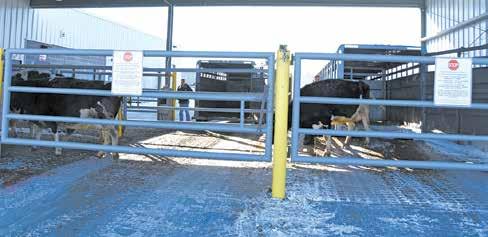

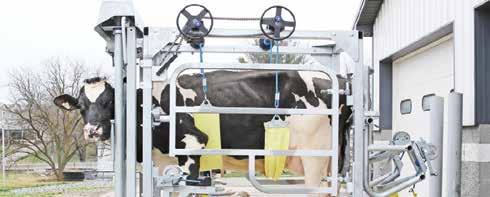



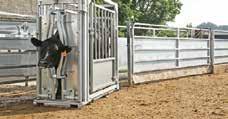

Page 20 • Dairy Star • Saturday, May 11, 2024 TOP PRICES PAID & CONTRACTING AVAILABLE Your Market For: Holstein Steers • Fed Dairy Cows • Lean Dairy Cows Your local area buyer for MN, IA and WI. Long Prairie Buying Station Bruce Belter • 507-429-0359 Holstein Steers • Lean Cows • Bulls • Fed Cows Tyrel Lembke • 877-300-9298 Long Prairie, MN Lean Cows • Bulls Dean Derricks • 920-655-4730 Green Bay, WI Holstein Steers • Fed Cows • Lean Cows Chad McQuade • 605-668-4275 Yankton, SD Lean Cows • Bulls Mike Baczwaski • 800-445-0042 Gibbon, NE Fed Cows • Lean Cows • Bulls Cody Ritter • 320-293-5212 • 320-732-8358 Long Prairie, MN Green Bay Dressed Beef Request FREE EQUIPMENT GUIDES on our Entire Product Line! sales@sturdybuiltmfg.net 260 S. Muddy Creek Rd. Denver, PA 17517 Veterinarian Chutes • Manual & Hydraulic Vet Chutes • Quad Gate Vet Chutes • Beef Vet Chutes • Standard 4-Bar Chutes • Individual Head Gates • Cattle Sweeps B eef Vet Chutes • Customized Cattle Sweeps Call 866-543-5116
Keith Pedley of Pedley Holsteins
Ocheyedan, Iowa | Osceola County | 300 cows
JERRY NELSON/DAIRY STAR
Turn to TOP PERFORMERS | Page 23
Barb and Keith Pedley and their family milk 300 registered Holsteins on their farm near Ocheyedan, Iowa. Their rolling herd average is over 30,000 pounds.





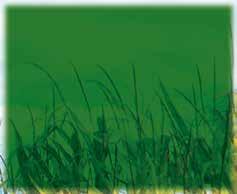


















JD C350 2023, #571477............................................................................
ROUND BALERS
JD 468 Silage Special 2010, Twine, 4 ft. bales, 19300 BC, #567833 ........ $15,000
JD 458 2011, Twine, 4 ft. bales, 200 BC, #576430 ..................................... $15,900
JD 568 2009, Twine & Surface Wrap, 5 ft. bales, 16500 BC, #570611 ........ $18,900
JD 568 2010, Twine & Surface Wrap, 5 ft. bales, 14683 BC, #559585 ........ $19,900
JD 568 2009, Twine & Surface Wrap, 5 ft. bales, 14389 BC, #570459 ........ $19,900


Claas 380 2015, Surface Wrap, 4 ft. bales, 5200 BC, #567694 .................. $21,100
JD 854 Silage Special 2013, Twine & Surface Wrap, 5 ft. bales, 7864 BC, #573441 ................................................................................
JD 469 2015, Twine & Surface Wrap, 4 ft. bales, 21000 BC, #570101
JD 569 2016, Surface Wrap, 5 ft. bales, 14000 BC,







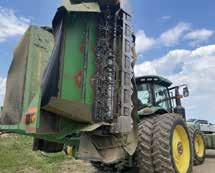


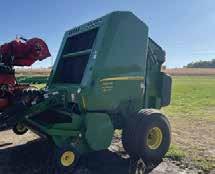

JD 560M 2018, Twine & Surface Wrap, 5 ft. bales, 8000 BC, #574492
JD 560M 2020, Surface Wrap, 5 ft. bales, 10500 BC, #573915
JD 460M 2020, Twine & Surface Wrap, 4 ft. bales, 11886 BC, #574791 .....
JD 569 2015, Twine & Surface Wrap, 5 ft. bales, 4200 BC, #574587 ..........
JD 560M 2020, Surface Wrap, 5 ft. bales, 9462 BC, #567629 ...................
JD 560M 2019, Twine & Surface Wrap, 5 ft. bales, 6000 BC, #554127 .......
JD 560M 2021, Twine & Surface Wrap, 5 ft. bales, 8233 BC, #557166 .......
JD 460M 2020, Twine & Surface Wrap, 5 ft. bales, 6248 BC, #574583 .......
JD 560M 2019, Surface Wrap, 5 ft. bales, 4300 BC, #573416 ....................
JD 560M 2019, Twine & Surface Wrap, 5 ft. bales, 5339 BC, #574784 .......
JD 450M 2021, Twine & Surface Wrap, 4 ft. bales, 2950 BC, #577084 ....... $44,500
JD 560M 2019, Twine & Surface Wrap, 5 ft. bales, 3542 BC, #574981 ....... $44,900
JD 560M 2018, Twine & Surface Wrap, 5 ft. bales, 4500 BC, #568316 ....... $44,900
JD 560M 2023, Surface Wrap, 5 ft. bales, 7233 BC, #580417 .................... $45,900
JD 460M 2021, Twine & Surface Wrap, 4 ft. bales, 7574 BC, #574793 ....... $45,900






JD 560M 2020, Surface Wrap, 5 ft. bales, 3950 BC, #574425 ....................
JD 560M 2020, Twine & Surface Wrap, 5 ft. bales, 5555 BC, #574701 .......
JD 560M 2020, Twine & Surface Wrap, 5 ft. bales, 2955 BC, #570458 .......
JD 560M 2021, Twine & Surface Wrap, 5 ft. bales, 6257 BC, #570539 ....... $48,900
JD 460M 2019, Twine & Surface Wrap, 4 ft. bales, 2487 BC, #564617 ....... $49,900
JD 560M 2021, Surface Wrap, 5 ft. bales, 5157 BC, #574523 ....................
JD 560M 2020, Twine & Surface Wrap, 5 ft. bales, 2300 BC, #575077
JD 460M 2021, Twine & Surface Wrap, 4 ft. bales, 1600 BC, #572264






Dairy Star • Saturday, May 11, 2024 • Page 21 Equipment and pictures added daily • Go to www.mmcjd.com Locations throughout minnesota & western wisconsin! CALL TODAY! (320)365-1653 SEE OUR COMPLETE INVENTORY WITH PICTURES AND DESCRIPTIONS AT: www.mmcjd.com 2019 John Deere R990R, #572102 $49,900 Financing subject to pre-approval through JD Financial. Some restrictions apply. See dealer for details. FLEXIBLE FINANCING OR CASH DISCOUNTS ON SPFH’S & HAY TOOLS MOWER CONDITIONERS JD 956 2004, #560275 .............................................................................. $14,900 JD 835 2008, #580656 .............................................................................. $15,500 Kuhn FC883, #568119 ............................................................................. $16,500 JD 635 2011, #566470 .............................................................................. $18,000 JD 635 2017, #569301 .............................................................................. $18,400 NH H7450 2013, #570040........................................................................ $19,900 JD 635 2012, #575131 .............................................................................. $19,900 Kubota DMC8540R 2019, #563324 ........................................................ $22,500 JD 630 2017, #570792 .............................................................................. $23,900 JD 388 2015, #580199 .............................................................................. $27,500 Pottinger V10 351 Mower 2013, #554169 ............................................ $27,900 NH 313 2021, #569982 ............................................................................ $36,900 Pottinger V10/351
........................................................ $39,500
$42,500
......................................................... $75,900
2015, #572226
Pottinger 351 RCB 2020, #561190
$21,600
........ $21,900
#568586 ..................... $24,500
Twine & Surface Wrap, 5 ft. bales, 13519 BC, #576138 ........ $26,000
2016, Surface Wrap, 4 ft. bales, 8500 BC, #574792........ $26,500 Claas 380 2015, Surface Wrap, 4 ft. bales, 5650 BC, #568147 .................. $26,500 JD 569 2013, Twine & Surface Wrap, 5 ft. bales, 16500 BC, #574766 ........ $26,500 JD 569 Silage Special 2016, Twine & Surface Wrap, 5 ft. bales, 14000 BC, #574783 .............................................................................. $26,500 JD 569 2014, Twine & Surface Wrap, 9550 BC, #574347 ........................... $28,900 JD 560M 2019, Surface Wrap, 5 ft. bales, 17500 BC, #575405 .................. $29,500 JD 469 Silage Special 2016, Twine & Surface Wrap, 4 ft. bales, 10000 BC, #564687 .............................................................................. $29,900 Kuhn VB2290 2017, Surface Wrap, 4 ft. bales, 1200 BC, #578435 ........... $31,500 JD 469 Silage Special 2015, Twine & Surface Wrap, 4 ft. bales, 7250 BC, #571974 ................................................................................ $34,500
BC, #570626 ..... $34,900
BC, #576404 ...... $37,500
JD 568 2012,
Kubota BV4580
JD 560M 2018, Twine & Surface Wrap, 5 ft. bales, 10752
JD 469SS 2013, Twine & Surface Wrap, 4 ft. bales, 5772
....... $38,900
.................. $39,500
$39,900
$39,900
$41,500
$42,900
$43,500
$43,900
$44,400
$44,500
$47,500
$47,900
$48,500
$50,500
$50,900
....... $51,900 JD 560M 2021, Surface Wrap, 5 ft. bales, 3400 BC, #575104 .................... $51,900 Case IH RB565 2022, Twine & Surface Wrap, 5 ft. bales, 2304 BC, #572410 ................................................................................ $51,900 JD 560M 2018, Twine & Surface Wrap, 4 ft. bales, 2550 BC, #574158 ....... $52,500 JD 460M 2021, Twine & Surface Wrap, 4 ft. bales, 450 BC, #574826 ......... $53,500 JD 560M 2021, Twine & Surface Wrap, 5 ft. bales, 1500 BC, #570522 ....... $53,900 JD 460M 2023, Twine & Surface Wrap, 4 ft. bales, 1500 BC, #555076 ....... $54,900 JD 560M 2022, Surface Wrap, 5 ft. bales, 1516 BC, #547391 .................... $59,900 JD 560M 2023, Twine & Surface Wrap, 5 ft. bales, 1670 BC, #574702$ ....... 60,900 JD 560M 2022, Twine & Surface Wrap, 5 ft. bales, 3500 BC, #570456 ....... $69,900 SELF-PROPELLED FORAGE HARVESTERS JD 6810 1993, Kernel Processor, PRWD, 5314 hrs., 3524 CH hrs., #579404 ..... $30,000 JD 6850 2002, Kernel Processor, PRWD, 4541 hrs., 3260 CH hrs., #581227 ..... $54,500 JD 7750 2008, Kernel Processor, 4691 hrs., 2991 CH hrs., #568793 ................ $89,500 JD 7550 2010, Kernel Processor, PRWD, 2778 hrs., 1896 CH hrs., #579487 ... $146,500 JD 8600 2016, Kernel Processor, PRWD, 1611 hrs., 1200 CH hrs., #555841 ... $235,900 JD 9600 2019, Kernel Processor, PRWD, 1743 hrs., 1130 CH hrs., #553763 ... $329,900 JD 9900 2022, Kernel Processor, PRWD, 2000 hrs., 1500 CH hrs., #574301 ... $349,900 JD 9600 2019, Kernel Processor, PRWD, 1311 hrs., 811 CH hrs., #532049 ..... $369,900 JD 9600 2020, Kernel Processor, PRWD, 1310 hrs., 775 CH hrs., #565393 ..... $375,000 JD 9900 2019, Kernel Processor, PRWD, 1397 hrs., 884 CH hrs., #550177 ..... $399,900
.......
hrs., 990 CH hrs.. #573149 ..... $409,900
JD 9900 2021, Kernel Processor, PRWD, 1353
CH hrs.,
....... $420,000
JD 9600 2021, Kernel Processor, PRWD, 892 hrs., 538
#565399
CH hrs.,
..... $429,900
CH hrs., #550175 ..... $439,900
9700 2020, Kernel Processor, PRWD, 1170 hrs., 835 CH hrs., #543646 ..... $439,900
2021, Kernel Processor, PRWD, 527 hrs., 317 CH hrs., #574593 ....... $441,000 JD 9700 2021, Kernel Processor, PRWD, 1201 hrs., 900 CH hrs., #579477 ..... $454,900 JD 9700 2020, Kernel Processor, PRWD, 969 hrs., 500 CH hrs., #552460 ....... $469,900 JD 9600 2022, Kernel Processor, PRWD, 663 hrs., 507 CH hrs., #576032 ....... $499,900 JD 9500 2022, Kernel Processor, PRWD, 613 hrs., 317 CH hrs., #565391 ....... $505,900 JD 9800 2021, Kernel Processor, PRWD, 628 hrs., 369 CH hrs., #552624 ....... $509,900 JD 9800 2021, Kernel Processor, PRWD, 579 hrs., 302 CH hrs., #550106 ....... $518,000 JD 8400 2023, Kernel Processor, PRWD, 26 hrs., #560608 ............................ $531,000 JD 9800 2022, Kernel Processor, PRWD, 565 hrs., 375 CH hrs., #572207 ....... $575,000 JD 9900 2022, Kernel Processor, PRWD, 746 hrs., 330 CH hrs., #565395 ....... $595,000 2021 Pottinger Novacat A10 RCB, #574777 $74,000 $42,500 2023 John Deere C350 #571477 $27,500 2015 John Deere 388 #580199 $75,900 2020 Pottinger 351 RCB #561190 $54,900 2023 John Deere 460M #555076 $69,900 2022 John Deere 560M #570456 $60,500 2022 John Deere 560M #576035
JD 9800 2020, Kernel Processor, PRWD, 1333 hrs., 859
#536344
JD 9800 2019, Kernel Processor, PRWD, 1063 hrs., 660
JD
JD 8400

Wall and Ceiling Panels


Contact one of the following dealers to learn more:
IOWA
Prairie Land Ag Supply Inc. Rock Valley, IA 712-476-9290
United Dairy Systems, Inc.
West Union, IA 563-422-5355
Monticello, IA 319-465-5931
WISCONSIN
Advanced Dairy Spring Valley, WI 715-772-3201
Bob’s Dairy Supply Dorchester, WI 715-654-5252
Ederer Dairy Supply Plain, WI 608-546-3713
DeLaval Dairy Service Kaukauna, WI 866-335-2825
Joe’s Refrigeration Inc. Withee, WI 715-229-2321
Mlsna Dairy Supply Inc. Cashton, WI 608-654-5106
Professional Dairy Services Arlington, WI 608-635-0268
Redeker Dairy Equipment Brandon, WI 920-346-5579
The Scharine Group Inc. Whitewater, WI 800 472-2880 Mt Horeb, WI 800-872-3470
MINNESOTA & SOUTH
DAKOTA
Farm Systems
Melrose, MN
320-256-3276 Brookings, SD 800-636-5581
Advanced Dairy Mora, MN
320-679-1029 Pierz, MN
320-468-2494
St. Charles, MN 507-932-4288 Wadena, MN 218-632-5416
Bongards’ Creameries
Has been a quality market for MN dairy farmers for over 100 years. MN producers provide one of the country’s most distinctive brands of cheese that is still made using the same Old World craftsmanship and has been combined with cutting-edge technology to produce cheese that delivers unforgettable taste with unparalleled quality. MN Dairy farmers and Bongards, quality that stands the test of time. We offer a competitive base price, premiums, and the best eld representatives in the industry.
13200 Co. Rd. 51 Bongards, MN 55368 (952) 466-5521
Fax (952) 466-5556
110 3rd Ave. NE Perham, MN 56573 (218) 346-4680
Fax (218) 346-4684

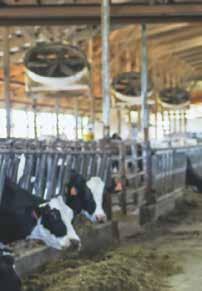








































Page 22 • Dairy Star • Saturday, May 11, 2024
delaval.com With DeLaval Plus Behavior Analysis you have a tool that seamlessly integrates into your operation to give you and your team total visibility and oversight of your cows 24/7. Find out more about DeLaval Plus Behavior Analysis - it could be what’s next for your farm. is a registered trademark of Tetra Laval Holdings & Finance S.A. and “DeLaval” is a registered trade/servicemark of DeLaval Holding AB. © 2024 DeLaval Inc. DeLaval, 11100 North Congress Avenue, Kansas City, Missouri 64153-1296. DeLaval does not claim that the results reflected herein are typical and this information does not constitute a warranty nor guarantee of service or performance. Actual performance and improvement will depend on a number of factors, including milking practices, type of cows, farm and herd maintenance practices. Services described herein are not intended or implied to be a substitute for professional veterinary advice, diagnosis, consultation, or treatment. Only a professional veterinarian can diagnose a medical condition. Your use of these products and services is governed by the terms and conditions set forth at www.delaval.com/legal. We are catching more cows in heat with the Behavior Analysis system because it is always watching the cows… you get activity on every cow, every day. John Dukelow Dukestead Acres, Abbotsford, WI, DeLaval Plus - Your Performance Portal ing more cows Analysis syste atching the cow er y cow, every “ ” •Easy To Clean • Quick And Easy To Install • Hidden Fastener • Low Maintenance • Mold and Mildew Resistant • Distinctive Tongue and Groove System • Seamless Appearance • Economical • No Painting Required 715-644-2350 Chippewa Valley Dairy Supply 6053 CTY. HWY. G • STANLEY, WI 54768 • Andrew Zimmerman
SLAT WALL KITS ALSO AVAILABLE
Con nued from TOP PERFORMERS | Page
like to show dairy cattle, so we always keep a few show cows around for them.
What is your breeding pro-
and what role does ge-
play in your
Our
is
registered Holsteins. Mating suggestions are made by a Semex computer program. All of our breeding choices are made with a low SCC, good type, high production and sound udders in mind. Our grandkids

List three management strategies that have helped you attain your production and component level. Our mixer has helped us make a balanced ration on a consistent basis. The activity collars have helped us a lot when it comes to breeding and monitoring herd health. We use sexed semen, so we always have more heifers than we need. This allows us to be choosy when we decide which heifers should join our milking herd.
JERRY NELSON/DAIRY STAR
The freestall barn at Pedley Holsteins was built in 2002 near Ocheyedan, Iowa. It features natural ven la on, s r fans and stalls that are bedded with sand.
Tell us about your farm and your plans for your dairy in the next year. My wife, Barb, and I have been married for 49 years. I have milked cows my entire life. I started farming on my own on a rented farm in 1976 with a John Deere 4020 and a vebottom plow. I moved here

and bought out Dad in 1991. At that time, we had 60 cows and 30 heifers. I worked with my dad and my uncle until they retired. Kyle and Dave take care of all of the farm’s repair work. They also do custom eldwork such as planting corn and hauling manure. Our plans for the next year are to simply keep on improving on what we have.
NEW & USED EQUIPMENT ON HAND








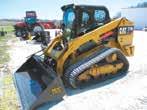




JERRY NELSON/DAIRY STAR
The double-8 parallel milking parlor at Pedley Holsteins was completed in 2000 near Ocheyedan, Iowa. Their 300 registered Holsteins are milked three mes a day.
JERRY NELSON/DAIRY STAR
Diva, a Red & White Holstein show cow who lives at Pedley Holsteins, is wearing a collar that monitors her ruminaon and ac vity near Ocheyedan, Iowa. All of the cows and breeding-age heifers are equipped with ac vity collars.





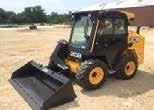


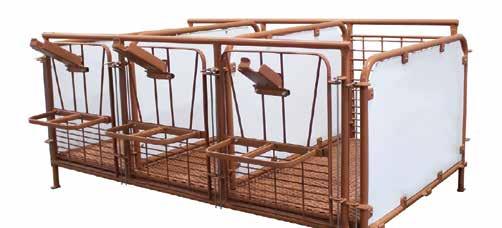



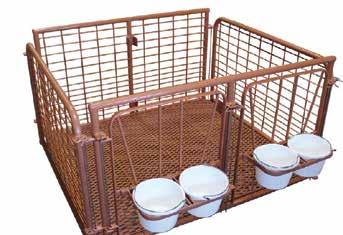
Dairy Star • Saturday, May 11, 2024 • Page 23 Keep Calves Clean, Dry, & Healthy! Contact Us for a Quote Today! ADA ENTERPRISES, INC. Manufacturers of Dura Trac Plastisol Coated Steel Calf Flooring, Stalls, and Convertible Pens NEW! DURA TRAC CALF PEN Double and Triple Stall Designs Easily Convert to One Open Pen. MORE LISTINGS ONLINE! www.windridgeimplements.com Cresco (563) 547-3688 Decorah (563) 382-3614 Elkader (563) 245-2636 E C D $33,500 C 2018 Case SV185-T4B Skid Steer Loader 1474 hrs., #21706 2024 JCB 270 Skid Steer Loader #23406W Call for best price! E 2020 JCB 3TS-8T Compact Track Loader 377 hrs., #21684 Call for best price! E 2024 JCB 215 Skid Steer Loader #23404W Call for best price! E 2021 JCB 409 Wheel Loader 3500 hrs., #22461 Call for best price! E 2019 Case TV450 Compact Track Loader 2135 hrs., #22576 $47,900 D 2020 Case TR310B T4 FINAL Compact Track Loader, 486hrs., #21694 $59,995 C 2024 JCB 215T Compact Track Loader #23410W Call for best price! E D '15 Caterpillar 279D Compact Track Ldr, 1714 hrs., #23481 $49,500
our breeding-age heifers so that we can tell when they are ready to be bred.
gram,
netics
production level?
herd
100%
20
AG TRUCKS




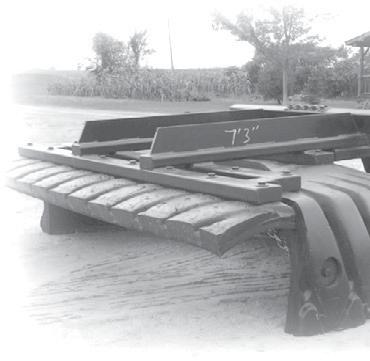
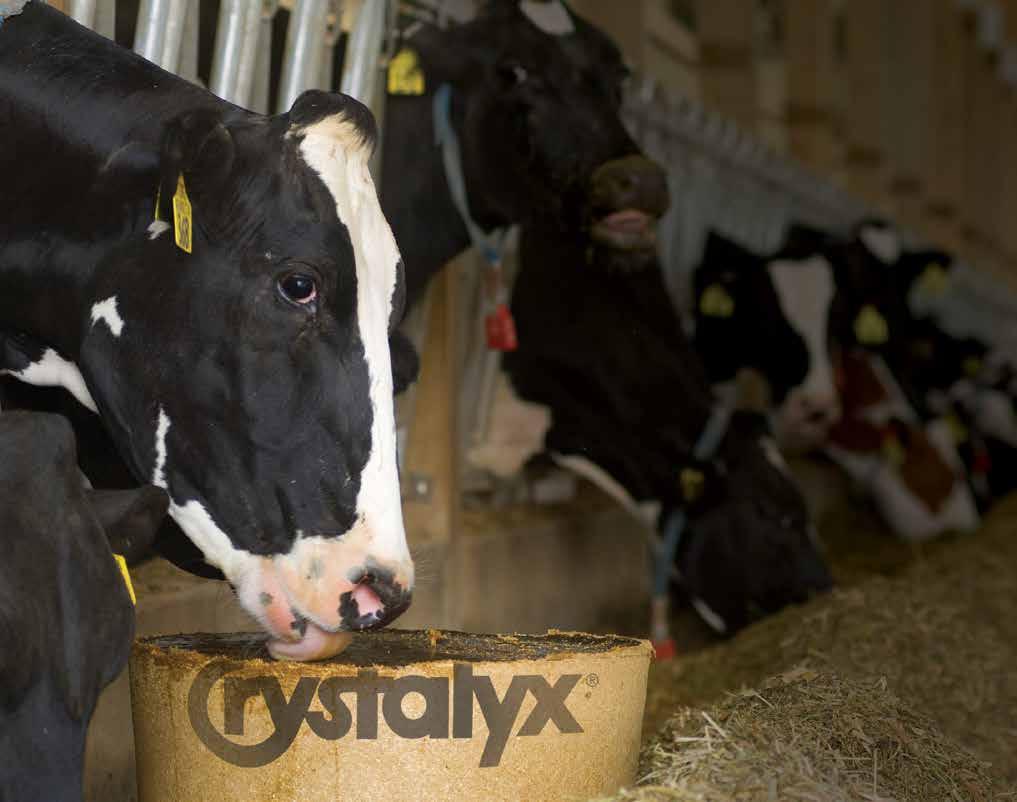
SUNRISE AG CO-OP Buckman, MN • 320-468-6433
LEAF RIVER AG SERVICE Bluffton, MN • 218-385-2559
FARMERS ELEVATOR COMPANY Waupun, WI • 920-324-3593
ADELL COOPERATIVE Adell, WI • 920-324-3593
CHIPPEWA VALLEY DAIRY SUPPLY Stanley, WI • 715-644-2350
GLACIAL PLAINS CO-OP Benson, MN • 320-843-3999
GLACIAL PLAINS CO-OP DeGraff, MN • 320-843-5634
GLACIAL PLAINS CO-OP Sunburg, MN • 320-366-3456
HEAD TO HEAD, POUND FOR POUND, THERE’S NO BETTER BARREL.
Conventional wisdom says that you get what you pay for. And conventional wisdom is right. You won’t find CRYSTALYX® in the bargain aisle, but it’ll always get the optimal performance out of your cattle. Whether it comes in a steel or plastic barrel, or our sustainable BioBarrel®, CRYSTALYX® is more than just a supplement. It’s an investment.
ELROSA GRAIN AND FEED Elrosa, MN • 320-697-5515
PRAIRIE FARM SUPPLY Belle Plaine, MN • 952-873-4234
HOLDINGFORD MILL Holdingford, MN • 320-746-2281
ALBANY FEED SHED Albany, MN • 320-845-2303
LUXEMBURG FEED SERVICES, INC St. Cloud, MN • 320-252-1513
UNITED FARMERS CO-OP LeSueur, MN • UFCMN.com • 507-665-6421
Page 24 • Dairy Star • Saturday, May 11, 2024
©2023 Ridley USA, Inc. All Rights Reserved.
OAK PARK CREAMERY Oak Park, MN • 320-968-7864 MILLVILLE FEED INC. Millville, MN • 507-798-2391 CHECK WITH YOUR LOCAL DEALER TODAY! DOANE’S GRAIN SERVICE Plainview, MN • 507-534-3165 LEWISTON FEED & PRODUCE Lewiston, MN • 507-523-2196 FORESTON FARMERS CO-OP CREAMERY Foreston, MN • 320-294-5711 33 FEEDS, LLC Orfordville, WI • 608-879-3373 SIMON’S FEED & SEED LLC Elkhorn, WI • 262-723-7945 FARMERS GRAIN & FEED Allenton, WI • 262-629-4126 GENERAL FARM SUPPLY Spencer, WI • 715-659-4441 GENERAL FARM SUPPLY Marsh eld, WI • 715-387-0348
MN
Des Moines, IA
SALES PARTS SERVICE Davenport, IA
Bloomington,
(952) 888-2525
(515) 965-1000
(563) 949-4045
PARTS & ATTACHMENTS Custom agriculture & commercial trucks, parts & attachments. FLATBEDS | LIFT ATTACHMENTS | DUMP BODIES | LANDSCAPE | PLOWS & MORE! Scan the code to learn more! 608-524-9958 » www.forwardfarmlines.com RUGGED, RELIABLE, and ECONOMICAL BUYING? SELLING? CHECK THE CLASSIFIEDS!
The third time is a charm
Colby FFA dominates state dairy judging contest
By Danielle Nauman danielle.n@dairystar.com
COLBY, Wis. — With determination and dedication, four members of the Colby FFA Chapter picked up their clipboards, sharpened their No. 2 pencils, made their placings and took the Dairy Cattle Evaluation and Management Career Development Event by storm April 25 in Madison.
The team, which consists of seniors Jazmyn Heeg and Breanne Zawislan and juniors Ella Raatz and Jenelle Ertl, won the state FFA contest convincingly, out-pacing the second-place team by 49 points. Three of the four team members placed in the top 10 individually: Heeg in fth place, Zawislan in eighth and Raatz in 10th.
The team will advance to the national contest this fall at the National FFA Convention & Expo in Indianapolis, Indiana.
“The third time was a charm for us,” Raatz said. “This is the third time we’ve competed at the state contest. It was amazing to nd out that we’d won this time.”
The state contest consisted of four placings classes and two oral reasons classes. The students also evaluated two
pedigree classes, where they compared and ranked pedigrees based on the genetic merit of four animals.
“The reasons classes were the toughest of the day, but all the classes broke down into pairs pretty well for me,” Raatz said. “Having the contest at the Midwest National Spring Show allows us to see high-quality animals.”
While the placings sorted out easily for them, the girls agreed that the time and dedication they put into reasons have paid great dividends.
“I used to write my reasons out in a paragraph and tried to memorize them,” Heeg said. “This year, Ella showed me an easier way to do it. My reasons have denitely become better, learning to compare each cow properly and recalling the cows in my mind as I am giving the reasons.”
For the four girls, dairy judging is a year-round pursuit to hone their skills. Raatz and Ertl had experience judging as 4-H members. Dairy judging was something Heeg and Zawislan picked up in high school as FFA members.
“Living on a farm, dairy judging is kind of part of the day-to-day routine whether we realize it or not,” Zawislan said.

Colby FFA Chapter members Breanne Zawislan (from le ), Jazmyn Heeg, Ella Raatz and Jenelle Ertl win the Dairy Ca le Evalua on and Management Career Development Event April 27 in Madison, Wisconsin. The team will compete at the naonal contest this fall at the Na onal FFA Conven on & Expo in Indianapolis, Indiana.
“I plan to really work on judging colored breeds before the national contest this fall.”
Heeg agreed. She said a recent experience on her family’s farm was made easier because of the judging skills she has developed and increased her efciency at evaluating animals.
“I spent a couple of weeks going through my family’s herd, all 1,400 cows, evaluating them as potential robot cows to deter-


help her improve their herd.
“My judging skills will help me make the best decisions, selecting bulls to use in our herd,” Ertl said. “I’ve learned what kind of animals make the best cows.”
Competition and camaraderie are the key draws that keep each of the four young judges coming back to compete in the event.
“We all enjoy being competitive in judging,” Heeg said. “We have come to realize we all have the skill set to be good, and now we have proven ourselves. We know we can always continue to improve on those skills.”
Career development is a core principle in the FFA CDE contests, and the girls agreed that the benets of judging go far beyond simply evaluating cows.
“I have learned to become condent in my decisions,” Zawislan said. “Giving reasons has taught me how to explain myself and my ideas to defend my thoughts.”
mine which ones should move into our new robotic facility,” Heeg said. “I was looking for cows with square udders, level on the udder oor, with correct teat placement. We wanted smaller, more efcient cows with good feet and legs to do go into the robots.”
Ertl hopes to take over her family’s 100-cow dairy farm with her siblings. She said that the skills she is learning will
Other core character skills like determination and perseverance are a part of the dairy judging package, Raatz said.
“It is important to keep trying, to never give up,” Raatz said. “That is the best advice I could share with someone. Stick with it no matter how tough things might seem. We will keep preparing for the national contest, sharpening our skills. Hopefully, that dedication will pay off for us in October.”





Dairy Star • Saturday, May 11, 2024 • Page 25 Over 85 employees to serve you 24/7/365 and to keep your herd comfortable and pro table. We pride ourselves in great, respectful service every time we step onto your farm. We also service all brands of milking equipment. We’re here to help, just give a holler! THANK YOU FOR BEING A DAIRY FARMER Dorchester, WI 715-654-5252 Spring Valley, WI 715-772-3201 West Salem, WI 608-633-6690 Mondovi, WI 715-926-5777 Mora, MN 320-703-9752 Pierz, MN 320-468-2494 St Charles, MN 507-932-4288 Wadena, MN 218-632-5416 Main: (715) 772-3201 advanceddairy@wwt.net Business Hours, all locations: Mon - Fri 8:00 am - 4:30 pm, Sat & Sun Closed Call For An Appointment - 24/7 Emergency Service Available from all locations 288” 107” 96” 106” 540 cu. ft. 630 cu. ft. 13,300 lbs. Length Width Height Height w/ Capacity Capacity w/ Weight rubber ext. rubber ext. CURTISS 715-613-7308 EDGAR 715-352-2011 BOSCOBEL 715-937-5190 Edgar Curtiss Boscobel Let us customize your mixer with various different discharge options, duals, tandems, factory stainless tub liners and in-house hard surfacing on the auger! V-MAX 630 SPECS Ultra-Low Pro le Vertical TMR Mixers Our studies show that cattle always respond to a new Valmetal TMR in a positive way, whether it’s more production and better components in dairy cows, or faster weight gains and overall health in beef operations. Easily load with your skid loader
PHOTO COURTESY OF COLBY FFA CHAPTER
Celebrating PDP’s Cornerstone Dairy Academy graduates




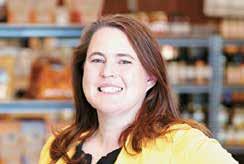

Attendees share their takeaways
What is your involvement in the dairy industry?
Williams: I am an independent dairy nutritionist with Barton Kiefer Dairy Consulting. Along with that, we also own show cattle.
Peetz: I am a part-owner of RosyLane Holsteins LLC in Watertown, Wisconsin.
Cederquist: I am the research program director for the Department of Animal & Dairy Sciences at the University of Wisconsin-Madison. I have oversite of the three dairy research facilities that the UW dairy faculty utilize for their studies.
Kepner: I am a nancial ofcer at Compeer Financial ACA serving the northern part of Sauk County and all of
Juneau, Adams and Marquette counties. I have clients in the dairy industry and help them with their lending needs.
Moore: My husband, Brandon, and I own and operate Moore Family Farms, a diversied dairy and livestock farm, where we background feeder cattle, milk 40 registered Holsteins, and also raise laying hens, broilers, hogs and goats. We also process our own milk at Moore Family Farms Creamery and market through our two farm-totable shops, Moore Local. We are also partners in Rockdale Locker, a stateinspected meat locker.
Ruzic: I am an account manager for Wisconsin and part of Minnesota for Zinpro, as well as a dairy and crop farmer. We are transitioning out of the dairy business but will continue to cash crop 400 acres.
The PDP Cornerstone Dairy Academy graduates include:
Kelsey Birschbach, Rosendale, Wis.
Angela Bright, Middleton, Wis.
Jessica Cederquist, Madison, Wis.
Jordan Crave, Waterloo, Wis.
Nate Goeldi, Rochester, Minn.
Alison Kepner, Baraboo, Wis.
Filadelfo Lopez, Kiel, Wis.
Kristen Metcalf, Milton, Wis.
Maria Meyer, Loyal, Wis.
Heron Mireles, Chili, Wis.
Heather Moore, Maquoketa, Iowa
Jason Nemec, Spencer, Wis.
Kiley Pagel, Kewaunee, Wis.
Sam Peetz, Watertown, Wis.
Nicole Pralle, Humbird, Wis.
Eliza Ruzic, Greenwood, Wis.
Sarah Schalk, Waldo, Wis.
Rick Schultz, Palmyra, Wis.
Alex Volovsek, Greenwood, Wis.
Nathan Watson, Stevens Point, Wis.
Amanda Williams, Shawano, Wis.

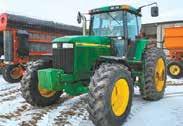

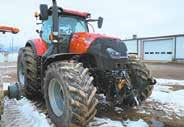


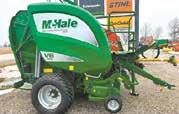
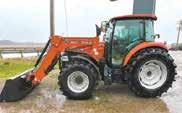












Page 26 • Dairy Star • Saturday, May 11, 2024 820 W. MAIN ST. • CHILTON, WI 53014 920-849-9304 www.ddequipment.com WE ALSO CARRY THESE BRANDS: John Deere 6300 $19,900 John Deere 7810 Tractor $69,500 CIH Magnum 340 $247,900 CIH Optum 300 CVT Tractor $208,900 New Case IH Puma 240 CVX Tractor Call for Pricing New CIH Farmall 120C w/Loader Call for Pricing New Massey Ferguson MF2850E Call for Pricing Parker2620 Seed Cart Call for pricing Parker 1020 2 Box Seed Cart Call for Pricing McHale V6-750 Round Balers Starting @ $56,000 NewPottinger 8001T Terra Disc. Call for Pricing John Deere 990 Round Baler $34,000 New Manitou M30-4 Forklift $87,500 NEW & USED EQUIPMENT Turn to CORNERSTONE | Page 27
Amanda Williams Shawano, Wisconsin Shawano County
Heather Moore Maquoketa, Iowa Jackson County
Eliza Ruzic Greenwood, Wisconsin Clark County
Sam Peetz Watertown, Wisconsin Jefferson County
Jessica Cederquist Madison, Wisconsin Dane County
Alison Kepner Baraboo, Wisconsin Sauk County
What is your background?
Williams: I live in Shawano with my husband and three children. I grew up in the southwest corner of the state on a small cow-calf operation along with cash crops. My grandparents were registered Holstein breeders and lived right up the road. It was through them that I fell in love with the Holstein cow. I started showing with them as soon as I was old enough to in 4-H and bought my rst heifer when I was 11. I have owned cattle since that point. I worked on numerous dairy farms through high school and college. I graduated from the University of Wisconsin-Platteville with an animal science degree with a double emphasis in agricultural business and dairy science. Once out of college, I worked at two separate feed mills doing feed sales and nutrition work before buying my grandparents’ herd when my oldest was born. I farmed full time with two littles in tow until the pandemic hit. We were in the process of buying the entire farm at that time. The uncertainty that came with that period led to the decision to sell the majority of the herd and hobby farm while both working off the farm. It was then that we relocated to northeast Wisconsin. I now get the opportunity to help many dairy producers through my nutrition business while raising cattle for my kids to show.
Peetz: I grew up around my family’s dairy farm that became a cash-crop farm when I was in elementary school. Outside of an ofce job at an engineering rm, the summer after I graduated from high school, every internship or part-time job I’ve held has been in the dairy industry either on-farm or in a sales/consulting role. In 2020, I graduated from the University of WisconsinPlatteville with a degree in dairy science and agribusiness.
Cederquist: I hold a master’s degree in animal science from the University of Arizona. Over the course of the last 16 years, I have held several on-farm management type roles and worked for a short time as a dairy nutrition consultant. I have been with the University of Wisconsin for over nine years. I was involved in 4-H as a child but did not really get involved in the dairy industry until I started at the University of Arizona in 2001. My rst summer in college, I took an internship on a large commercial dairy farm in Staneld, Arizona, and I was hooked. I never looked back and have been working in the industry in some capacity since then.
Kepner: I grew up on a hog and cash grain farm in northern Illinois and received a bachelor’s degree in business with a major in nance from Northern Illinois University. I’ve worked for Farm Credit for 11 years in the same lending role. I love working with farmers in the counties I serve because there is a wide variety and every day is different.
Moore: Brandon and I met at the University of Wisconsin-Platteville, and I moved from Wisconsin to Iowa after graduation, where we started a rstgeneration stock cow farm. We began dairying in 2014, opened our rst shop in 2017, our second shop in 2021, and the locker and creamery in 2022.
Ruzic: I grew up on a small, registered dairy farm in eastern Wisconsin. I got a bachelor’s degree from the University of Wisconsin-Madison in dairy
science. I moved to central Wisconsin upon graduation where I was a dairy nutritionist for over 13 years. I joined Zinpro over three years ago and have been supporting nutritionists and farmers ever since.
What led you to participate in the PDP Cornerstone Dairy Academy?
Williams: I had heard many great things about the PDP Cornerstone Dairy Academy from a client of mine that had participated. In the years since selling the cows, I had been focusing on personal development. Cornerstone Dairy Academy was just the thing to continue with some professional development. The more I can improve myself, the more value I can bring to my clients and their operations.
Peetz: I heard about it through word of mouth and had a desire to polish off some soft skills when leading teams. I knew the academy could help me with this.
Cederquist: In my role at UW, leadership in a lot of different capacities is necessary. I work not only with my staff on the farm but also with a large variety of students, researchers, scientists, faculty and industry professionals. My boss had recommended this program to me as a way to grow in my management techniques and thought it might be helpful in learning to manage the large variety of people I encounter.
Kepner: As a relatively new employee in 2015, I was encouraged to apply for the Cornerstone Dairy Academy by my boss at the time. I completed two of the three pillars by 2017 and then took a small break to nish the third pillar in 2024. I enjoy listening to the different speakers that Cornerstone has teaching the program.
Moore: In 2021, I decided that I needed to broaden my professional development horizons with the expansion of our businesses. I have continually been impressed with PDP’s programming, so I thought that the Cornerstone Dairy Academy would be the place to start.
Ruzic: Zinpro has had a strong partnership with PDP for many years, and I thought it would be a great way for me to improve my leadership skills and learn about other areas of the industry that I’m not as familiar with.
What did you learn from that involvement, and how will you use that going forward?
Williams: Participating in all three pillars gave me a well-rounded experience. I gained more knowledge on leadership, not only leading a team but also myself and family. Each pillar broke down different aspects of leadership and gave applicable strategies to take back to your teams and customers. Real-world examples made it a seamless transition to use these skills in day-to-day interactions. Another thing I found benecial was the training on working with different generations. As an agricultural professional calling on many multi-generational farms, knowing how to best communicate with each generation has had a positive impact on how I communicate with my clients and prospects.



























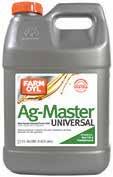






















Dairy Star • Saturday, May 11, 2024 • Page 27 •High Quality 16 oz. Vinyl Curtain Material •Keder Tubing • Galvanized Bird Wire •Manual Gear Drives or Electric Motors Control your curtains with automation. Programmable based on temp, humidity, wind direction and speed. Specializing in: •Clear View •Double Roll Up •Center Roll Up •Drop & Roll Curtains Industry Leader in Ag Curtains 13177 Dunbarton Rd. • Gratiot, WI Freestall Barns - New & Remodel Calf Buildings • Heifer Sheds • Curtain Removal Pole Sheds • Roofs • Repairs s SEVEN YEAR YEAR Durable Ag Curtain Systems for the Modern Dairy Barn FREE SHIPPING if ordered by July 1, 2024! A&C Farm Service, Inc. Jct. Hwys. 55 & 23 • Paynesville • 320-243-3736 www.acfarmservice.com A popular, long wearing design. These sweeps have a dimple to protect against premature bolt wear and have an extended nose for longer wear and better penetration. Constant width wings will cut the same width from new until they wear out. Made of quality boron steel that is heat treated for long life. HUGE SAVINGS ON HERSCHEL SHOVELS! 15% OFF ON ALL OILS! Fit Nicholas Clips PREMIER 15W-40 55 GAL. DRUM $89700/DRUM $74700 $1195each NEW FIELD CULTIVATOR SWEEPS DARE TO COMPARE OTHER BRANDS! After rebates and discounts: /DRUM CAMar16-1B-MS
nued from CORNERSTONE | Page 26
Con
Turn to CORNERSTONE | Page 29

Disc Mower Parts








W4116







































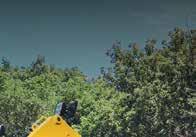


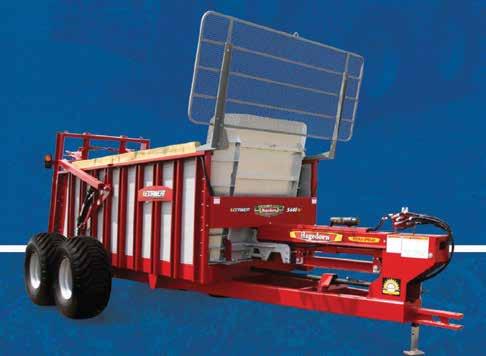



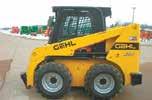
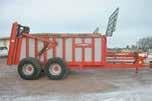

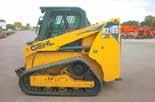
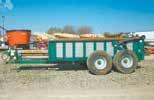
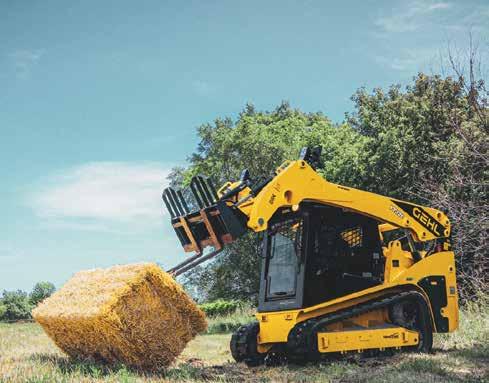




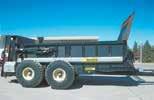


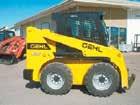



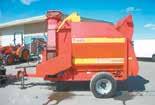
Page 28 • Dairy Star • Saturday, May 11, 2024 WHO WILL YOU FIND IN OUR Business Directory? TO BE INCLUDED IN THE DAIRY STAR BUSINESS DIRECTORY CALL 320-352-6303 LOG ON TO: www.dairystarbusinessdirectory.com Bob Meyer Master Electrician, Owner Cell: 320-761-1042 Need an Electrician? We Offer the Following Agricultural Services: Barn Lighting, Sheds, Fans, Trenching, Irrigation, Homes & More! Lic. #CA03435 Serving Central Minnesota E lectric B.E.A.M. ELECTRIC (2) HAGEDORN HYDRA-SPREAD EXTRAVERT 5440, 684 Cu Ft Heaped, 440 Cu Ft Struck, Sequence Valve Flow Ctrl, Wood Rails, Stone Guard, Endgate Starting at $39,500 MEYERS VB750 600 Bu, 482 Cu Ft Struck, Vert Beaters, 5 Pt Digi Star Scale, Nutra Tracker NT Scale Head, No GPS Puck Included $46,500 ‘15 LUCKNOW 1420 420 Cu Ft, RH 3’ Dump, Digi Star 2500V Scale Head, Light Kit $19,500 GEHL V400 T-Bar Ctrls, Dsl, 4000 Lift Cap, C/H/A, 2 Spd, 2,570 hrs. $37,750 HAGEDORN HYDRA-SPREAD 225 425 Tires, 425 Bu. $11,900 ‘19 GEHL RT165 ISO/JS Ctrls, Dsl, 15 1/2 All Season Tracks, Lift Cap 1800 @ 35% And 2400 @ 50%, C/H/A, 2 Spd, 1,758 hrs. - $41,750 ‘12 Teagle Tomahawk 8080WB Up To 5’ Wide Bales, With Spout and Blower, Cab Controller - $12,500 ‘21 GEHL R220, T-Bar Ctrls, Dsl, C&H, 2 Spd, 2,970 hrs $32,000 Tubeline TL1700SR Square Bale 3’x3’ Up to 7’ Long, Round Bale 4’x4’ To 5’x6’, Twin Bale Wrap Stretchers $27,500 ‘18 GEHL RT165 JS Ctrls, Dsl, 15” Tracks, 2000 Lift Cap, C/H/A, 2 Spd, 1,103 hrs. $44,900 ‘19 GEHL V270 JS Ctrls, Dsl, 2700 Lift Cap, C&H, 2 Spd, 250 hrs. $57,500 ‘22 GEHL R220 T-Bar H-Ctrls, Dsl, 2500 Lift Cap, C&H, 2 Spd, 4,012 hrs. $36,900 northlandfarmsystems.com Feeding your fields can take a toll on your equipment. Manure is a heavy high stress inducing load that puts high strain on your spreader, not to mention it rusts whatever it touches. That’s why Penta’s Hagedorn spreaders use high strength poly boards, galvanized end and push gets, to stand up to the loads and fight rust.So you can feed your fields for years to come. PROVEN PERFORMANCE *Offer subject to change. Available on select GEHL skid/track loader models. See dealer for details.
New & Used Parts Available
Wanted Disc Mowers for Salvage
We Ship Parts Spee Dee
•
•
•
Starks Road, Loyal, WI 54446
PEIFER
(No Sunday Calls) e
TITUS
715-937-7537
| Page 27
Peetz: Each pillar reiterated the importance of emotional intelligence and professionalism in the workplace. I use concepts related to that every day as I work with groups of people doing their best to care for cows, calves and land.
Cederquist: Every pillar brought new ideas and thoughts. It truly made you think and reect on how you handle yourself in the workplace. To be a good manager and good leader, you truly do need to be able to read the room around you and play to the strengths of the people you are working with. The academy focused on teaching you how to do this in a variety of ways. Whether there be generational differences, gender differences or commitment differences in your workplace, everyone has the ability to be successful if they have the right leadership to get them there. I nd myself often thinking about something I learned during the academy when I am encountering a new person, or new obstacle, and question myself on whether or not I am taking the right approach. Sometimes, the answer is, “Absolutely, yes I am.” But, sometimes I have to reect on what is happening around me and give it a second thought. Being able to do this has helped me improve my skills and allows me to communicate effectively with a lot of people around me.
Kepner: Personally, my favorite pillar was the servant leadership pillar with Tom Thibodeau. I always enjoy hearing him speak and sharing his personal stories growing up on the farm and other extracurricular activities. The


in
uential leadership pillar was very interesting, learning about etiquette, communication, conict resolution and teamwork. During the visionary leadership track in 2024, the information Dr. Kohl spoke about is invaluable when thinking about the economy, interest rates and how the export market impacts so much. Dr. Kyte also provided great information about living an ethical life and nding your third place.
Moore: The Cornerstone Dairy Academy is an incredibly useful tool as we continue to grow our business. The lessons learned continue to be integral as we work with our most important resources: our people. All three tracks were phenomenal, but the visionary leader track really helped us to set goals for the future of our business. The servant leader track’s inuence was simply indescribable. I actually went home and had a workshop with my kids on how we can show love to each other through our actions.
Ruzic: I learned so much during each of the three pillars, but the recurring theme throughout all of them was making connections with people and being grateful. All of our facilitators did a great job making us think about how we show up at work, at home and in the community, and how we can adjust our leadership style based on the group we’re working with. From learning about how to be a servant leader to proper etiquette, global market inuence and working as a team, each
pillar had something to take home and implement no matter what our place is in the industry. I will use what I learned in my career, at my farm and in my family long into the future.
What would you tell prospective students to encourage their participation?
Williams: If you are considering applying, I would tell you to denitely go for it. You will never regret investing in yourself. As an added bonus, the networking opportunities are endless. There is something to be said about being in a room full of like-minded people who are trying to better themselves.
Peetz: PDP Cornerstone Dairy Academy brings real people together to talk about what soft skills they struggle with on farms and the businesses that support farms. The people in the room also wish to get better, so it is a good atmosphere of dairy-minded folks looking to improve how they treat others every day.
Cederquist: Do not ever think that you have nothing to learn. Do not ever think there is no improvement that you can make in yourself or in your leadership style. The world around us is always changing and evolving. We have all learned over the past four years how quickly our lives can change, and we have been forced to take a pause and rethink what is important around us. Being a good leader is taking the

time to remember what being a good leader means. This Cornerstone Dairy Academy will help to reset, refocus and refresh your leadership style and skills. It is absolutely worth the time and effort on your part. Invest in yourself. You won’t regret it.
Kepner: All in all, every pillar is great, and I would encourage anyone in the agricultural industry to apply for the academy. The PDP conference following the Cornerstone Dairy Academy offers top-notch breakout sessions and relevant dairy industry knowledge.
Moore: If you’re on the fence about the Cornerstone Dairy Academy, don’t be. Try your rst track, and I can guarantee you’ll be back to nish the program out. PDP’s programming is visionary but also boots-on-the-ground real. Every time I leave a PDP program, I have a set of real and actionable steps to improve our farm business, our off-farm business and, of course, our life as a whole.
Ruzic: You won’t regret taking the time to invest in this program. The connections you make and the skills you learn will help you no matter where your career goes in the industry or on the farm. The facilitators make the sessions fun and interactive, and the staff at PDP are helpful with logistics. I would recommend it to anyone in the dairy industry, whether you’re young in your career or more tenured. Either way, you’ll come away with skills to implement in your everyday life.

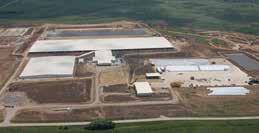






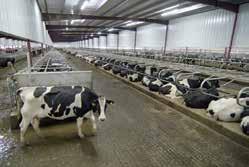


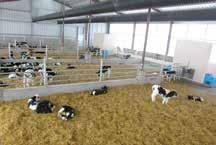


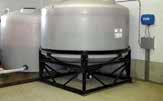















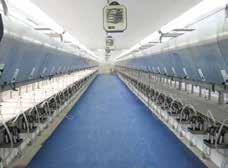


























Dairy Star • Saturday, May 11, 2024 • Page 29
CORNERSTONE
Con nued from

Heifer inventory, management
is no secret that on-farm nances are tight. According to FINBIN, the overall median net farm income for Minnesota farms fell to $44,719 in 2023, marking a return to the challenging levels faced by farmers from 2013 to 2019. This begs the question: What strategies help manage expenses on dairy farms?
In late winter, a number of dairy farmers in Minnesota took part in dairy producer night out events held by the University of Minnesota Extension and Minnesota Dairy Initiative. During a presentation from farm business management, a robust discussion developed around heifer inventory and management. The estimated cost to raise a heifer calf from birth to calving ranges from $1,700 to $2,400. This number can vary from farm to farm with differences in feed cost and availability, labor, breeding, health and other miscellaneous expenses.

shown that having too many heifers on hand is not economical for the viability of the farm. In fact, exceptionally managed herds raise 70%-80% of the cow herd.
For herds with lower heifer replacement numbers, the following factors are actively managed:
— Optimizing herd’s turnover rate based on the farm’s management and goals.
By Karen Johnson University of Minnesota
— Strategically using sexed semen on elite cows to advance the genetics of the herd. Semen is selected with focus on fertility.
— Use of beef semen for lower genetic animals, especially for Holstein breeders with a strong market for Holstein-beef crossbred offspring.
— Maximizing facility space without overcrowding.
— Optimizing the feeding program to quickly grow heifers to the desired height and weight for breeding.
How many heifers should a farm raise to be replacements in the milking herd? Several years ago, the recommendation was to have at least one heifer for every cow in the herd, milking and dry. More recent years have
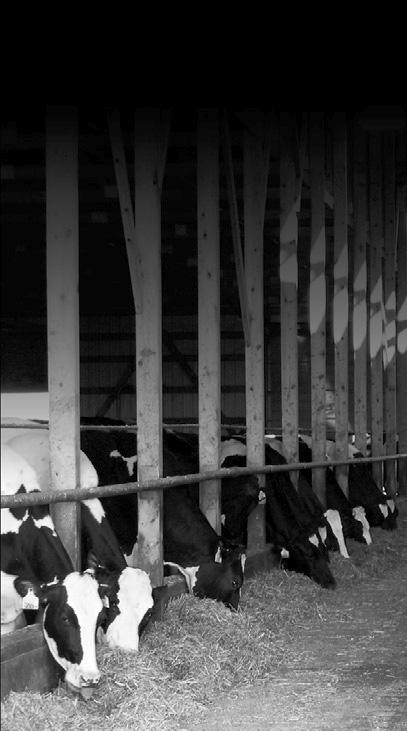
— Age at rst calving of 22 to 24 months. Raising heifers beyond the recommended age at rst calving results in increased days on feed and decreased lifetime milk production.
— Focus on reproduction (fewer
TRUST THE EXPERTS
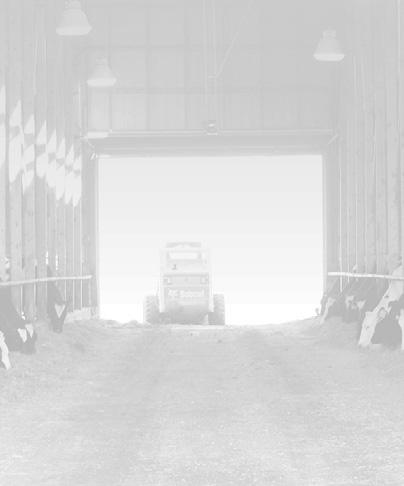







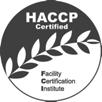




days open and high conception rate) and longevity of the milking herd. Mature cows tend to produce more milk.
— Selling extra heifers early in life, before investing money and inherited risk into raising them. Oversupply of replacement heifers can serve as a revenue stream especially during stronger Minnesota dairy replacement heifer prices.
— Culling heifers that have experienced signicant health events, such as respiratory illness. Research has shown that respiratory illnesses create permanent damage in the animal resulting in less overall productivity and increased chance of secondary illnesses.
For many farms that are maintaining herd size and using home-grown heifers, the number of replacements needed to enter the milking herd each year is equal to the predicted number of cows being culled.
Daily preventive management practices have improved the health, productivity and welfare of our cows. This has created an opportunity to maintain the value of our cows without issues that would cause premature
Dana Adams adam1744@umn.edu 320-204-2968
Joe Armstrong armst225@umn.edu 612.624.3610
Luciano Caixeta lcaixeta@umn.edu 612-625-3130
Gerard Cramer gcramer@umn.edu 612-625-8184
Marcia Endres miendres@umn.edu 612-624-5391
Les Hansen hanse009@umn.edu 612-624-2277
Brad Heins hein0106@umn.edu 320-589-1711
Nathan Hulinsky huli0013@umn.edu 320-203-6104
Karen Johnson ande9495@umn.edu 320-484-4334
Emily Krekelberg krek0033@umn.edu 507-280-2863
culling.
No matter the cow, culling decisions is one of the toughest decisions on the farm and should be done on a cow-to-cow basis. It is important to keep in mind that it can take two or more lactations to pay off the cost to raise a heifer. Be careful when making decisions to cull an older cow simply because you need the room for a heifer in the milking herd. Monitor cows for milk production, reproduction and overall health. Once the value of the cow drops below the desired benchmark for your farm, timely culling and use of replacement heifers maximize your farm’s economic returns.
Determining replacement needs on the farm is not easy. Many farmers choose to keep a few extra heifers as insurance to assure the future of the herd. As mentioned previously, the number of replacement heifers that are needed to enter the milking herd should reect the predicted number of cows being culled. Purposeful and timely culling decisions are vital to the economic returns for the farm. Farmers should work with their management team to determine if this is an area they can manage differently.
Claire LaCanne lacanne@umn.edu 507-332-6109
Brenda Miller nels4220@umn.edu 320-732-4435
Isaac Salfer ijsalfer@umn.edu 320-296-1357
Jim Salfer salfe001@umn.edu 320-203-6093
Mike Schutz mschutz@umn.edu 612-624-1205
Melissa Wilson mlw@umn.edu 612-625-4276
Isaac Haagen hagge041@umn.edu 612-624-7455
Michael Boland boland@umn.edu 612-625-3013
Sabrina Florentino slpore@umn.edu 507-441-1765

Barn Walls and Basement
Bunker Silo Wall and Deteriorating Barn Walls Restoration
Page 30 • Dairy Star • Saturday, May 11, 2024 www.extension.umn.edu/dairy
WISCONSIN CONCRETE RESTORATION Jetcrete Pneumatically Applied Concrete •
•
Resurfacing
Approximately 1” of steel reinforced
added to bunker walls 6 gage heavy duty wire mesh installed SERVING IA, MN, WI, IL AND SD CONTACT: 800-866-7327 • 563-586-2425 AND CELL 563-419-4279 320-836-2145 or 800-450-2145 www.famofeeds.com Check out our newly redesigned website to nd a Famo Feeds dealer near you! At Famo Feeds, we strive to provide the best support for your operation and work to accommodate your specific needs. From calf to cow and everything in between!
Silo Relining
•
material
• Milk Replacers • Starter Feeds • Protein Concentrates • Premixes • Minerals • Animal Health Products • Lick Tubs FEED THEM FAMO!
It
Control of bovine leukemia virus in dairy herds
 By Scott Wells, College of Veterinary Medicine, University of Minnesota
By Scott Wells, College of Veterinary Medicine, University of Minnesota
Bovine leukemia virus is the cause of enzootic bovine leukosis, a disease of adult cattle characterized by development of malignant lymphoma in up to 5% of infected cattle. In these cattle, lesions may be detected at slaughter and result in carcass condemnation. BLV infection also leads to reduced milk production, decreased longevity and increased susceptibility to other diseases. In addition, BLV has been shown by one research team to be associated with human breast cancer, though this association has not to date been proven as causal. While this virus causes chronic infections in cattle, most infected cattle show no clinical signs and are detected only through diagnostic testing. From the U.S. Department of Agriculture Animal and Plant Health Inspection Service estimates, BLV infection occurs at a high prevalence in U.S. dairy herds (>80%) and dairy cows (>40%).
A USDA study showed a 48% apparent BLV antibody prevalence among cattle at slaughter plants that processed mainly dairy animals and 38% among cattle at slaughter plants that processed mostly beef cattle. Control of BLV in cattle is important to reduce economic losses associated with clinical illness as well as those associated with subclinical disease (reduced milk production and cow longevity and immunosuppression) and to eliminate the potential public health risk.
Treatment or vaccination against BLV infection is not available, and lifetime infection is assumed. Diagnostic tests are available to detect antibodies to the virus in serum or milk samples; the latter is available through several Dairy Herd Improvement Association labs. While it is not typically feasible to use these antibody-based tests (ELISA) as part of a test and removal program for BLV due to the high prevalence within dairy herds, this testing is helpful to characterize herd BLV status and identify exposure to infection in individual infected cattle. Further, an additional test, a PCR assay available through CentralStar Cooperative Inc. at some DHIA labs, detects the BLV virus itself and can be used on ELISA-positive cows to identify the subset of cows at highest risk for shedding BLV which could be prioritized for removal from the herd. Another important BLV control strategy is to reduce exposure of susceptible cattle to the virus, which re-

quires understanding of the potential pathways of transmission. The primary known mode of BLV transmission is through exposure of susceptible animals to infected lymphocytes from blood, milk and colostrum from infected cattle; another pathway for infection includes semen from infected bulls. Reducing BLV transmission focuses on preventing transmission from infected, though typically normal appearing, cattle to susceptible cattle through blood, milk and colostrum. To reduce blood-borne transmission of BLV, it is important to use practices that avoid sharing of blood between animals, including singleuse needles for vaccinations and other injections, single-use rectal sleeves for reproductive exams, cleaning and disinfection of equipment for dehorning and teat removal, and control of biting ies. Stable ies, one type of biting y that can transmit BLV infection, breed in manure and other organic material and spend relatively little time on cattle, though can sometime be observed in high numbers on cattle. The most effective control is by removing breeding sites (piled organic material). Reducing colostrum and milk transmission to calves can be achieved through heat treatment to inactivate the virus.
Your herd veterinarian is a critical resource as you develop a plan. First, consider your operation’s history of previous diagnoses of enzootic bovine leukosis. Have clinical cases been previously detected? If so, cattle in your herd are likely to remain infected. Remember that most U.S. dairy herds are already infected. Next, test a sample of adult dairy cows to characterize your current herd status. A method proposed by Michigan State University researchers involves testing of 40 recently calved cows (10 each from rst, second, third and fourth or higher lactations) using a BLV ELISA, available through DHIA labs for milk samples or through veterinary diagnostic labs for blood samples. You may want to also test a sample of yearling heifers to estimate the prevalence of infection in youngstock. Your herd veterinarian can collect the blood samples if needed and guide you in this process.
If your herd is test-positive, then consider the prevalence of BLV by lactation, and use this information to evaluate the potential pathways of infection. In many dairy herds, a low percentage of cows are BLV-positive at the time of rst calving, and BLV prevalence increases with time in the herd, resulting in >50% prevalence in older cows. Typically, there are multiple pathways of transmission within the herd, and herd management should focus on the most important identied pathways.























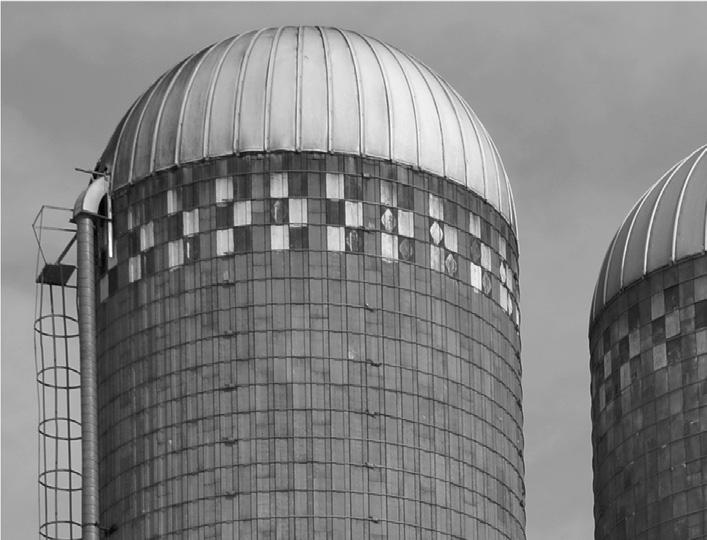













Dairy Star • Saturday, May 11, 2024 • Page 31 320-808-3936 300 E Main St. Osakis, MN 320-859-5340 Visit us online at www.osakissilo.com 24 Hours 7 Days A Week Call Anytime The Best Service Crews, The Best Replacement Parts, The Best Service... That’s The Osakis Silo Advantage To You!!! EVERYTHING SILO CALL TO SCHEDULE YOUR PROJECTS TODAY!
Don’t Fiddle Around With Your Advertising Dollars! 522 Sinclair Lewis Ave. • Sauk Centre, MN 56378 (320) 352-6303 • Fax: (320) 352-5647 LARGE SELECTION OF USED MOTORS ON HAND FROM 1-10 HP 105 County Rd. 10 • Albany, MN 320-845-4690 WWW.AMPSRS.COM New Winco 50 KW PTO unit ..................Call Winpower 25/15 PT2 w/trailer, powershaft, load cable ...........$1,600 GENERATORS We Sell and Service Generators! Each WINCO PTO generator is designed using the highest quality components and the best workmanship available. Baldor 5 HP .........................................................$450 Century 5 HP .......................................................$450 Leroy-Somer 3 HP ...............................................$350 (2) GE 7-1/2 HP ...................................................$550 DeLaval 7-1/2 HP ................................................$550 GE 1-1/2 Stirator motor .......................................$175 WE STOCK FRACTIONAL TO 10 HP SINGLE AND 3-PHASE MOTORS! • quick • dependable • nearly 40 years experience WE ALSO DO MOTOR REPAIR O New Winco 100 KW pto unit - Call
IN DAIRY women
Tell us about your family and farm. My husband, Sander, and I have ve children. Our oldest, Seth, has his angel wings, and Brooke is 22. Evan is 14, Izaak, 12, and Ethan, 9. We live in Thorp, Wisconsin, and milk 900 cows in a double-12 parallel parlor. We own and rent 1,250 acres, raising corn, alfalfa and winter wheat. We raise our youngstock on the dairy until 7 months of age, after that they are custom raised in Durand, Wisconsin. We have eight Belted Galloway beef cows from our son Seth and a bull named Pluto.
What is a typical day like for you on the dairy? I am a crop insurance agent of 26 years and work out of my home ofce. I assist my husband with daily management on our dairy. My day consists of many tasks at any given time. I love my role as I get to be part of our day-to-day dairy farm, helping where needed as well as working with other farmers through crop insurance. I love the variety of my day, and best of all, I am never bored. If I get bored there’s always more work to do.
What decision have you made in the last year that has beneted your farm? Contracting milk through various risk management tools has beneted us. I tried to diversify my contracts and got lucky this last year. We have been able to capture extra revenue during these months of lower milk prices.
Tell us about your most memorable experience working on the farm. We used to have our dry cows in a pasture by the farm. We would walk the pasture at night to check for calves. When our two oldest were young children, we would stop and take time to lay in the pasture and look at the stars. It was a time to stop, reect and enjoy the moment. There were times we watched the northern lights as well.
Amy Penterman Thorp, Wisconsin Clark County 900 cows
What have you enjoyed most about dairy farming or your tie to the dairy industry? It is rewarding to know you are providing food to our nation along with caring for the land. I love that we can raise our children with a strong work ethic and teach them the importance of farming. There are so many good people in the dairy industry. It is enjoyable to network, create friendships and have a little fun too.
What is your biggest accomplishment in your dairy career? I was the rst female president of Dairy Business Association. I believe in advocating for dairy in our state and country. The way our dairy is structured, I am able to leave the farm to advocate. I feel compelled to have our voices heard in Madison and Washington, D.C.
What are things you do to promote your farm or the dairy industry? We host many farm tours. This year, we are hosting the dairy breakfast. We have a corn maze in the fall, and we have a farm Facebook page.
What advice would you give another woman in the dairy industry? We are all busy running in many directions, so make time to stop and enjoy the moment, even if it is just for ve minutes. I try to take time with my kids and enjoy the beauty of what we get to do every day. Take time for yourself. Get a pedicure, a facial, your nails done or a massage, etc. Do not put yourself last. You deserve pampering every once in a while. If you can, get someone to clean your house. Dairy farming, no matter how you are involved, is time consuming. Hire someone to help take the burden off you when you get home.

What is a challenge in the dairy industry you have faced, and how did you overcome it? Our barn roof collapsed in 2023 after a heavy, wet snow storm dumped 27 inches of snow. We lost 180 feet of our freestall barn. We had to move 200 cows to a different farm. Thankfully, we did not lose any cows. It was a stressful time. It took longer than expected to rebuild. My husband and I had to work as a team and keep each other motivated on our down days. We made it
through, stronger than ever. Farmers face adversity every day, but I truly believe as a dairy community, we face the hardest of times with a positive attitude and come out better from it.
When you get a spare moment, what do you do? What is a spare moment? Our boys keep us busy with their sports in our spare time. However, my husband and I try and get away on date nights once in a while. I do enjoy a nap if I can catch one.


















































Page 32 • Dairy Star • Saturday, May 11, 2024 HAPPY Mother’s Day! We repair all makes and models of ATVs, side by sides, snowmobiles, chainsaws, lawn care equipment, etc. ELECTRIC MOTOR SALES & SERVICE Full time technician on site Mon.-Fri. 8-5 REPAIR Hwy 25 • Pierz • 468-2168 snowm y LITTLE ROCK, MN 320-584-5147 PIERZ, MN 320-468-2168 LASTRUP, MN 320-468-2543 BUCKMAN, MN 320-468-6433 FOLLOW US ON FACEBOOK! www.sunriseagcoop.com Mowers & Tillers We have fly control additives, minerals, milk replacers, sprays, pour-ons, bait and more! per ton when you buy one ton of Hydro-lac! Fly Season ydrolac! dr CHICK ORDERS! PLACE YOUR Zero Turn Mowers & ATTACHMENTS Z JSV 6400 side by side CALL Little Rock & Lastrup for all your spring seed needs! SAVE $40 B A L E B E D D E R S COMMITMENT • QUALITY • DURABILITY • RESULTS Visit www.silverstarmetals.net for details and options on attachments Dealer Inquiries Welcome SILVER STAR METALS LLC N15435 Frenchtown Ave., Withee, WI 715-229-4879 New LARGER Bale Bedder Universal skidsteer hookup Cut up your bales for better bedding or feeding Round or Square Bales • Corn stubble • Soybean stubble • Straw • Baleage • Dry hay Fits in smaller areas than pull behind shredders Roun • • Soyb Stra Bale • Fi small tha be shre SILV Now handle 5x6 round bales • Hydraulic driven • Includes 1 year warranty
DANIELLE NAUMAN/DAIRY STAR
Amy Penterman kneels with her dog May 7 in her family’s freestall barn at Dutch Dairy near Thorp, Wisconsin. The Pentermans milk 900 cows on their Clark County dairy farm.
Dreaming of a dairy farm
Prieves seeking an opportunity
By Danielle Nauman danielle.n@dairystar.com
WAUSAU, Wis. — Paul Prieve did not grow up on a dairy farm, but he did grow up helping on his uncle’s dairy farm just down the road from his family’s home.
The experiences he had at a young age sowed seeds that grew into a love for dairy farming — a passion he hopes to pursue again.
“Dairy farming is something I really enjoy — the satisfaction of doing something for yourself, reaping the benets of your own work,” Paul said.
Paul’s afnity for the dairy industry grew through participation in dairy projects in both 4-H and FFA.
“I was only 5 or so when I learned how to milk cows on my uncle’s farm,” Paul said. “As a kid, I would show up early for chores in the mornings, sometimes before my uncle had even gone out to the barn.”
Paul and his wife, Sandy, live in Wausau but have been searching for a place where they can establish a dairy farm of their own.
“I have no dairy farm experience myself, just learning what Paul has taught me
and watching and observing,” Sandy said. “Being with the animals, out in the country, not being in town, would be wonderful.”
Paul, who works in a factory in Wausau, has worked on several dairy farms, both large and small. He also managed his own dairy farm for several years in the early 1990s. He has also worked as a truck driver.
“The people I was renting from at the time had retired from farming and gotten jobs in town,” Paul said. “After a while, they were ready to retire from those jobs and decided they didn’t want the noise of cattle and an active dairy farm around during their retirement.”
Paul dairy farmed for about four years. He said he longs to go back to farming full time.
“When I was dairy farming, I milked about 35 cows,” Paul said. “The herd was a combination, with a little bit of everything. It was mostly Holsteins with a few Ayrshires and a Jersey or two in the mix.”
Paul’s ideal dairy farm would be home to about 50 cows. He said any size, shape and color would suit him ne.
“Farming by myself, 50 cows would be a good number,” Paul said.
Paul said he enjoys all as-
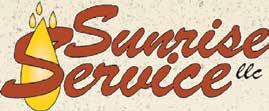

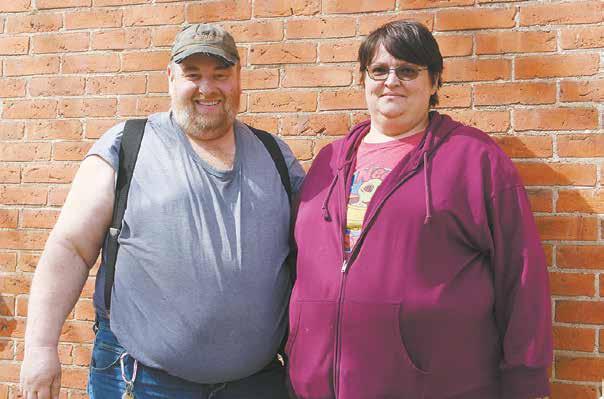
pects of farming, but the cows are his rst love.
“When I farmed, I did everything, and if I could nd a farm that I could buy with the equipment, I would do everything myself,” Paul said. “But quite honestly at this point, I’m not going to invest a whole lot in equipment. I would rather focus on the cows and hire out the crop work or buy feed.”







While he would not necessarily shy away from starting a farm from scratch, Paul said nding a farmer who is ready to phase into retirement but has no one to take over a farm would be an ideal situation.
“There is a lot to be said for an arrangement like that,” Paul said. “A dairy farmer can feel good that their farm will continue. Coming into a situa-
tion with cows and a milk market makes starting a whole lot easier.”
While most of their family is located in central Wisconsin, Paul and Sandy are open to other possibilities.
“This is home, and I would like to stay in the area,” Paul said. “But, if the right opportunity came along, I want to dairy farm just as much.”



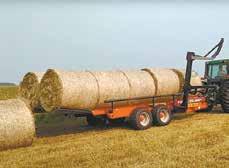



Dairy Star • Saturday, May 11, 2024 • Page 33 Call Us At (715) 223-3361 Or visit us on-line at www.cloverdaleequip.com N13835 County Rd. E - Curtiss, WI 54422 HOME OF THE CLOVERDALE MIXER McHale Balers Built to last and developed on some of the world’s most rugged terrain, the McHale range of round balers are known throughout the world for durability, reliability, innovation and value for money. Cloverdale Mega Round Bale Carrier Self-Loading & Unloading Heavy-duty 10 or 14 Bales Round bales up to 6’6” diameter Pick-up wet or dry hay Loading arm adj. for 4’ or 5’ bales Walking tandem axle with flotation tires Anderson Wrappers The multi-purpose Anderson’s wrappers are designed for round or square bales. No need to get out of the cab anymore to select or change the wrapping configuration. Models include single bale wrappers or inline wrappers for multiple bales. Get Ready for Haying Season New & Used Available Equipment LLC Starting at $28,500 Call $22,500 $20,500
DANIELLE NAUMAN/DAIRY STAR
Paul and Sandy Prieve stand in front of their home April 22 in Wausau, Wisconsin. The Prieves dream of nding an opportunity that allows them to return to the dairy industry.
From the farm to Dairy Star
Hello, readers. I am Sarah Middendorf, daughter of Steve and Julie Middendorf. I started working for Star Publications in the middle of February as the special sections coordinator and recently started writing for Dairy Star.
I graduated from North Dakota State University in May 2023 with a bachelor’s degree in animal science. Now, you may be wondering, what are you doing working for Star
 By Sarah Middendorf Staff Writer
By Sarah Middendorf Staff Writer
Publications with an animal science degree? Well, to be honest, I don’t exactly know how I got here, but I am sure happy I made it.
I get to put my degree to good use when I work on my family’s farm. I tend to spend most of my spare time there. My family milks around 200 cows with three Lely robots near Sauk Centre, Minnesota.
I am the youngest of ve sib-
lings. Along with my siblings, Leah, Ben, Spencer and Zach, I have one brother-in-law, Brad, and two sisters-in-law, Meghan and Alex. I am also blessed to be called auntie by two nieces, soon to be three, and a nephew.
On the farm, you can usually nd me helping my mom feed calves, picking eggs or helping my dad or Ben with random chores.
My mom and I have this routine. We feed the calves in the yard before nishing our chores in the barn, which is located on the opposite side of the grove. Once we drive the truck up to the barn and park it, we seem to end up, accidentally, sitting in the truck for way too long talking about the most random things.









Stabilize the Rumen and Maximize Energy
P-One, the microbiology, is fed daily and contains eight of our meticulously researched and developed Priority Smartbacteria strains. These strains stimulate lactic acid utilization in the rumen and maintain a healthy population of beneficial bacteria in the lower intestinal tract.
When I was younger, growing up on the farm was great, but I didn’t appreciate it like I do now. Some may think my mom and I sitting in the truck talking is a waste of time. To me, this is time I will cherish forever.
Growing up on a dairy farm means long days, early mornings, late nights, hard work, blood, sweat and tears. To me, it also means family, bonding, laughter and endless smiles with those you love.
Being the youngest of ve, I learned a thing or two from my siblings. One of these being the best way to cool off on a hot summer day or at least cool off each other. This is otherwise known as having a water bucket ght. Yes, that’s right. I said water bucket.
There were countless times during the summer where we would ll up a water bucket and dump it on each other. We always snuck up behind each other to dump our bucket of water on one another, fully knowing they would get you back for that later.

A proprietary combination of Seaweed derived ocean calcium, magnesium, and numerous other minerals act as a Smart bacteria catalyzer, thus creating the near perfect natural environment to initiate bacterial growth in support of


Another thing I learned from my siblings is how to milk cows at the young age of 7. Back in the day, we milked around 100 cows in a tiestall and stanchion barn while switching around half of them in the back 10 stalls of the barn. For some of my siblings, me being able to learn how to milk meant they didn’t have to anymore.
The dairy industry has always been a place I like to call home and will continue to be that place for me and for many others.
Page 34 • Dairy Star • Saturday, May 11, 2024 P-One TM & Ocean Minerals TM the Smart bacteria catalyzer Microbiology Nutrition with Smart bacteria
Microbiology Nutrition.
INDUSTRY FIRST the Smartbacteria & Nutrition CompanyTM 920-682-0264 priorityiac.com ©2024 Priority IAC, Inc. All rights reserved.
Editorial disclaimer: The views expressed by our columnists are the opinions and thoughts of the author and do not reect the opinions and views of Dairy Star staff and ownership.
My little town
I
rst came to Cambridge, Wisconsin, almost 30 years ago. I remember the downtown resembling a Norman Rockwell painting. The population was at 900 for a long time. There was only a Main Street lled with little shops and people shopping every day until 5 p.m. Since most of the store owners were the shopkeepers, they closed to be with their families who lived nearby.
Cambridge was a destination place. Coach buses brought senior citizens for shopping in the cute establishments that were very unique. Restaurants served great food, baked their own desserts, had many avors of ice cream and made homemade fudge. The bakery made its own bread, donuts and cookies daily. The lights would be on at 4 a.m. because someone was frosting the donuts.
All but the potters who live and work in Cambridge. Their studios are at their homes where they make amazing pottery with their own styles and glazes. Many of these artists work year-round to make enough pieces for the special events they have created to bring people to their homes and studios. They invite guest potters from other places to share the space to allow them to sell their pieces too. This collaboration is such a great opportunity for all of them to get together and sell direct to the people who love their work.
 By Tina Hinchley Farmer & Columnist
By Tina Hinchley Farmer & Columnist
Across the street was a store that sold Norwegian sweaters, imported wines and cheese, and taffy that was made at the candy factory — not to be confused with the tiny candy shop that sold amazing chocolates. Nearby was a place my children loved to go to with handpainted toys and gifts from Mexico made by other folk artists from far away. Climbing up wooden stairs, you found the old lime rock building to the jewelry store that made custom rings and necklaces and sold sparkly crystal pendants that hung from the ceiling near the window. My girls loved to see all of the rainbows that were cast from the prisms around the room.
The other favorite shop was the Lilliput shop. It had miniature everything for a doll house or shadow boxes. They had the tiniest cups and items that were shrunk to ll the teensy weensy cabinet in the itsy bitsy kitchen. There were little kits to make grand doll houses with real windows, wallpaper and carpet. This store was busy all the time, just like the Ben Franklin store that sold anything and everything.
One of my dear friends owned a little ower shop, and her children were the same age as mine. Opening the door to the shop, a breath of fresh roses and lilies would swallow us up. She worked to make amazing oral arrangements while stripping off leaves and clipping stems that fell to the oor around her feet. She was the go-to person who hung the evergreen roping on the lamp posts for Cambridge Country Christmas. She would be out in the middle of the night, with coils of roping and premade real bows, hanging and wiring them with perfect loops and curves. She had to work at night to avoid any mishaps with shoppers under her ladder. I was with many years, holding the ladder and having a good time. Her family had always lived in Cambridge, and she knew everyone.
The historic buildings that were an old mill and wagon factory were converted into shops that sold items that were so special that visitors would drive for miles to pick them up. This area in Dane County was known for its pottery and artist community. There was Rowe Pottery and also Rockdale Union Stoneware, and they sold pottery in stores right next to each other. On the road heading out of town was Cambridge Pottery. Nearby there are more homes and studios where these potters live and work to create their own unique pieces that were glazed with their stamped signature on the bottom of every piece made. This community had a reputation of great potters to make the wares sold in the shops. Annually, there was a pottery festival that drew hundreds of potters and thousands of visitors to watch and participate in the U.S. pottery Olympics. I met many potters at this event that lived all around the U.S. and abroad who brought in their pottery to share from far away villages.
Those are special memories of the old Cambridge. The bakery is standing empty with brown paper over the windows, the stores now have no charm, and many are vacant. The restaurants have changed owners, and it isn’t where we choose to eat anymore. This is the story of many downtowns after years of great times. Now, all of the shop owners have sold their shops, retired and moved away.
This past weekend was the 12th annual Clay Collective Spring Driving Tour. My daughter, Anna, and our intern from Finland, Aada, and I drove around to the homes and studios of the potters to say hello and purchase a beautiful piece of pottery. Walking up, I
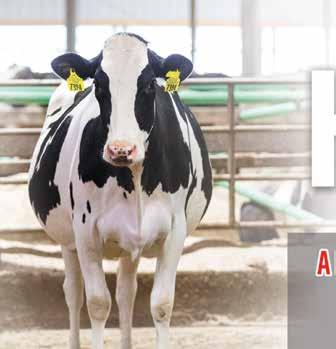


noticed we all have more grey hair, we stand with our shoulders hanging a little lower, and everyone is happy to see us. We are all old friends and greet each other with hugs. They have watched Anna grow up and notice she is with me. The conversations extend to their children and what a lovely day it was to be out at their studios. We picked out items that we love to look at. We will use these items and remember that it was made by each one of these artist’s hands, from start to nish.
Tina Hinchley, her husband Duane and daughter Anna milk 240 registered Holsteins with robots. They also farm 2,300 acres near Cambridge, Wisconsin. The Hinchleys have been hosting farm tours for over 25 years.

As you invest in fewer replacement heifers, additional focus must be placed on creating cows that stay healthy with reduced challenges of mastitis and lower Somatic Cell Scores. The Herd Health Profit Dollars® (HHP$®) index is designed to produce cows that are highly productive and built to last.


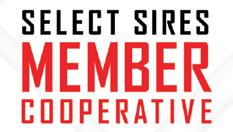


Dairy Star • Saturday, May 11, 2024 • Page 35 Phone: (320) 259-6680 Web: www.cobaselect.com Contact your SSMC representative today to protect your herd’s health and your bottom line! YOUNG SIRES HHP$CM$CFP 7HO16962 OH-MY* 1,4001,391219 14HO17156 PITCHFORK 1,3901,173196 7HO16276 SHEEPSTER* 1,3711,224214 14HO17012 CLEARVIEW* 1,3681,320205 14HO16860 RODNEY 1,3651,212188 14HO16836 DRYDON 1,3531,224183 7HO17161 MOODLE 1,3491,261184 7HO16735 KARL* 1,3471,300199 14HO16871 PETE 1,3441,212180 7HO16916 STEPHAN 1,3411,249165 YOUNG SIRES CONTINUEDHHP$CM$CFP 7HO15977 HAYK 1,3411,100172 7HO16966 SANBORN 1,3391,191193 7HO17045 TALLET 1,3341,335193 7HO17095 JACKHAMMER* 1,3301,288213 7HO16932 PROVEN FULL 1,3301,228178 14HO16673 ENDEAR 1,3301,254195 14HO17023 FOUGHTY* 1,3201,256193 7HO16485 SUNDANCE* 1,3151,234159 7HO16866 HUMO* 1,3121,272202 7HO17131 HADES 1,3071,228188 * Identifies NxGEN sires. 04/24 CDCB-S Genomic Evaluations. HHP$, Herd Health Profit Dollars and NxGEN are registered trademarks of Select Sires Inc., Plain City, OH. TALLET is MW. Photo by Farmgirl Photography. 7 = Select Sires, 14 = Accelerated Genetics
Read, grow
It struck me this past weekend as I was crawling around in my garden trying to spot new life (that wasn’t a weed) that I had forgotten to write about how our wild garden plans came out last summer. I had always thought it would be fun to have book-themed gardens, and at a friend’s prompting, we made it happen. What follows are the books we chose and the things we used to bring them to life.
“Miss Rumphius” by Barbara Cooney. Cooney’s words and illustrations take you across the world and back again to Maine as a little girl named Alice tries to heed her grandfather’s advice. As a young girl, sitting on his knee, he tells her she must do something to make the world more beautiful. She grows up and nds her way to make the world more beautiful: lupines. At the entrance of our garden, there is an arbor, and to the right, if one looks intently, you can see many lupines beginning to grow. I have lighthouse birdhouses and a buoy from Maine to place among the plants, and the homage to the coast of Maine is complete.
“Miss Nelson is Missing” by Harry Allard Jr. and il-
lustrated by James Marshall. Poor, sweet Miss Nelson is not respected by her students. When she is absent, their substitute is the wicked Miss Viola Swamp. We rescued a bookshelf from the side of the road, tipped it on its back and lled it with dirt. It became part of our story garden. An old desk with the top removed was lled with succulents. The book case held vegetables, owers and our book bricks. I painted a paver to resemble the title of each of our books and welcome people to the garden. The crowning glory was a scarecrow with a pink dress on one side and a dark black dress on the other to symbolize the two teachers.
“The Tale of Peter Rabbit” by Beatrix Potter. My mom adored all things Potter and made a Peter Rabbit garden eons ago. For Cora and I, it was a great place to put a cement rabbit and grow lettuce, spinach, cabbages and, of course, carrots. We put a white picket fence section up and hung a sprinkling can on it. Cora found a cement rabbit and snuck it inside. As you know, Peter Rabbit was quite tricky about where he hid from Mr. McGregor. We even made a miniature scarecrow with a blue shirt and shoes like the
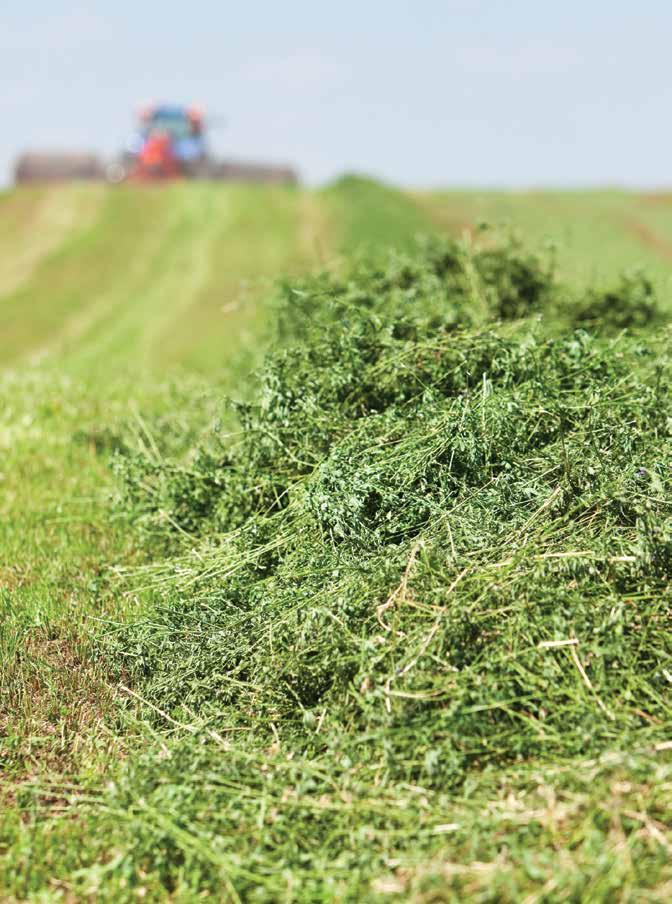
story.
“Tops & Bottoms” by Janet Stevens. Oh, poor lazy Bear. He gets outwitted by an ambitious family of rabbits, but it teaches him a lesson. This book is a must-read for little ones to inadvertently teach them about what parts of the plant you eat and such fun to plant a garden spot with. We put a stuffed bear in a porch swing replica bird feeder and found another rabbit to place among the radishes, lettuce, cauliower and broccoli.






















BULLETPROOF® Forage Preservatives enhances fermentation through the addition of sulfur-containing antioxidants, enzymes and sugar sources. This unique combination of ingredients allows for a more rapid and efficient fermentation by the lactic acid producing bacteria that are naturally present on the forage.

“Chicks and Salsa” by Aaron Reynolds. Mrs. Nuthatcher was watching cooking shows in the afternoons, and the wily rooster was learning a thing or too as well. He and his ock were sick of chicken feed and decided that salsa was the way to go. The chickens sneak into the well-stocked garden and pilfer their needed ingredients. Then, the ducks and pigs decide they should follow suit and make guacamole and nachos. This book has cracked up my kids up for years and was the perfect t to plant tomatoes, onions and peppers.



“The Princess and the Pea.” This book has been retold so many times I’m not sure it has one author. When Cora and I were scouring the sides of the road for garden art supplies, a bed spring jumped out at us. We tied it vertically to fence posts, and then, Cora weaved scraps of fabric through it horizontally to show the multitude of mattresses the princess had to sleep upon. I bet you can guess what we planted next to it: peas, of course. The bed spring was the perfect trellis for our snap peas.
“Sunower House” by Eve Bunting. If you get brave enough to try any book in your garden this summer, try this one. If you have kids, grandkids or neighbor kids who wander over to explore your dirt patch, do this. In the book, the family plants sunowers in a circle, leaving the center spot open for imagination. We had strips of landscape fabric dividing up each story garden. We had one lead to the sunower house. It had an opening on one side and a double wall of sunowers the rest of the way around it. It was fantastic. We put rugs in the center and a small table and chairs found at a rummage sale, and it became Cora’s spot for tea breaks in the heat of summer.
“Tractor Mac Worth the Wait” by Billy Steers. This was Henry’s pick. The pigs feel so bad about eating all the watermelons that they nurture one growing in their pen just for the farmer. Henry was so excited to plant watermelons to show this story. We put up a pig panel, found a pair of pig salt and pepper shakers, and plopped them in a planter of hens and chicks.
“Waiting for Wings” by Lois Ehlert. Cora has a ower garden on the lawn and delights in nding butteries sipping from the blooms. We grabbed this book off the shelf and made it a goal to plant every ower the Wisconsin author listed as being a buttery magnet. The day we walked out and found a monarch caterpillar on her milkweed was pure magic.
“Pumpkin Moonshine” by Tasha Tudor. Little Sylvie Ann goes up on the hill to pick her pumpkin for carving, and among the cornstalks and bean plants, she nds her pumpkin moonshine. It was our rst attempt at planting the Three Sisters, corn, beans and pumpkins, and denitely an adventure.
As you plan your garden this summer, get creative. Maybe you can nd books to make it come to life.
Jacqui Davison and her family milk 800 cows and farm 1,200 acres in northeastern Vernon County, Wisconsin. Her children, Ira, Dane, Henry and Cora, help on the farm while her husband, Keith, works on a grain farm. If she’s not in the barn, she’s probably in the kitchen, trailing after little ones or sharing her passion of reading with someone. Her life is best described as organized chaos, and if it wasn’t, she’d be bored.






Page 36 • Dairy Star • Saturday, May 11, 2024
Blue Hilltop, Inc. Dana Berreau 507-879-3593 / 800-821-7092 Box 116, Lake Wilson, MN 56151 Your Mixer, Spreader, Hay Processor Headquarters We carry:
THE FORAGE SHIELD Protect your forage quality.
By Jacqui Davison Columnist
Ramblings from the Ridge
Mastitis in 1918
I was doing housecleaning the other day and revisited an old book that my brother gave me years ago.
It was published in 1918 with this rather long title: “Farm knowledge: A complete manual of successful farming written by recognized authorities in all parts of the country: Based on sound principles and the actual experience of real farmers — ‘The farmer’s own cyclopedia.’”
Veterinary Wisdom
 By Jim Bennett Columnist
By Jim Bennett Columnist
The title page said, “Prepared exclusively for Sears, Roebuck and Co.”
More seasoned readers of this article may remember that Sears was the Amazon of the old times. One could get almost anything from them, from small things like chicks to larger things like a house. Being a veterinarian, I started paging through the chapter on animal health, and since I have been working on a paper about mastitis, I decided to see if there was any wisdom regarding mastitis in dairy cows.
From Section 31: “The udder becomes swollen, red, hot and tender, and the milk becomes a pale yellow, whey-like or blood-tinged uid (serum) containing clots or cures. Fever and loss of appetite are rare. There may be some stiffness in walking. Mild attacks tend to subside in six to eight days.”
That is a nice job describing clinical, grade 1 or grade 2 mastitis. Not much has changed here in the last 106 years.
Treatments however, have changed.
The book said, “Give 12-18 ounces Epsom or Glauber’s salts and 1 pint of linseed oil in 3 pints of warm water. Give a heifer one-half ounce of uid extract of poke root and 2 drams of powdered saltpeter … in water twice daily as a drench or otherwise. Every two hours, bathe the udder with hot water, massage well and strip away the milk. Hot poultices of oatmeal, axseed meal and bran or spent hops may be used instead of hot water fomentations. If the udder is very large, support it with a wide bandage around the body.
Rub the udder thoroughly three times daily with a mixture of one part each of turpentine and uid extracts of poke root and belladonna leaves and ve parts of warm melted lard, sweet oil, lard oil or lanolin.”
Wow, that is a lot. Let’s translate.
Glauber’s salt, or Mirabilite, is anhydrous sodium sulfate. It has been used as a purgative laxative and anti-inammatory medicine. Flaxseed oil is a source of omega-3 fatty acids, which, if taken regularly, have been claimed to help with cardiovascular health. It is also advocated as an anti-inammatory agent and laxative.
Poke root, or poke weed, has been used to treat all sorts of conditions in herbal medicine, including mastitis in people. It is, however, toxic; though, one-half ounce of uid extract to a 1,000-pound animal probably did little harm.
Saltpeter, or potassium nitrate, in addition to being an ingredient in gunpowder has been used in herbal medicine. Purportedly, it has antibacterial activity but also causes smooth muscle relaxation, most notably in blood vessels.
Belladonna, or deadly nightshade, also has been used for herbal remedies. It contains the drugs atropine and scopolamine, which are used to regulate heart rate. It is extremely toxic. The seed meal poultices were used to try to reduce swelling of the udder as was the hot water.
More from the book, this time from Section 32 regarding acute mastitis: “May come on at once. Most cases are caused by germs which enter the udder through the blood or lymph circulations, the milk ducts or wounds. It may also come from contaminated oors, other affected cattle, their milk or their vaginal discharges; and it is often carried by the milkers’ hands. Symptoms include chill followed by fever; loss of appetite and cessation of cud chewing; hot, doughy swelling of the abdominal wall and pus-like, clotty milk which may have a foil odor; abscesses, which may form and discharge pus by the glands. Quarters are permanently ruined for milk secretion unless prompt, thorough treatment checks and cures the attack, which rarely happens.”
This sounds a lot like acute, toxic mastitis. Today, farmers often assume that these symptoms come only with coliform infections, but that is not necessarily true

as many other organisms can cause similar attacks.
The recommended treatments make up a pretty long list including, “hot drinks of tea, coffee or axseed tea sweetened with molasses … essence of ginger and half a cupful of whiskey or brandy. For fever, give in water 10 drops tincture of aconite and 10 drops uid extract of belladonna.”
Treatment also included saltpeter, iodide of potash and a variety of poultice preparations. The nal treatment is to “cut off a portion of the teat or slit it open to allow free drainage and fatten the cow for the butcher.”
There is also a section on contagious mastitis where it states that it is “caused by germs, notably those called streptococci. … The milk becomes infective and dangerous for people and animals.”
Mastitis has been around since there have been cows. Even in 1918, it was recognized that at least some forms of mastitis were caused by microorganisms, and some of the streptococci were contagious. We might laugh at the treatments recommended back then, but I suspect the same will be true of our treatments in another 106 years. Farmers at that time also knew that sometimes there was no satisfactory solution except to fatten up for the butcher.
Jim Bennett is one of four dairy veterinarians at Northern Valley Dairy Production Medicine Center in Plainview, Minnesota. He consults on dairy farms in other states. He and his wife, Pam, have four children. Jim can be reached at bennettnvac@gmail.com.









JD 9600 2022, Kernel Processor, PRWD, 663 hrs., 507 CH hrs., #576032 ........... $499,900






JD 9600 2021, Kernel Processor, PRWD, 892 hrs., 538 CH hrs., #565399 ........... $420,000
JD 9600 2020, Kernel Processor, PRWD, 1310 hrs., 775 CH hrs., #565393 .........
9600 2019, Kernel Processor, PRWD, 1311 hrs., 811 CH hrs., #532049
9600 2019, Kernel
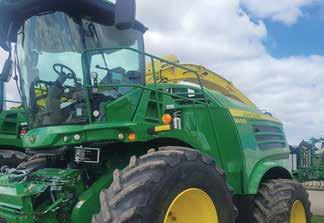




Dairy Star • Saturday, May 11, 2024 • Page 37
Flexible financing or cash discounts on Spfh’s & hay tools Locations throughout minnesota & western wisconsin! CALL TODAY! (320)352-6511 SEE OUR COMPLETE INVENTORY WITH PICTURES AND DESCRIPTIONS AT: www.mmcjd.com 2021 John Deere 9700 831 hrs., #571817 $479,900 2022 John Deere 9600 663 hrs., # 576032 $499,900 2021 John Deere 8400 527 hrs., #574593 $441,000 SELF-PROPELLED FORAGE HARVESTERS JD 6810 1993, Kernel Processor, PRWD, 5314 hrs., 3524 CH hrs., #579404 ......... $30,000 JD 6850 2002 Kernel Processor PRWD, 4541 hrs, 3260 CH hrs, #581227 ............ $54,500 JD 7550 2010, Kernel Processor, PRWD, 2778 hrs., 1896 CH hrs., #579487 ....... $146,500 JD 7750 2008, Kernel Processor, 4691 hrs., 2991 CH hrs., #568793 .................... $89,500 JD 8400 2023, Kernel Processor, PRWD, 26 hrs., #560608 ................................ $531,000 JD 8400 2021, Kernel Processor, PRWD, 527 hrs., 317 CH hrs., #574593 ........... $441,000 JD 8600 2016, Kernel Processor, PRWD, 1610 hrs., 1200 CH hrs., #555841 ....... $235,900 JD 9500 2022, Kernel Processor, PRWD, 613 hrs., 317 CH hrs., #565391 ........... $505,900
$375,000 JD
$369,900 JD
Processor, PRWD, 1741 hrs., 1130 CH hrs., #553763 ....... $329,900 JD
2021, Kernel Processor, PRWD, 831 hrs., 527 CH hrs., #571817 ........... $479,900 JD
2021, Kernel Processor, PRWD, 1201 hrs., 900 CH hrs., #579477 ......... $454,900 JD 9700 2020, Kernel Processor, PRWD, 968 hrs., 500 CH hrs., #552460 ........... $469,900 JD 9700 2020, Kernel Processor, PRWD, 1170 hrs., 835 CH hrs., #543646 ......... $439,900 JD 9800 2022, Kernel Processor, PRWD, 565 hrs., 375 CH hrs., #572207 ........... $575,000 JD 9800 2021, Kernel Processor, PRWD, 579 hrs., 302 CH hrs., #550106 ........... $518,000 JD 9800 2021, Kernel Processor, PRWD, 628 hrs., 369 CH hrs., #552624 ........... $509,900 JD 9800 2020, Kernel Processor, PRWD, 1333 hrs., 859 CH hrs., #536344 ......... $429,900 JD 9800 2020, Kernel Processor, PRWD, 1538 hrs., 942 CH hrs., #554135 ......... $389,900 JD 9800 2019, Kernel Processor, PRWD, 1063 hrs., 660 CH hrs., #550175 ......... $439,900 JD 9900 2022, Kernel Processor, PRWD, 746 hrs., 330 CH hrs., #565395 ........... $595,000 JD 9900 2022, Kernel Processor, PRWD, 2000 hrs., 1500 CH hrs., #574301 ....... $349,900 JD 9900 2021, Kernel Processor, PRWD, 1057 hrs., 675 CH hrs., #565397 ......... $509,900 JD 9900 2021, Kernel Processor, PRWD, 1353 hrs., 990 CH hrs., #573149 ......... $409,900 JD 9900 2019, Kernel Processor, PRWD, 1397 hrs., 884 CH hrs., #550177 ......... $399,900
.........
9700
9700
BEST FOOTING CONCRETE GROOVING Prevent costly falls before they occur Strum, WI 715-579-0531 www.bestfootingconcretegrooving.com We offer grooving & scarifying!
Wedding season
It’s wedding season. I honestly have no idea if there’s actually a dened best time for weddings when you’d be most likely invited to attend one. I was going to Google it when my wife walked by and said June is the peak wedding season because of the availability of pretty owers. I decided based on advice I’ve heard at many weddings that I shouldn’t argue with my wife about any matter relating to weddings, so that became the title of this month’s article.
This last weekend, I traveled to Atlanta, Georgia, for a friend’s wedding. We don’t get invited to many weddings nowadays, as we’re in our 40s. Most of our friends and close family are already married, and their kids are not quite to that age yet.
and farming together. I don’t remember her agreeing to that kind of thing in our vows.
I booked my plane ticket a month ago when I decided they probably weren’t going to get any cheaper and all the employees didn’t simultaneously put in for that weekend off. I had never own Spirit Airlines Inc. before, but it seemed like I might as well as I didn’t need more than a change of clothes that would t in a small bag to be in a city for only 48 hours. Their luggage fees didn’t matter much. It didn’t hurt that they were a third of the price of Delta Air Lines Inc. even if I had needed to check a bag.

I was pretty excited to go to the wedding. There aren’t many opportunities to get together with a bunch of my college friends at the same time in the same place with everyone so busy with children and jobs.
By Tim Zweber Farmer & Columnist
This was one of those opportunities, as the guy getting married was a college fraternity brother of mine. Even though the wedding required a ight or full day of driving to get there, there were sure to be more than a few guys going. Unfortunately, it’s also baby season in my family with my sister and sisterin-law both due to have babies the same weekend as the date on the wedding invitation. That meant Emily and I couldn’t attend the wedding together as my parents wanted to help by watching our nephew while my sister was having the baby. Someone needs to run the farm, and Emily offered to be that person so I could take a weekend off in Atlanta. Apparently, Emily loves me even after nearly 20 years of marriage










It turned out ying Spirit Airlines was a great experience for the most part but booking the cheapest rental car wasn’t. I had to wait three hours until Thrifty Car Rental had a car returned so I could use it. They considerably oversold cars that weekend so that a whole line of people had to wait hours to get a car. Eventually, I got a car and found my way through the heart of Atlanta during rush hour trafc to have dinner with a friend and his wife.
The wedding the next day was beautiful, and I’d like to wish the newly married Mr. and Mrs. Olson a long and happy marriage. There was a sizable turnout of college friends there, and it was great catching up with them. Looking back on my college years, I learned useful knowledge there, but some of the most valuable things I walked away from the University of Minnesota with were the friendships I formed. Even though I hadn’t seen some of my college friends in quite a while, we were back to chatting with each other about life, family and agriculture — the same as we did in college. There was a lot more talk of children
than there was in those days, but otherwise, it had the same vibe.
Until next time, keep living the dream, and don’t forget to check how you’re expected to dress before you pack to head to a wedding. You may leave behind an important coat and have to debate running to Goodwill in the morning before the ceremony.
Tim Zweber farms with his wife, Emily, their three children and his parents, Jon and Lisa, near Elko, Minnesota.















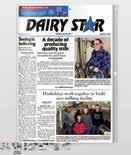


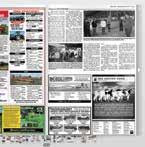












Page 38 • Dairy Star • Saturday, May 11, 2024
From the Zweber Farm *Offer subject to change. Available on select GEHL skid/track loader models. See dealer for details. Scan to Learn More! 0% 36 FORMO. OR UP TO $2500 CASHBACK GEHL WORKS FOR YOU ON ALL NEW SKID STEERS & CTLS* WORKS LIKE YOU ™ GHL_Destocking_SSL_CTL_0for36_CEG_HP4C_FINAL.indd 1 CALL YOUR LOCAL GEHL DEALER TODAY! MINNESOTA Mid-Central Equipment Henning, MN Northland Farm Systems Inc. Owatonna, MN IOWA Reiser Implement Waukon, IA Mark’s Tractor & Implement Osage & Dumont, IA SOUTH DAKOTA Lake County International Madison, SD WISCONSIN D&D Equipment Chilton,WI Lindstrom Equipment Mondovi & Menomonie,WI Luxemburg Motor Company Luxemburg, WI
E-EDITION Read the Dairy Star iry Star online FREE at www.dairystar.com
Bees: Agriculture’s backbone
Spring is perhaps our favorite season on the farm. After the long doldrums of winter, most northerners can attest to the anticipation and excitement that accompanies spring. There is much to be done during this season of planning and preparation. To say farmers are “busy as bees” is correctly put.
One of the most anticipated tasks of our spring season is beekeeping. We have been beekeeping for the last decade, and to tell the truth, it is quite an adventure. If you know anything about bees, they are fascinating.
We keep three to four hives on the farm. The bees are not only producing delicious honey, but they also pollinate our elds, grasslands, and market vegetable and ower gardens. We’ve learned so much about beekeeping; each new season is a new adventure.
Bees work together to nd the best sources of nectar and communicate that information with a specic dance.
The NexGen: Adventures of two dairy daughters
There are two specic dances that a worker bee will perform. The “waggle” dance is performed at the opening of the hive, where bees are coming and going to quickly communicate the source of the nectar to foragers leaving the hive.

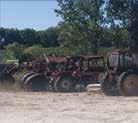

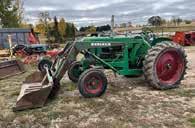

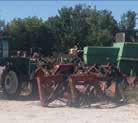






The longer the dance, the further the distance to the nectar source. The more vigorous the dance, the richer the source. Also, and this is the most incredible part, the angle of the dance, deviating from an imaginary line drawn from the sun, will direct the bees to where the mother lode is located.
A second dance is also performed, the “shake,” when the nectar source is so rich that more foragers are needed. A returning worker bee will perform this dance inside the hive in front of non-foraging workers to tell them a rich source has been found and they need to venture out and help haul in the load. We’ve seen this rsthand, and it is incredible.
Watching a bee’s precise and coordinated dance, communicating the location of the nectar to other bees in the hive, is captivating. It is also amazing to witness how well it works.
Several years ago, on a beautiful day, Ellen left her newly extracted frames in the back of her Gator parked in her open garage, not thinking anything of it. What started as a bee ying here and there throughout the yard and garden on a lovely day quickly became Interstate 94, heading north, on the Fourth of July. Hundreds of thousands of bees were ying in, covering the frames, taking every tiny little bit of honey off the frames and hauling it back to the hive. Her garage was like the Minnesota State Fair on a sunny Saturday, gridlocked and humming. We could hear the bees buzzing from across the yard in the house. Nothing was to be done until later that evening, when the bees had settled down and she could drive the Gator and frames out of the yard to let the remaining bees nish the process. Several days later, the frames were as good as new, scoured immaculately clean, and the bees had collected every morsel of honey off of them.
Another fascinating fact is that the area from which the bees harvest affects the color and avor of the honey. Bees travel in about a 2-mile radius from the hive but will venture up to 5 miles to collect nectar. To make 1 pound of honey, bees must y about 55,000 miles and tap about 5 million owers, according to the U.S. Department of Agriculture. Our bees feast on a mix of basswood, alfalfa and clover. The resulting honey is a light, golden color with a very mild, sweet taste. A beekeeping friend of the family places his apiary in North Dakota close to a buckwheat eld each year. The resulting honey from those hives is almost black. It has a robust and rich avor with notes of molasses and malt.
Bees are critical to our success in agriculture. According to the USDA, they pollinate upward of $15 billion worth of crops each year. Many commercial beekeepers move their hives from Minnesota, South Dakota and North Dakota in the summer season to the mild climate of California’s almond farms or Washington’s apple orchards in the winter before they return. They are a critical component in the pollination of fruits, vegetables, seeds and nuts. One-third of the food we consume as Americans is derived from crops pollinated by bees.
On our farm, the bees are critical to the pollination of our elds, fruit trees and market gardens. They also produce delicious honey, which we sell at our summer farm market. As the spring season draws to a close, we continue through our Minnesota seasons to summer where you’ll nd us farming — in the barn, garden and market — also busy as bees.
Megan Schrupp and Ellen Stenger are sisters and co-owners of both NexGen Dairy and NexGen Market in Eden Valley, Minnesota. They can be reached at Nexgendairy@gmail.com.



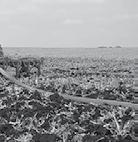

Dairy Star • Saturday, May 11, 2024 • Page 39 THAT'S THE HIXWOOD DIFFERENCE Quality craftsmanship. Outstanding service. Find the right post-frame solution for your business or operation from Hixwood. Give us a call or visit us online today. 715-644-0765 | HIXWOOD.COM N6503 Pit Road Mount Calvary, WI, 53057 920-922-9966 americanimplement920@gmail.com IMPLEMENT INC White 2-135, duals, front weight - Call for Pricing WE BUY SCRAP METAL! Oliver Super 77 3,372 hours - $4,000 USED PARTS AVAILABLE! Glenco soil finisher Call for price www.dhfieldservices.com D&HFIELD SERVICES, INC . Darrin Herickhoff 320-760-0848 • Liquid Manure Handling • Solid Manure Handling • Trucking • Pushing & Packing CLASSIFIED Doesn’t Always Mean Top Secret! It’s no secret that a Dairy Star classied ad can help you eliminate those unwanted items! Call 320-352-6303 or e-mail nancy.p@dairystar.com
By Megan Schrupp & Ellen Stenger Columnists



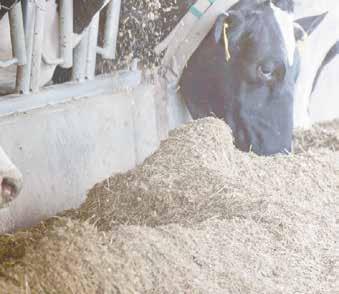
CowScout™ has improved our pregnancy rate by 7%
“CowScout pays for itself. We’re improving reproduction and finding health issues sooner, before they escalate into something more severesaving treatment costs and lost production while saving labor and being more efficient with our time. CowScout is one of the best investments we’ve made.”





Contact Your Local GEA Milking Equipment Dealer:
Central Ag Supply, Inc.
Central Ag Supply, Inc.
Juneau, WI • 920-386-2611
Baraboo, WI • 608-356-8384
Centre Dairy Equipment and Supply Inc.
Centre Dairy Equipment and Supply, Inc.
Sauk Centre, MN
Sauk Centre, MN
320-352-5762 • 800-342-2697
Eastern Iowa Dairy Systems
Eastern Iowa Dairy Systems
Epworth, IA • (563) 876-3087
Five Star Supply
Fuller’s Milker Center, LLC
Lancaster, WI • 608-723-4634
J Gile Dairy Equipment, Inc.
Leedstone, Inc.
Melrose, MN
Leedstone, Inc.
320-256-3303 • 800-996-3303
Glencoe, MN
320-864-5575 • 877-864-5575
Plainview, MN • 800-548-5240
Menomonie, WI • 715-231-8090
Midwest Livestock Systems
Midwest Livestock Systems, LLC
Zumbrota, MN • 800-233-8937
Menomonie, WI • 715-235-5144
Renner, SD • 800-705-1447






Fuller’s Milker Center, Inc.
Richland Center, WI • 608-347-4488
J Gile Dairy Equipment, Inc.
Cuba City, WI • 608-744-2661
Midwest Livestock SystemsKozlovsky Dairy Equipment
Kaukauna, WI • 920-759-9223
Weston, WI • 715-298-6256
Monroe WestfaliaSurge Monroe, WI • 608-325-2772
Monroe Westfalia Surge

Sioux Dairy Equipment, Inc.
Rock Valley, IA
Preston Dairy Equipment Sparta, WI • 608-269-3830
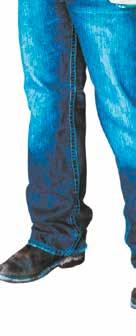
Sioux Dairy Equipment, Inc. Rock Valley, IA 712-476-5608 • 800-962-4346
Colton, SD Service • 800-944-1217
Stanley Schmitz, Inc.
Edgerton, MN Chemical Sales 507-920-8626
Tri-County Dairy Supply
Stanley Schmitz, Inc.
Chilton, WI • 920-849-4209
Preston Dairy Equipment
Tri-County Dairy Supply Janesville, WI • 608-757-2697

Page 40 • Dairy Star • Saturday, May 11, 2024
BENJAMIN WUEBKERS
GEA.com/DairyFarming
Malecha Dairy Villard, MN Milking 1,070 cows
CONCEPTION RATE MISSED HEATS

















































































































































 By Don Wick Columnist Ag Insider
By Don Wick Columnist Ag Insider










































































































































































































































































































































































 By Scott Wells, College of Veterinary Medicine, University of Minnesota
By Scott Wells, College of Veterinary Medicine, University of Minnesota


































































 By Sarah Middendorf Staff Writer
By Sarah Middendorf Staff Writer







 By Tina Hinchley Farmer & Columnist
By Tina Hinchley Farmer & Columnist




































 By Jim Bennett Columnist
By Jim Bennett Columnist































































